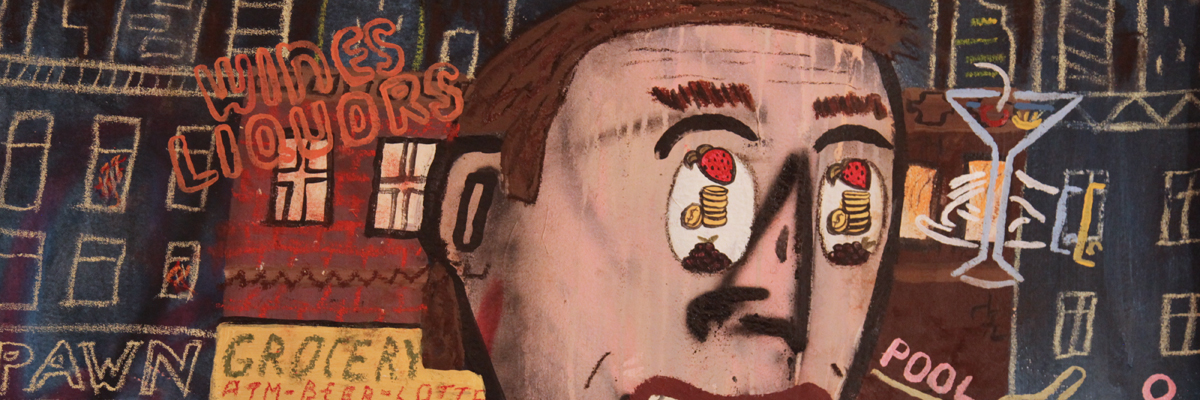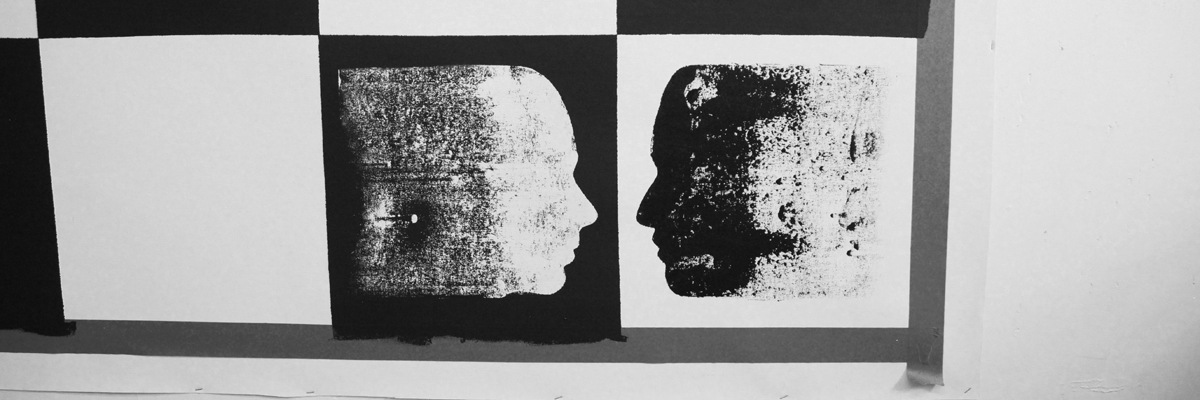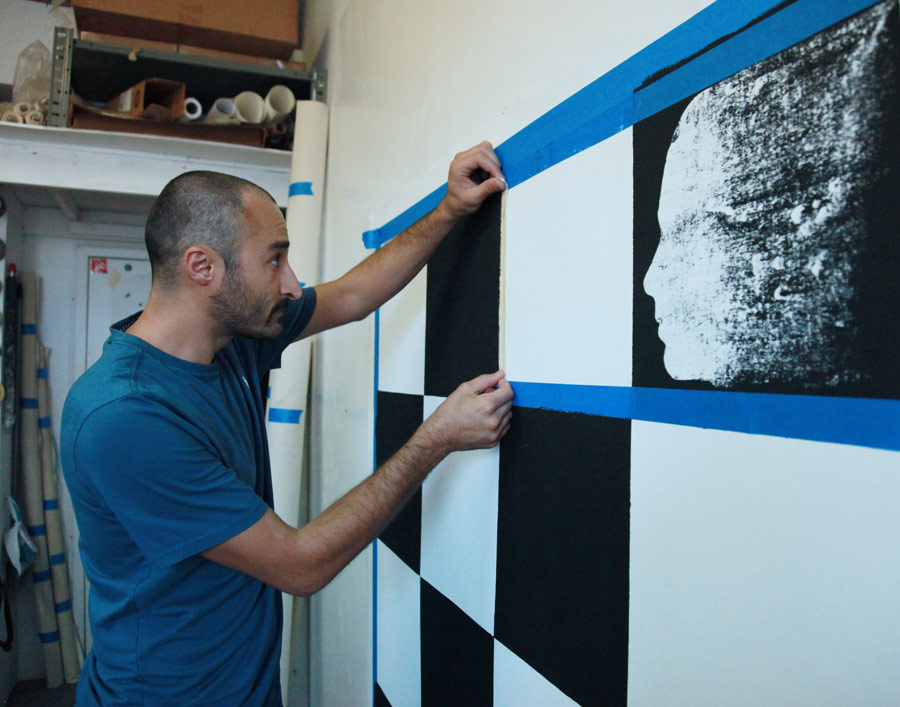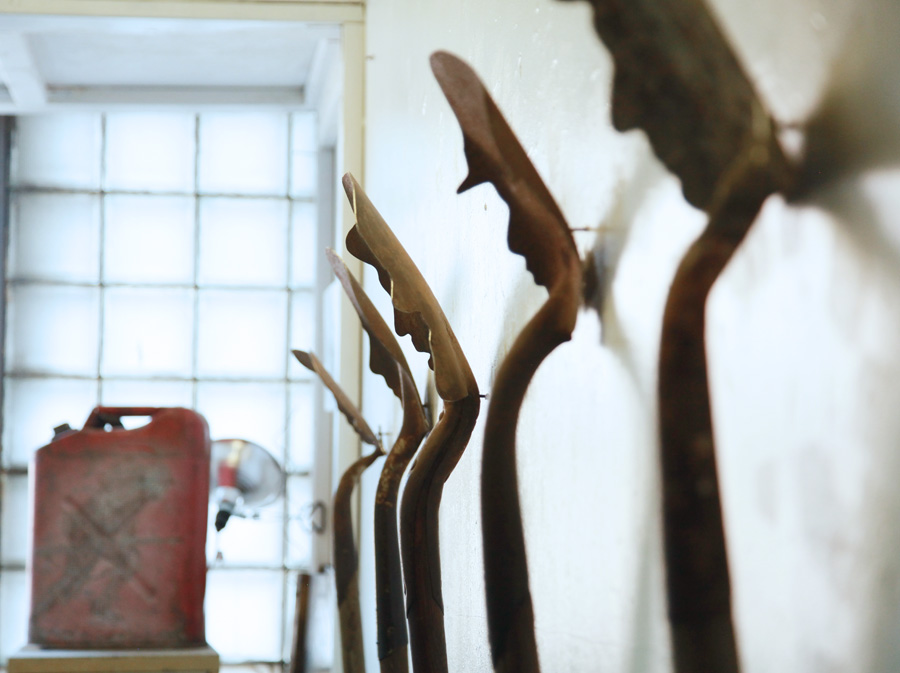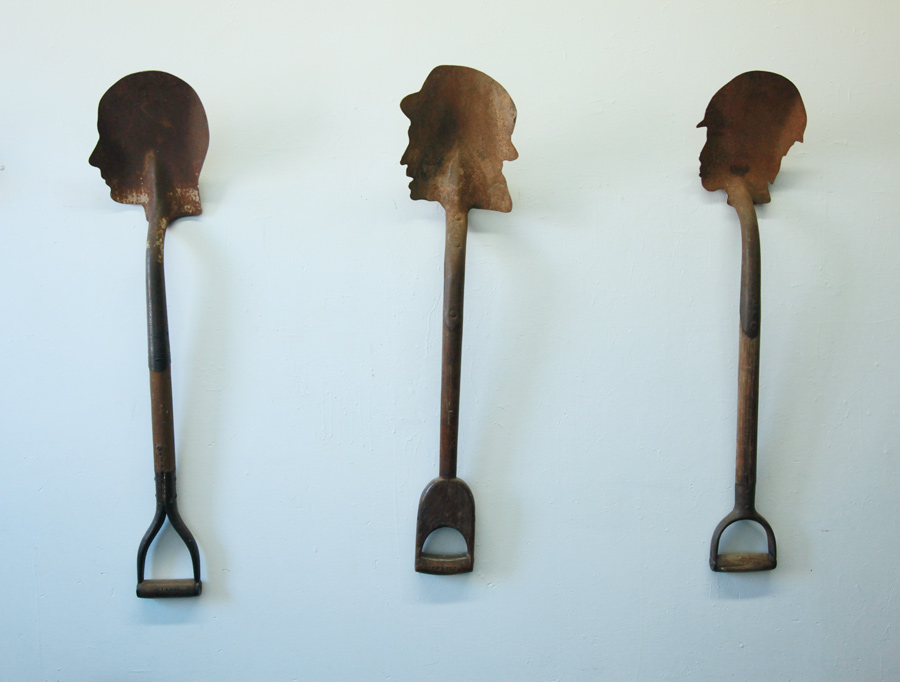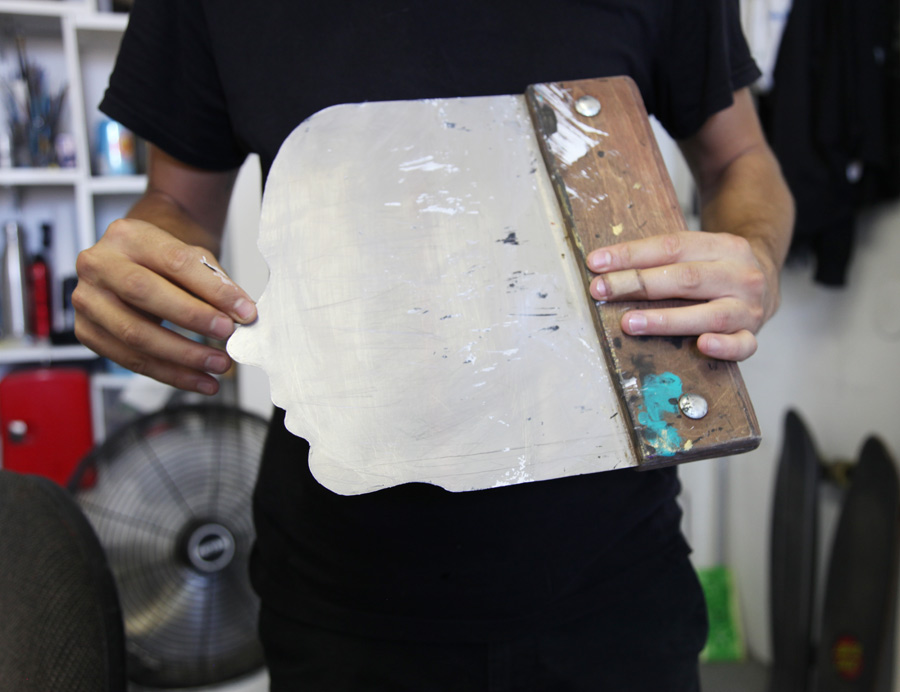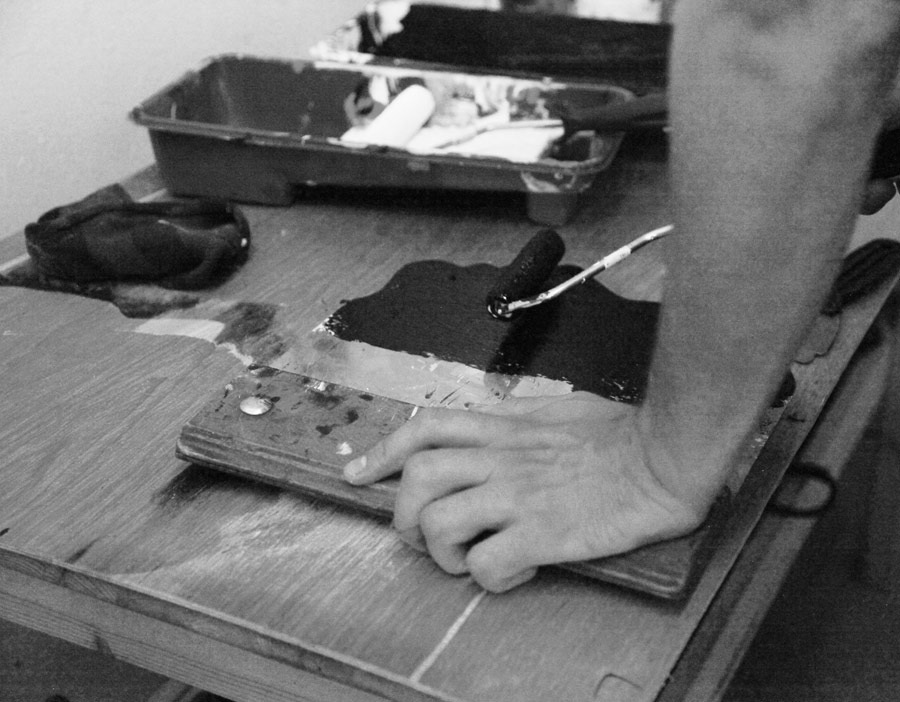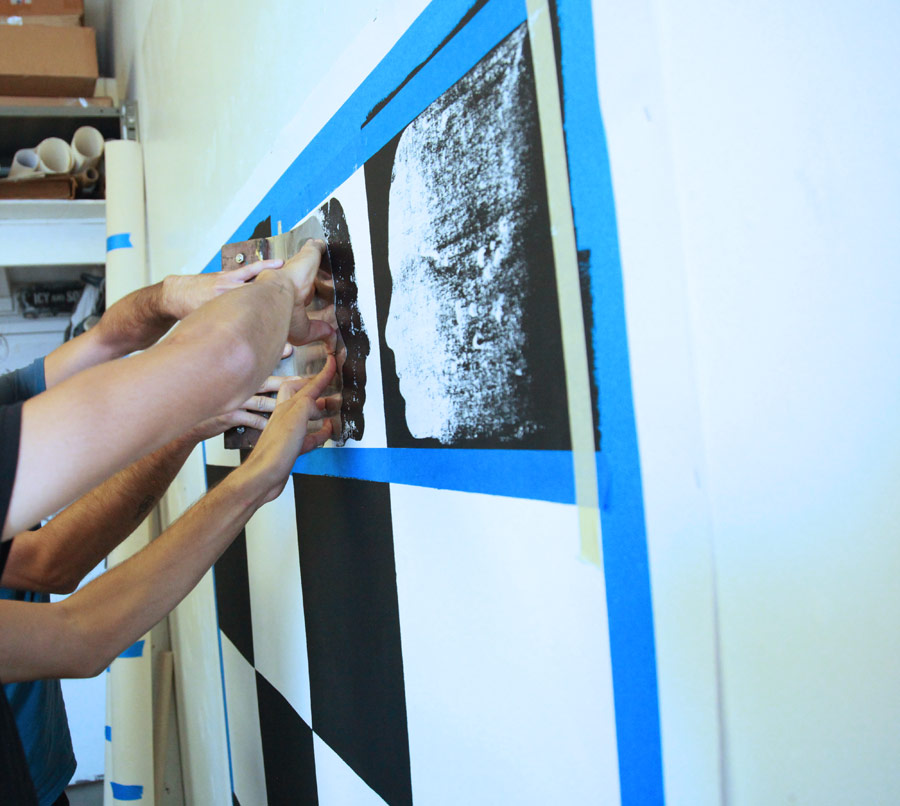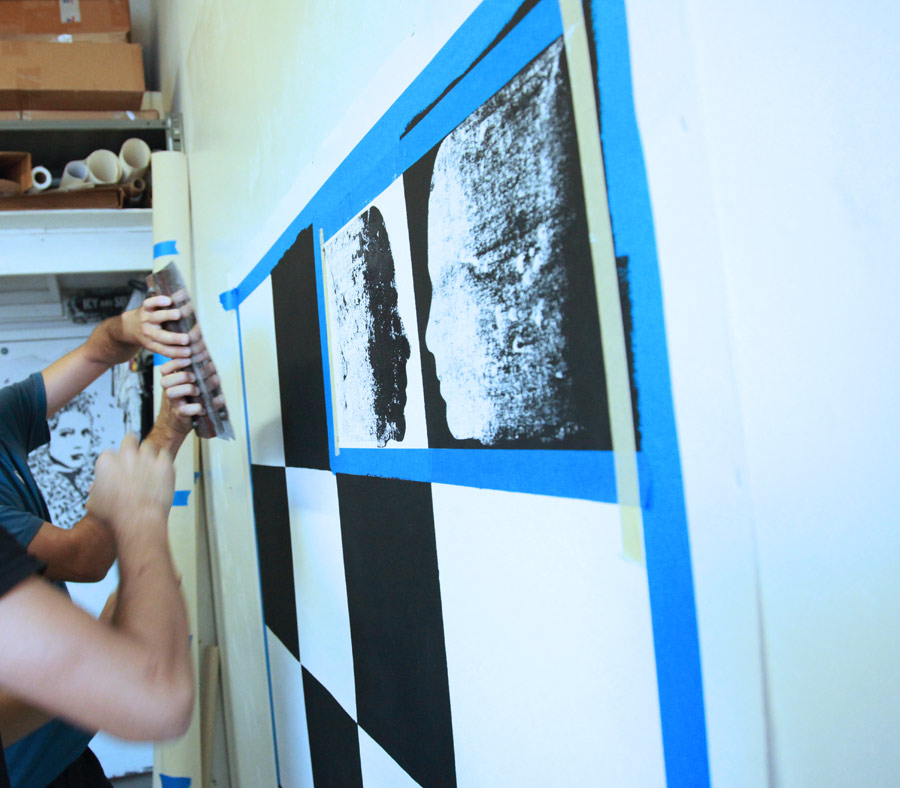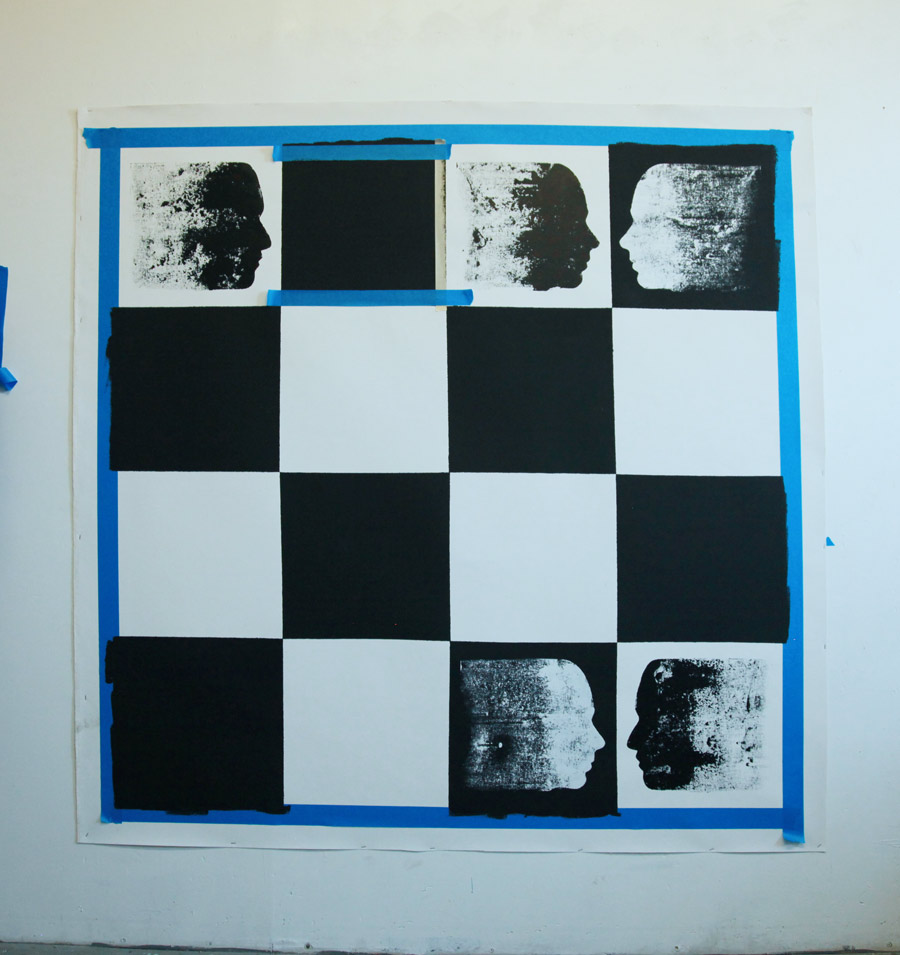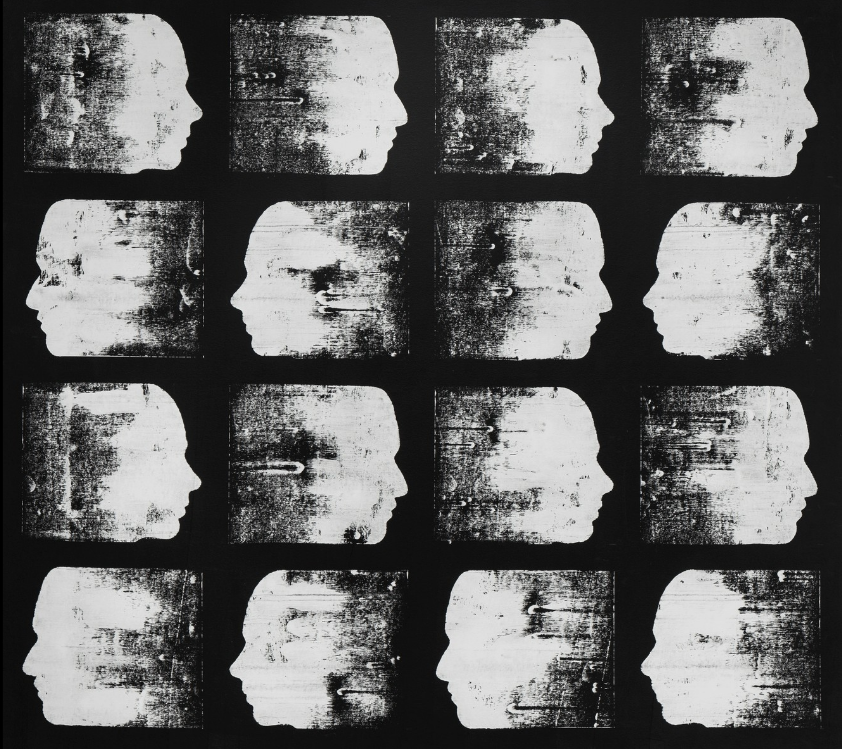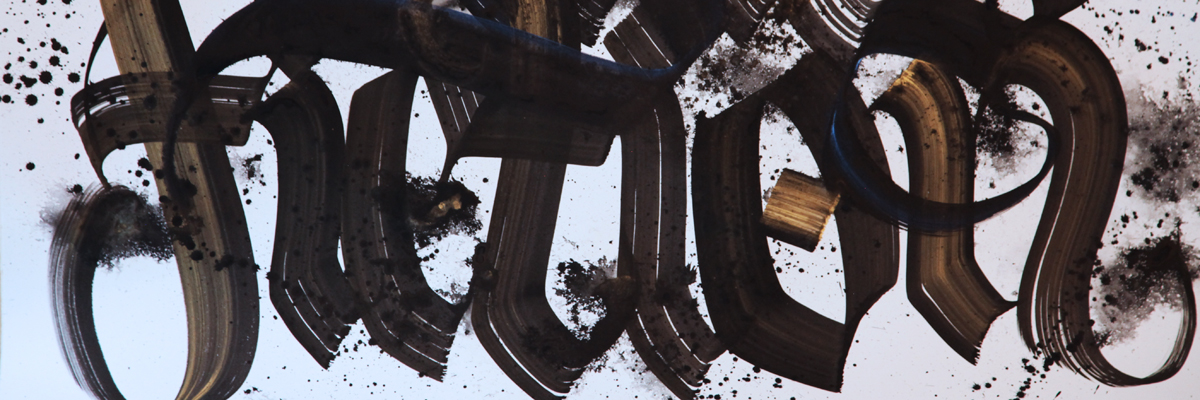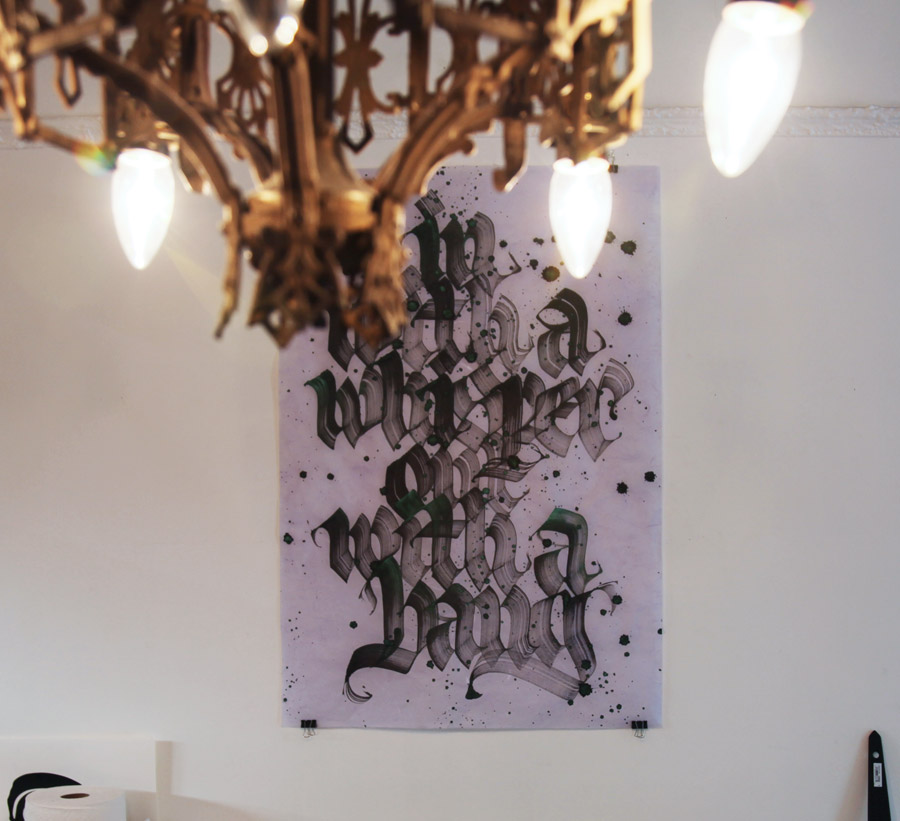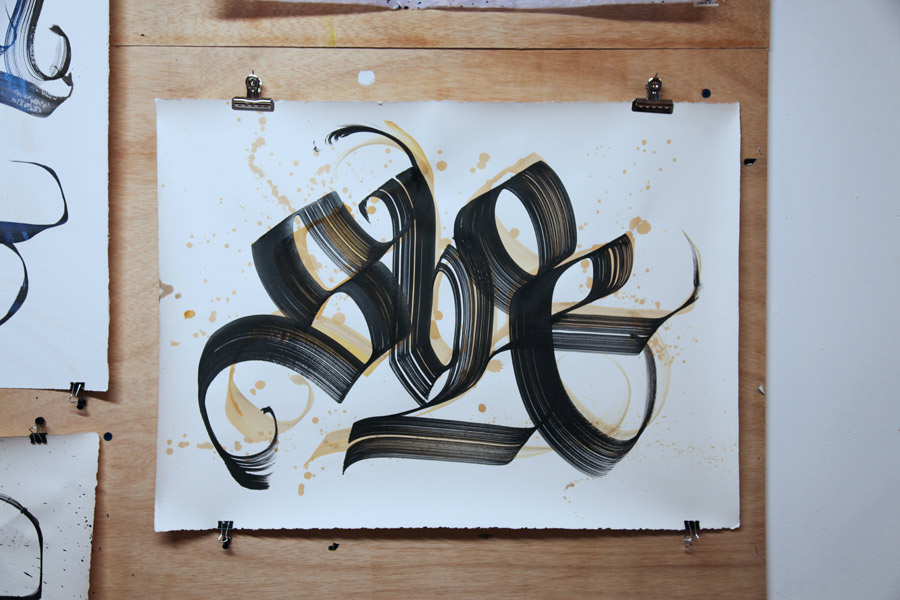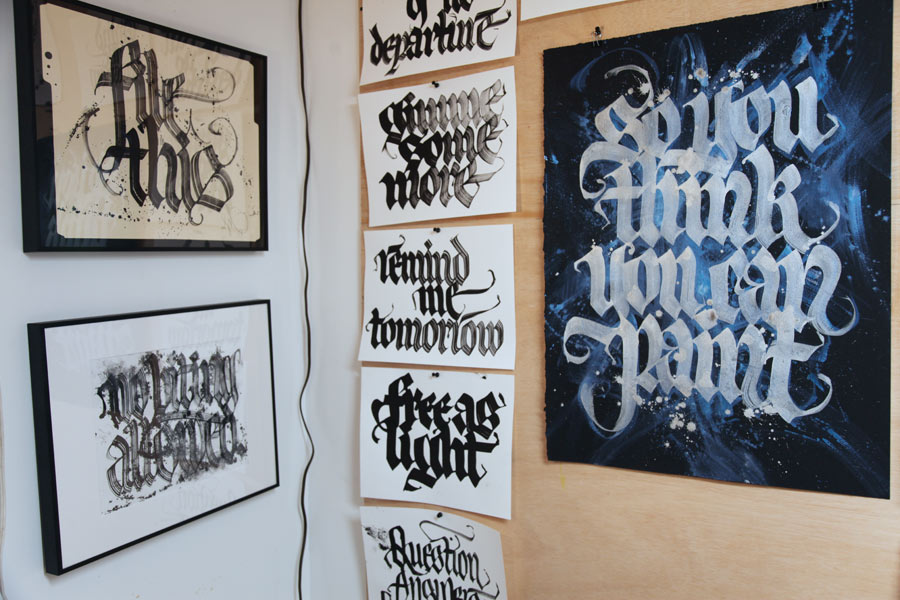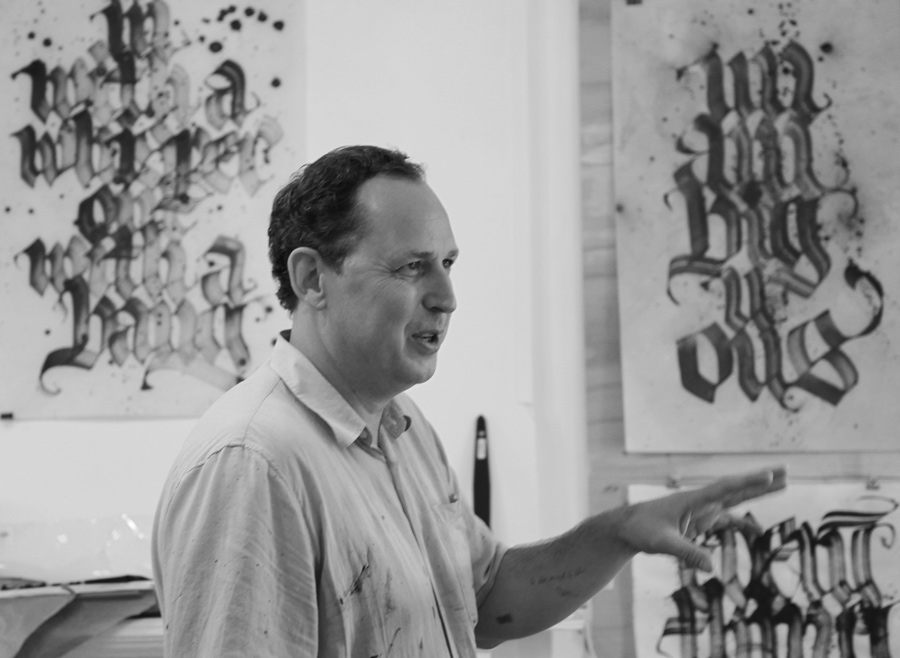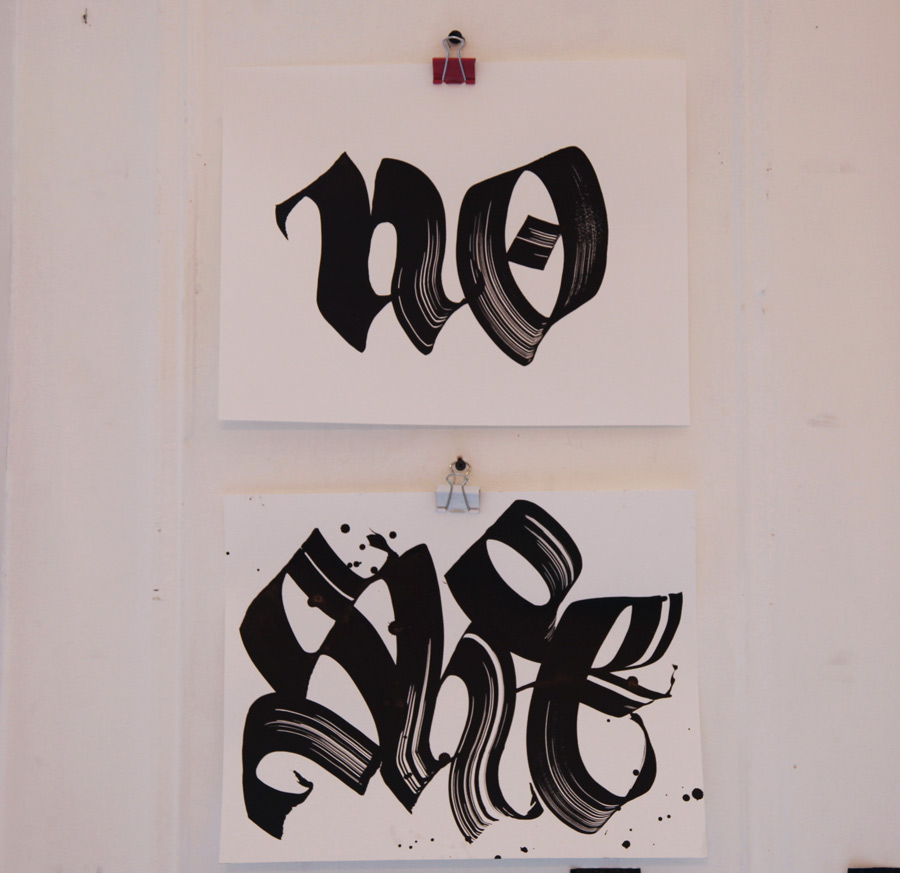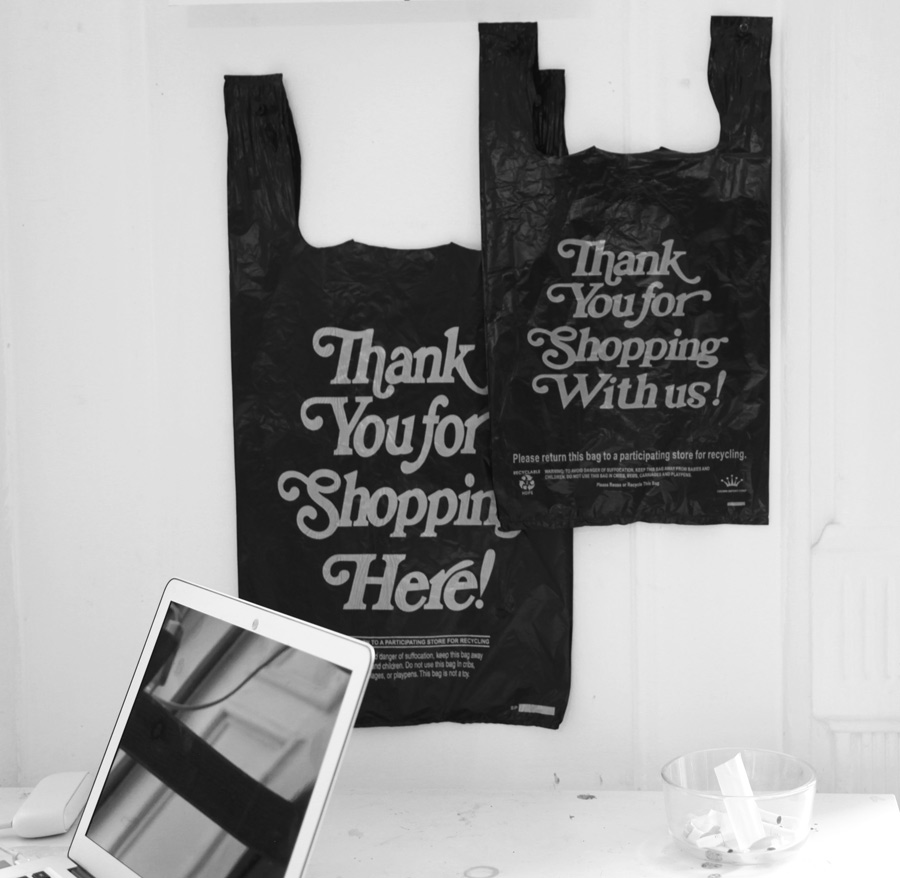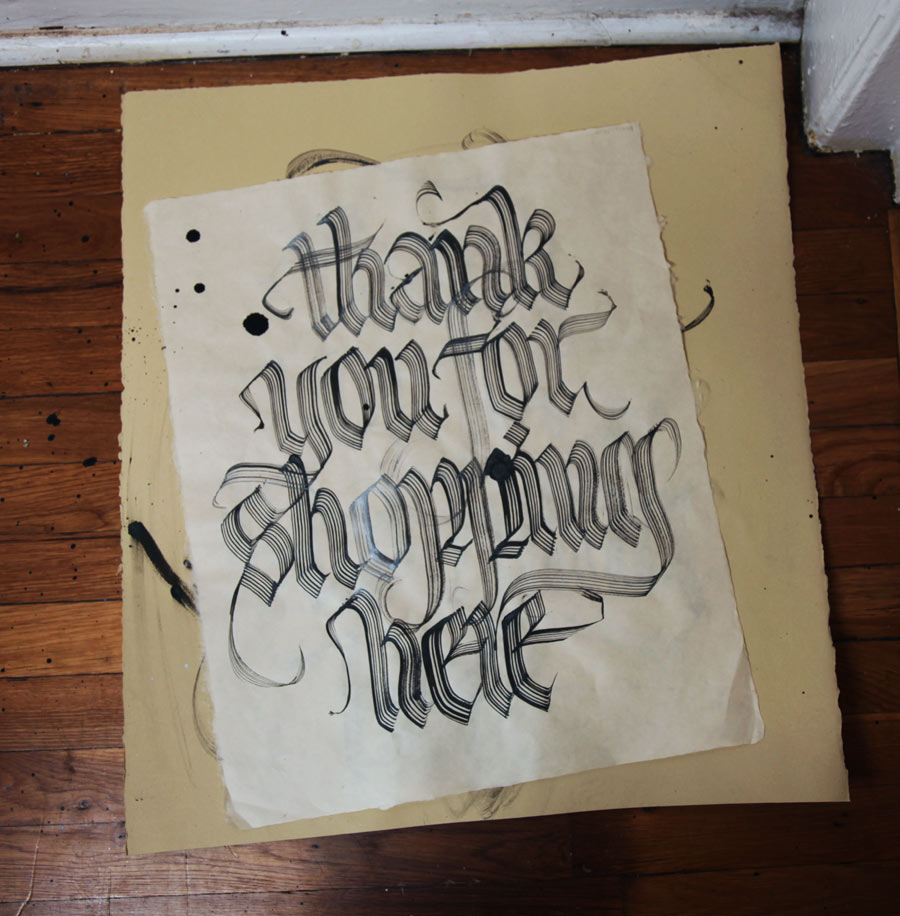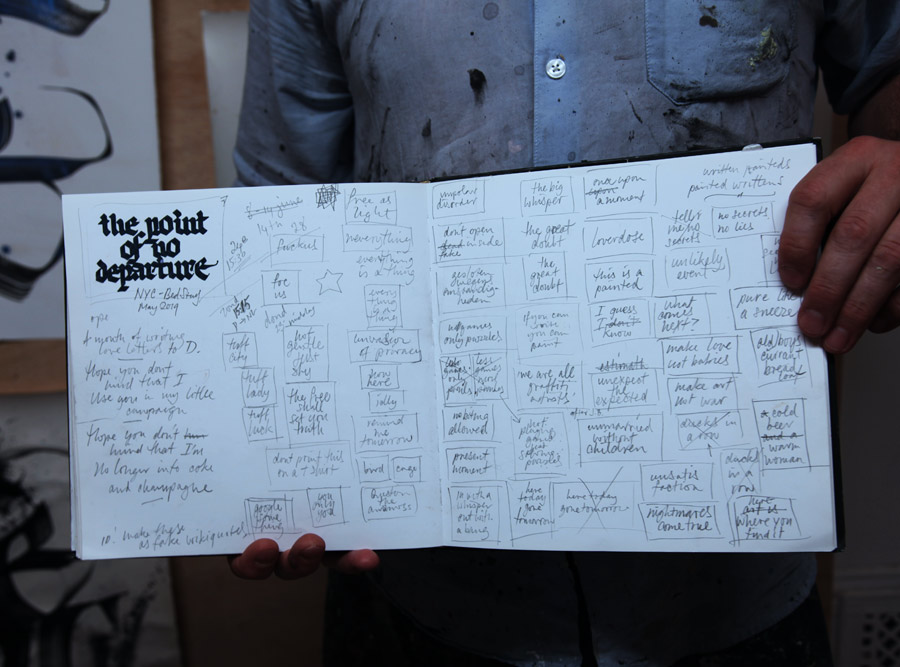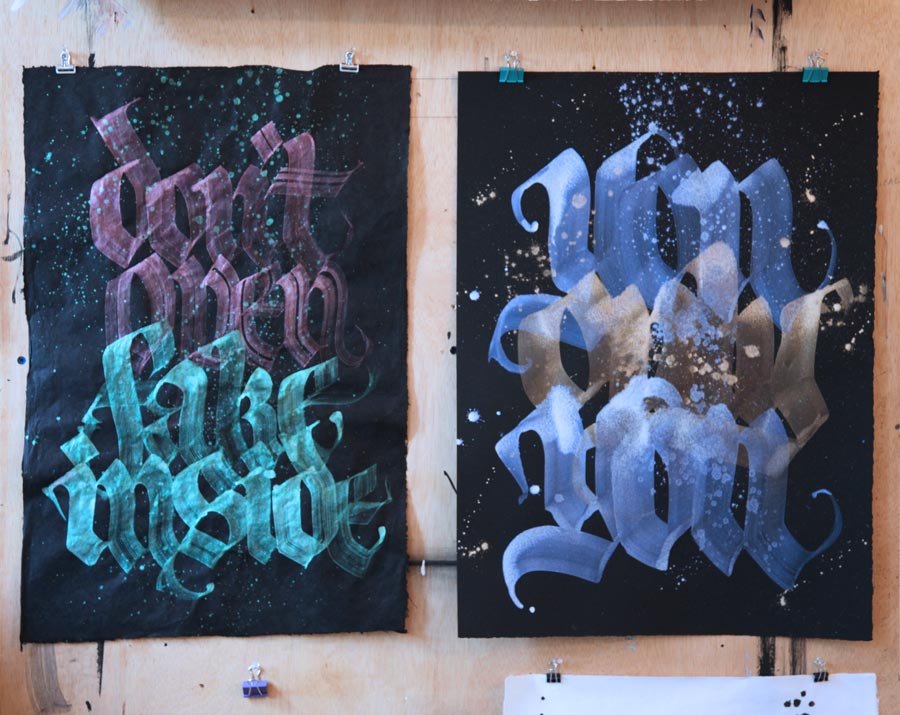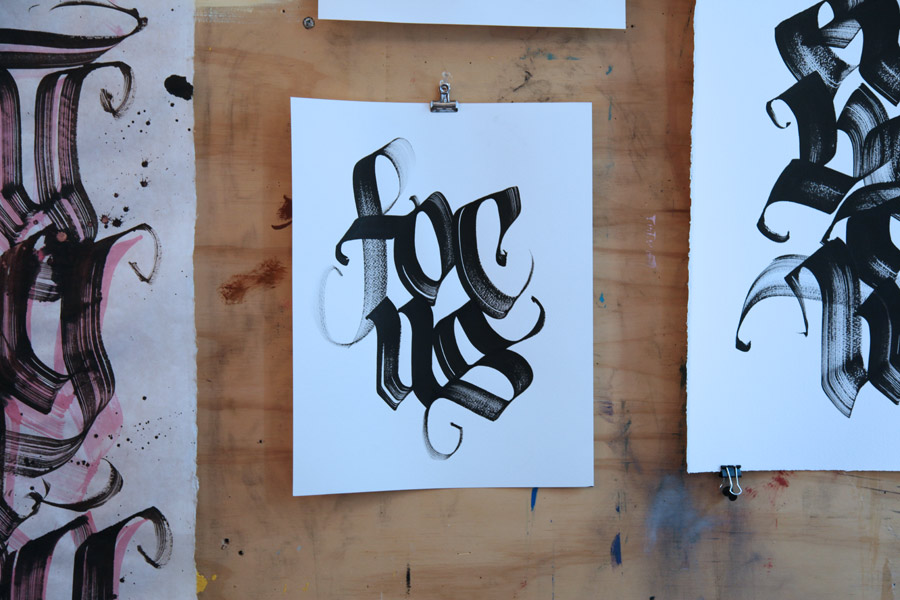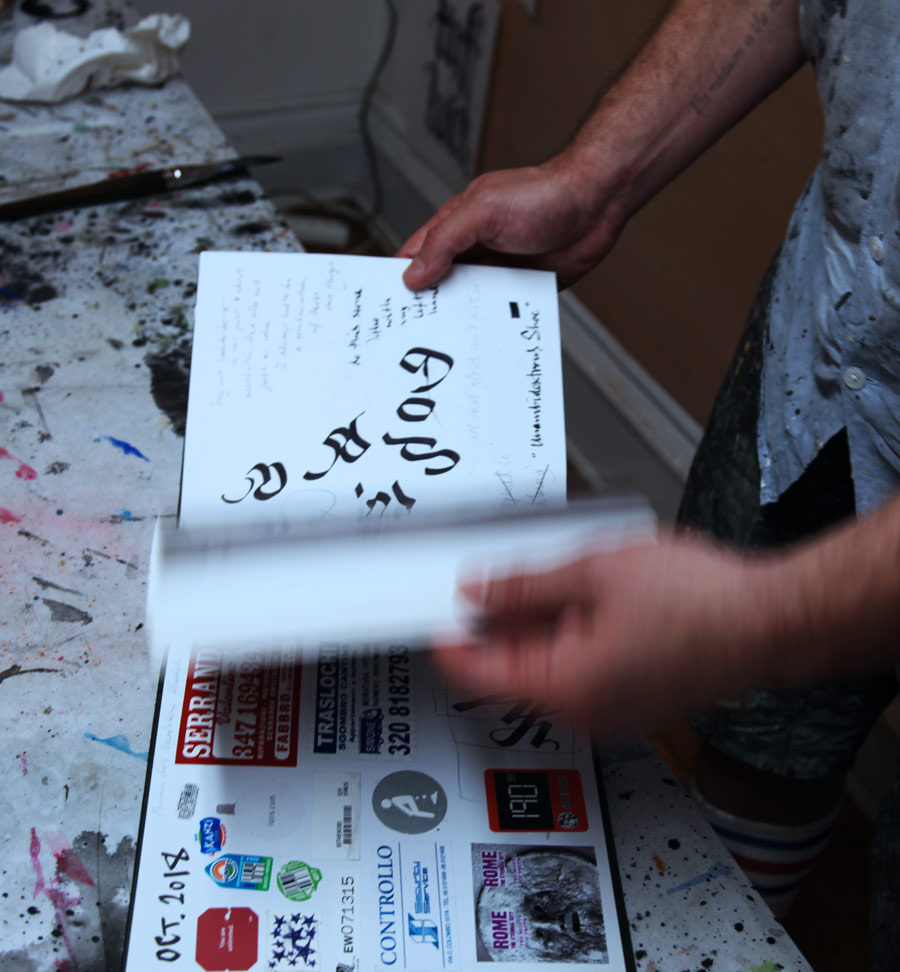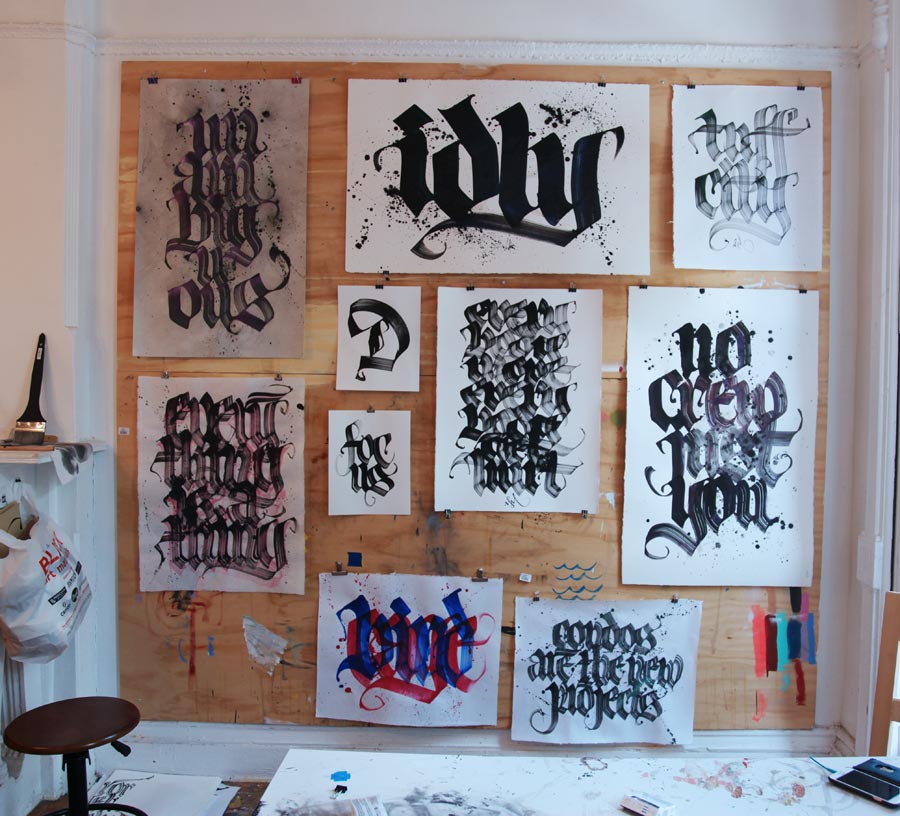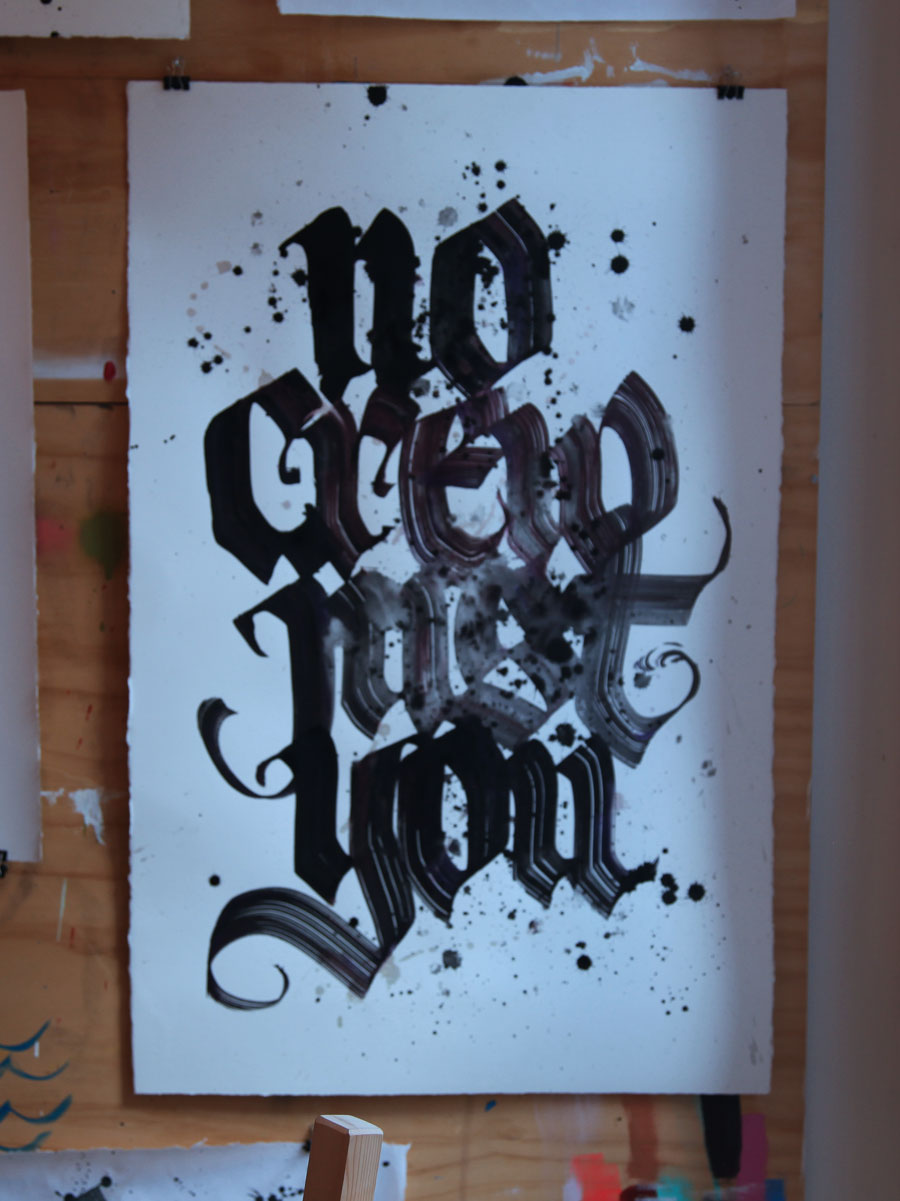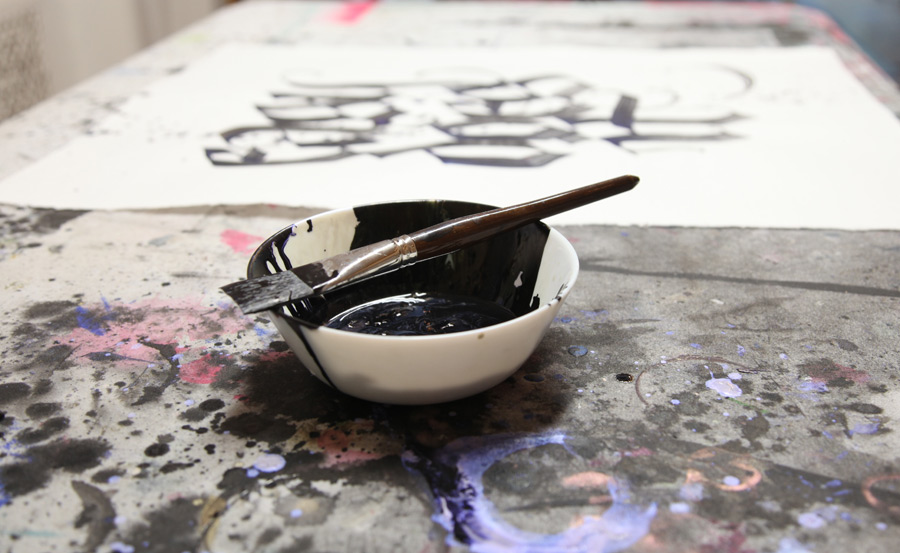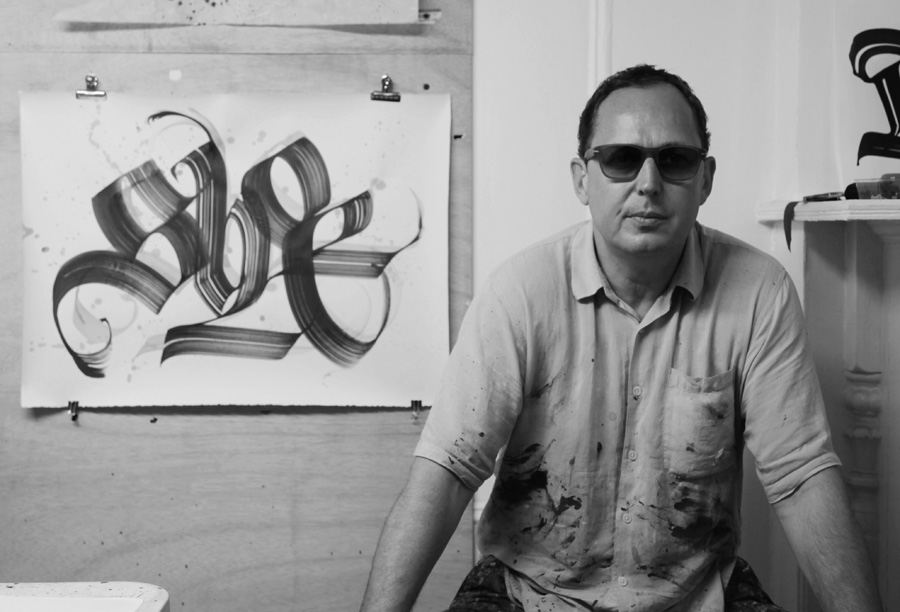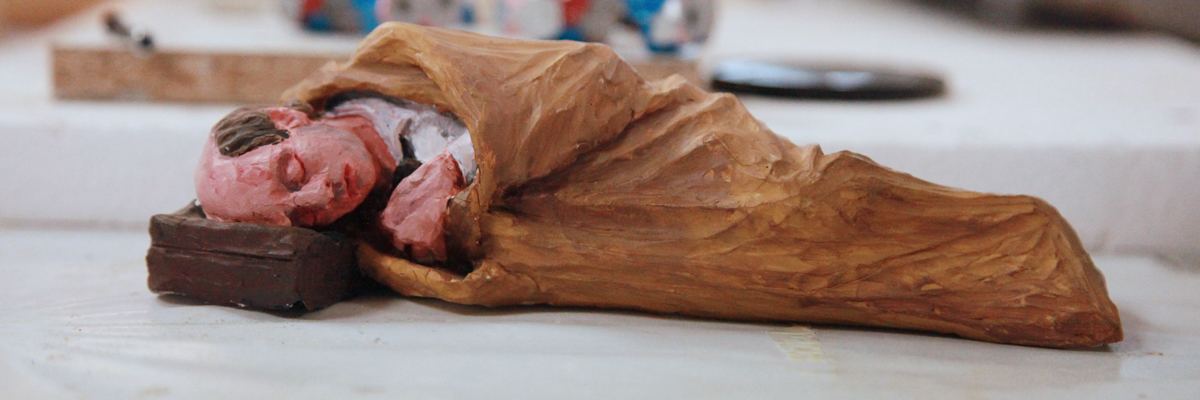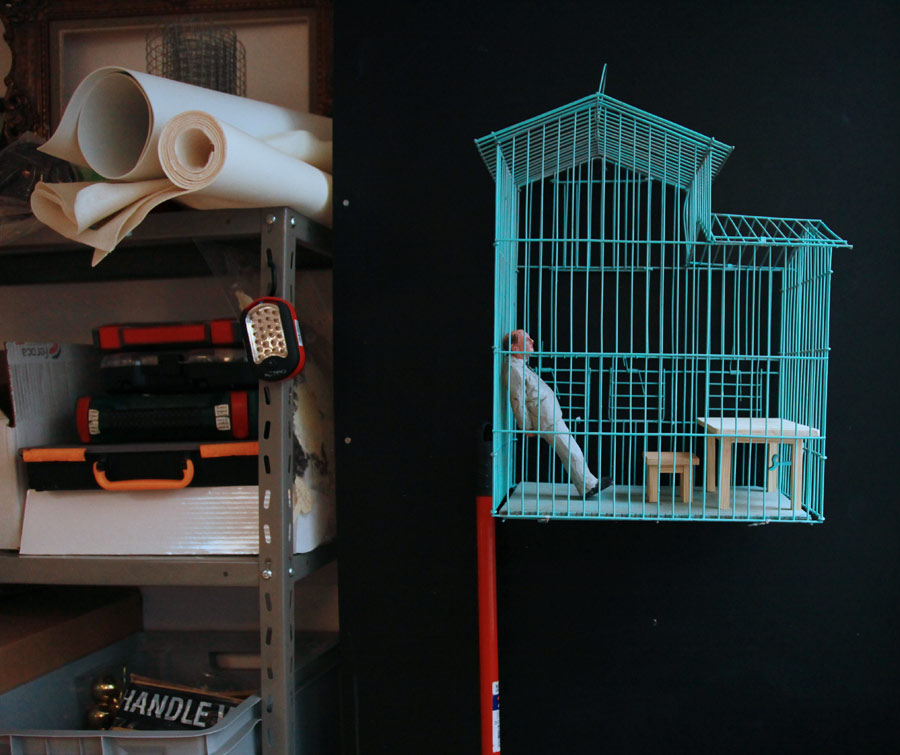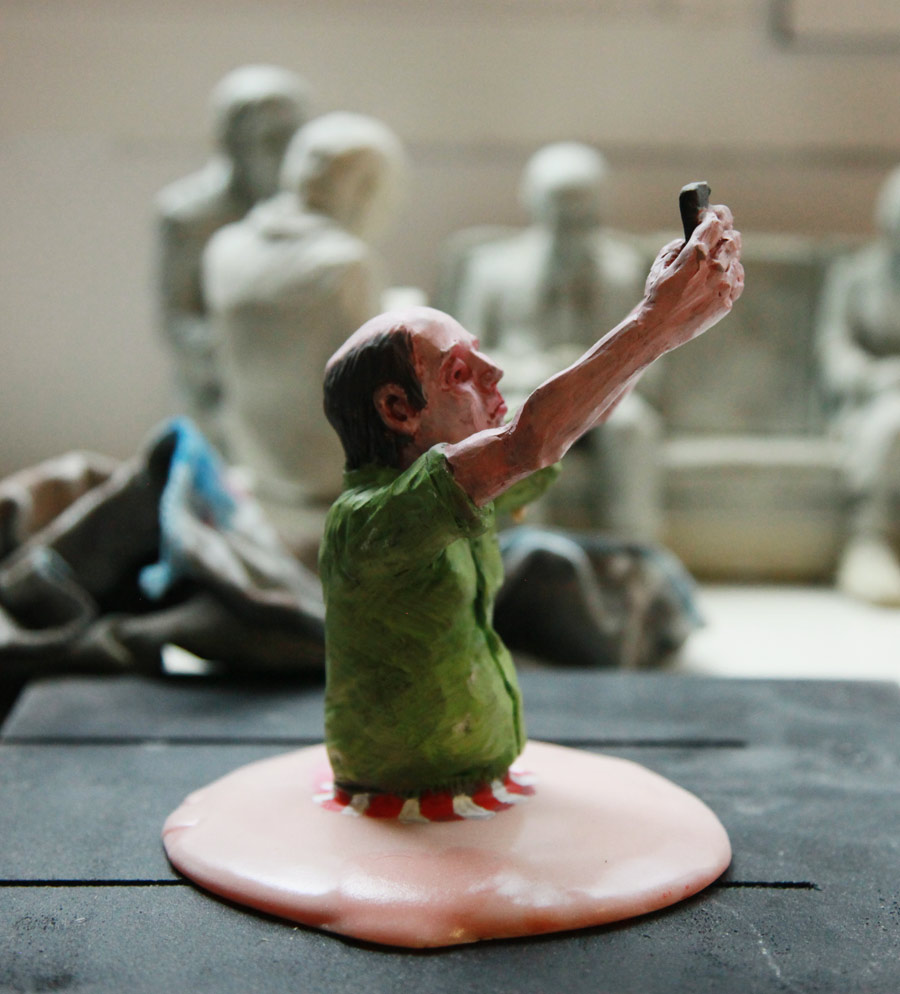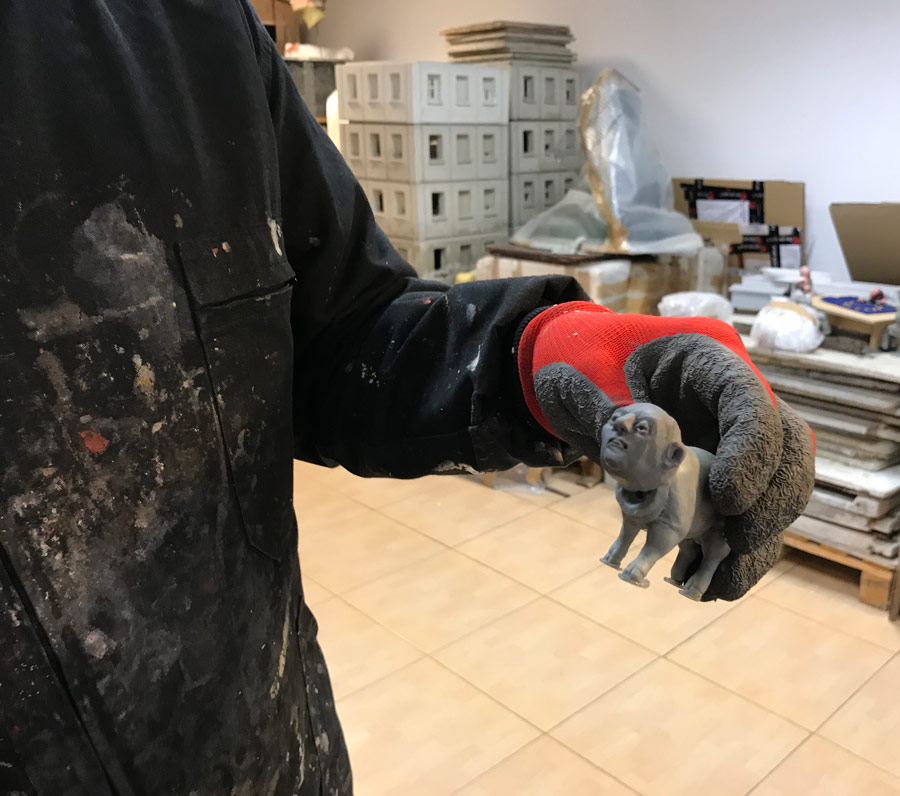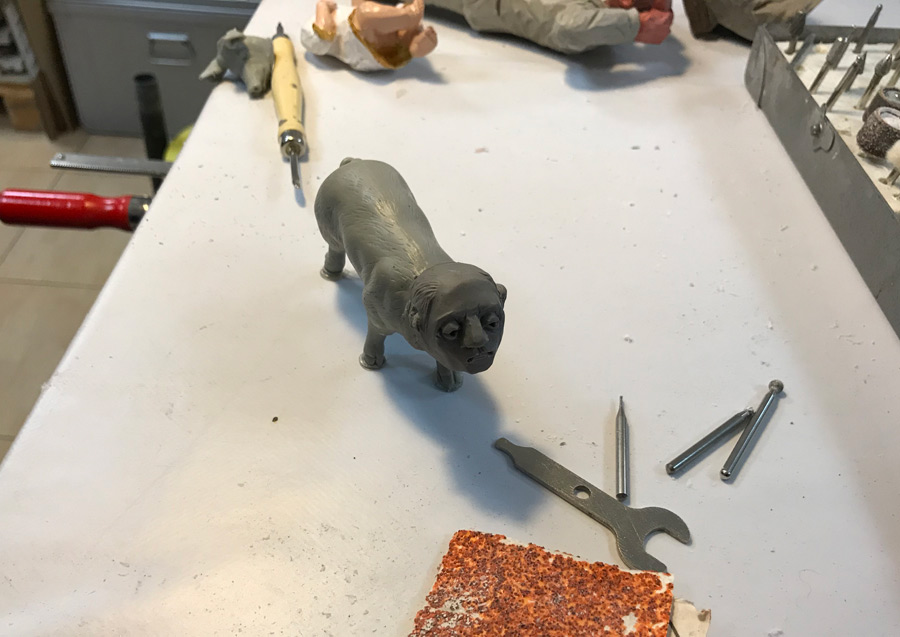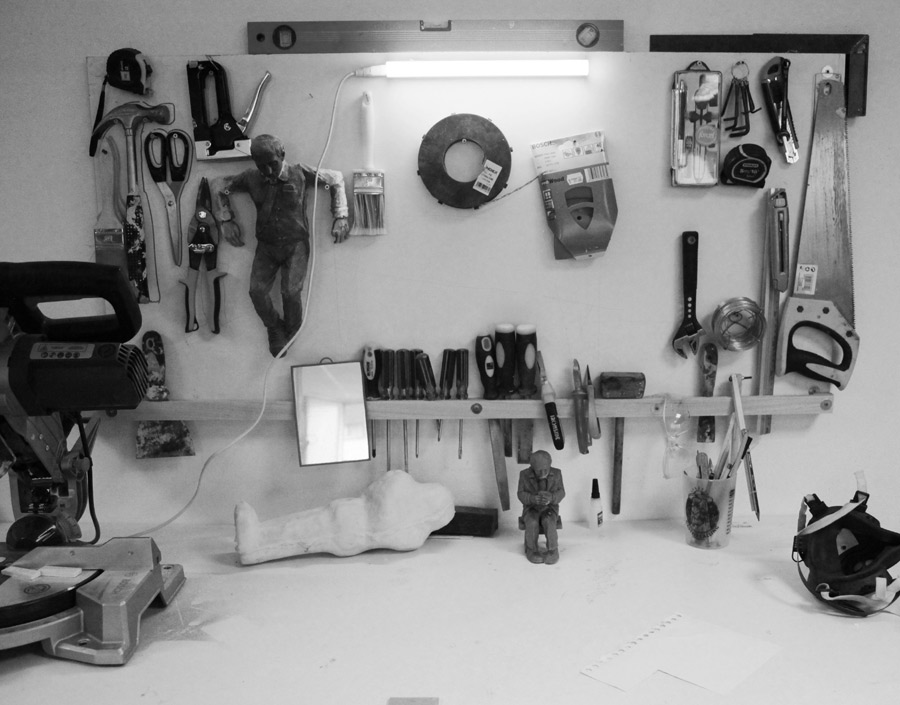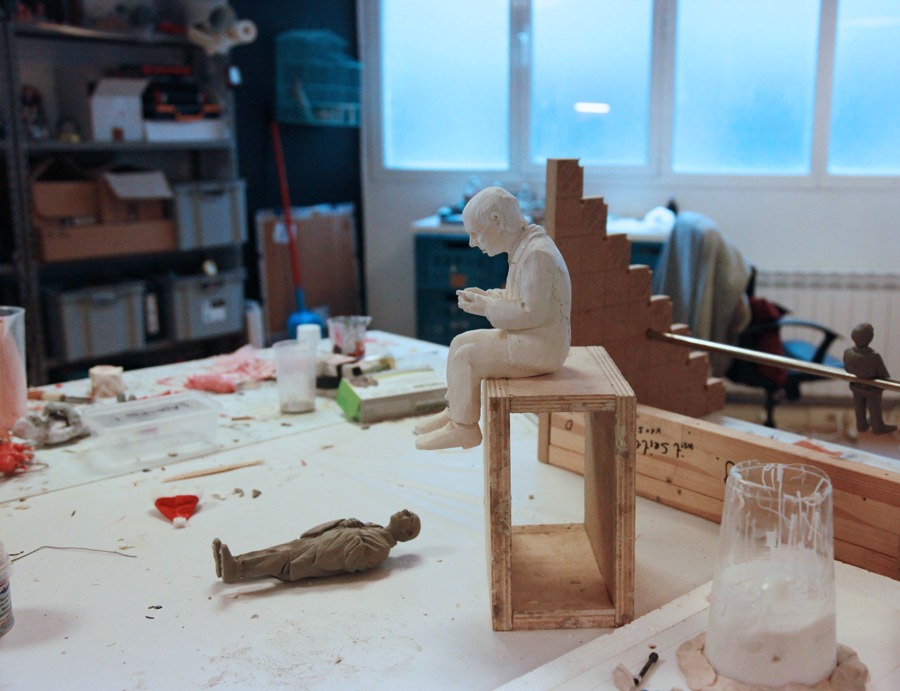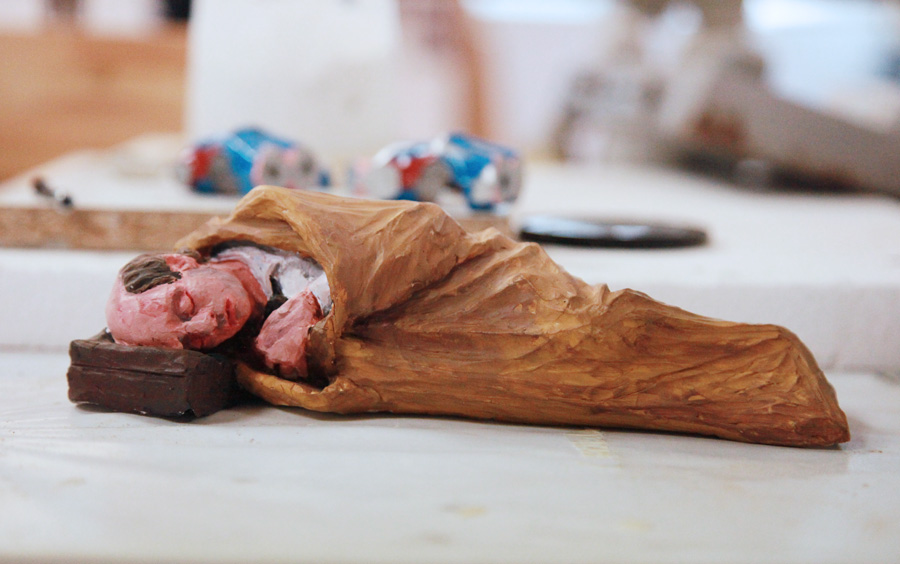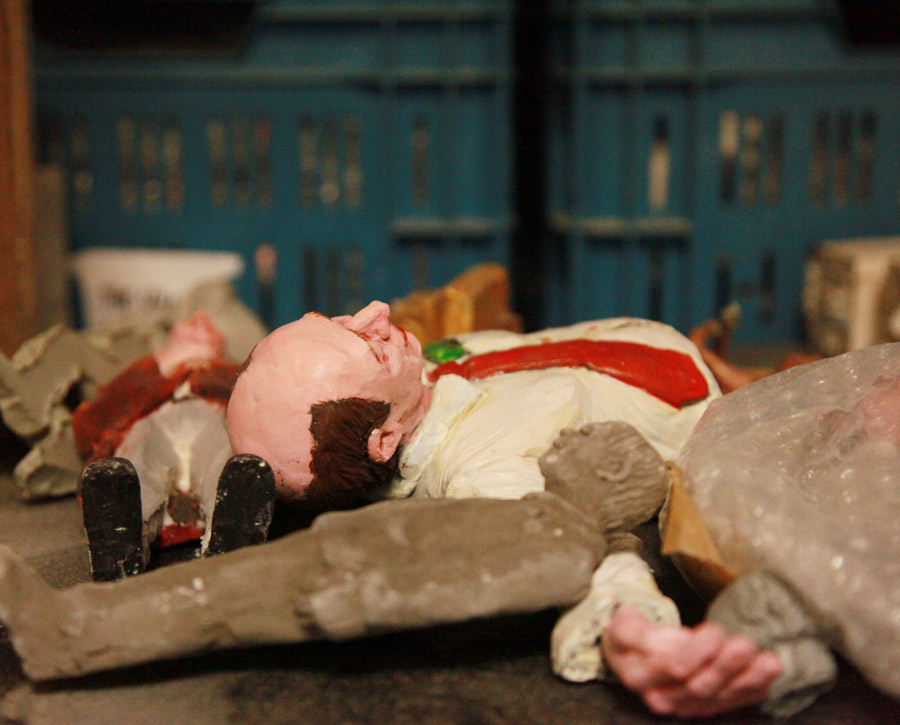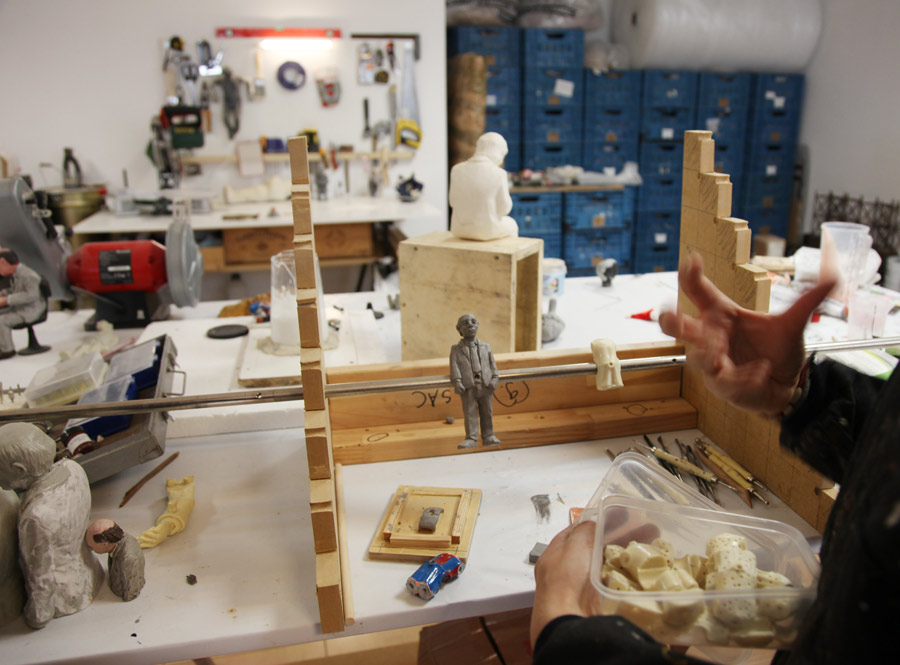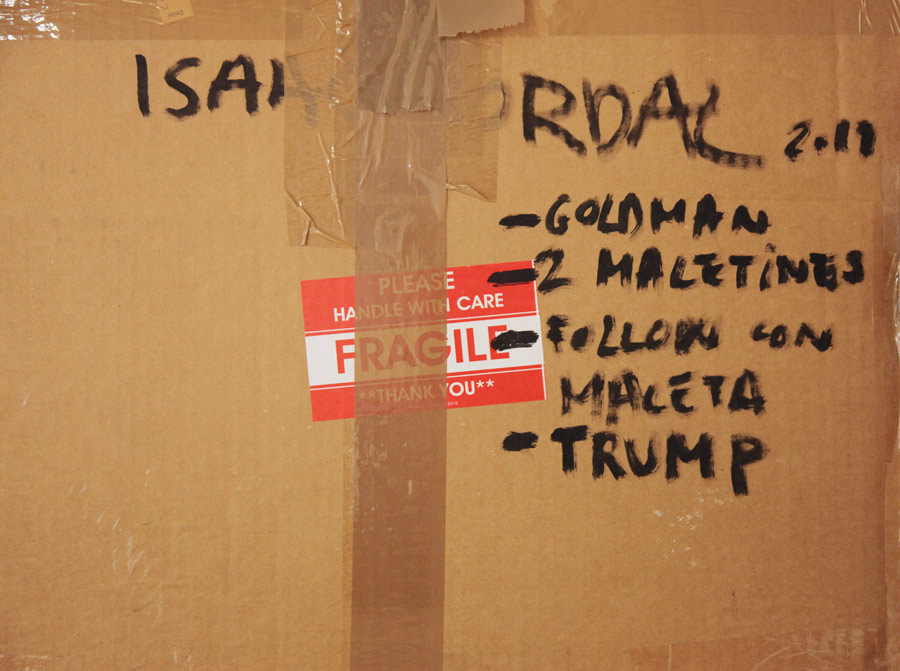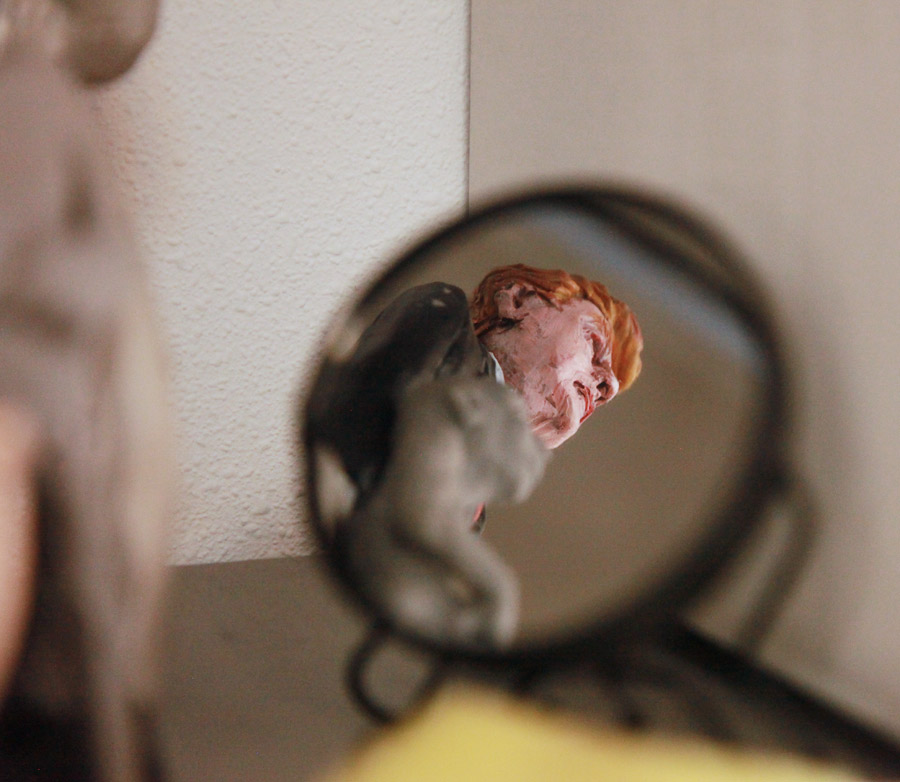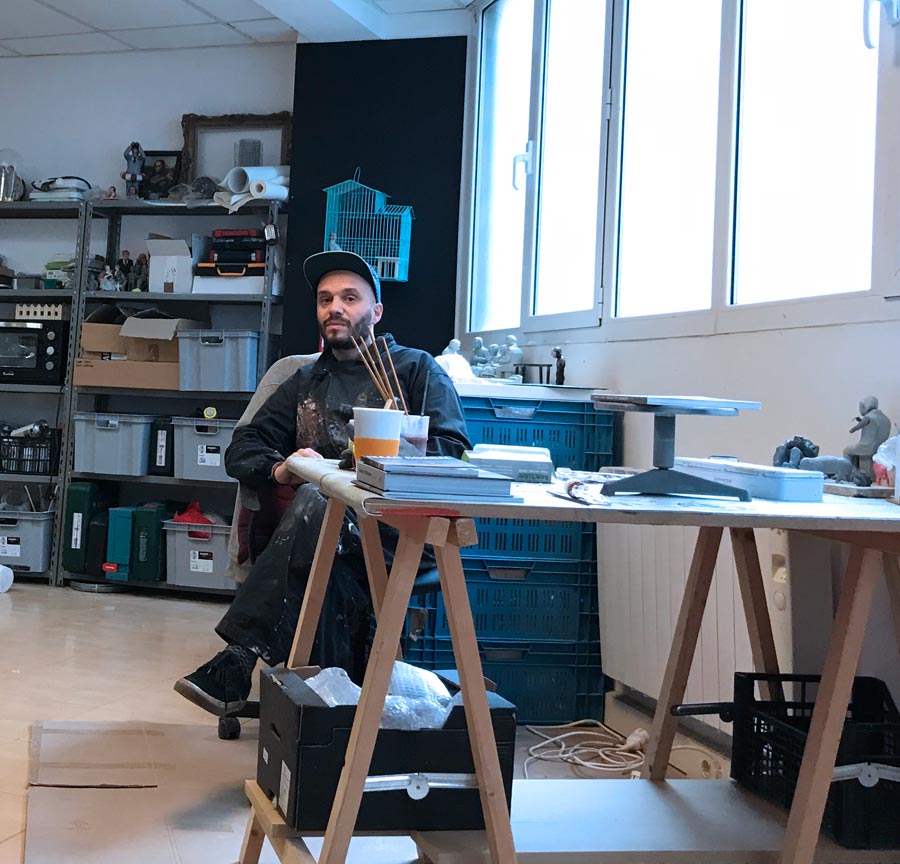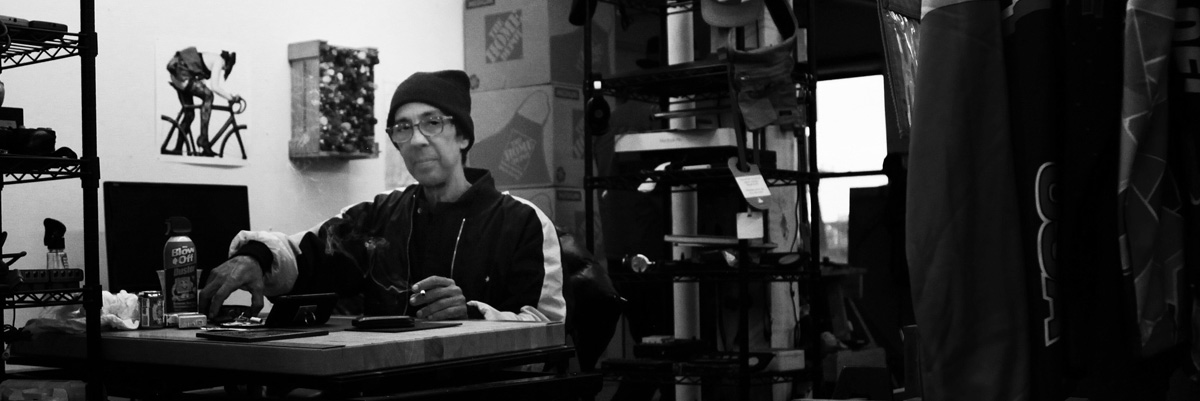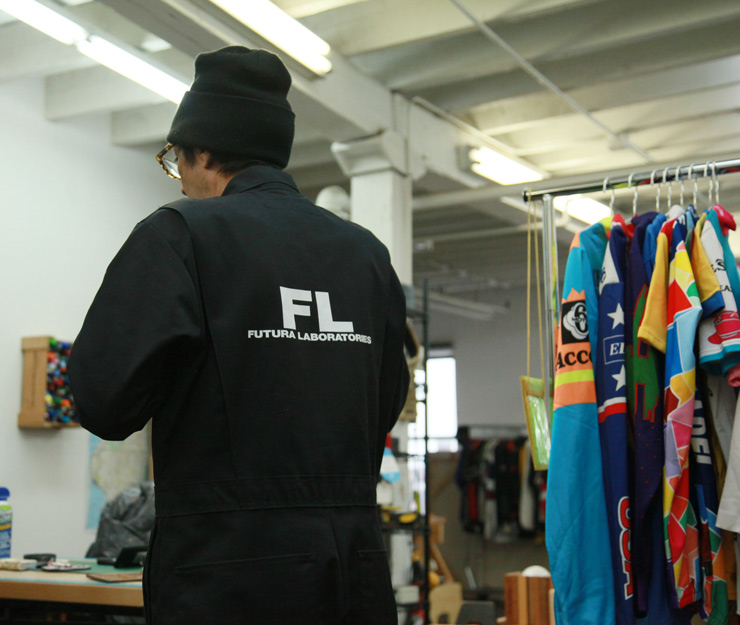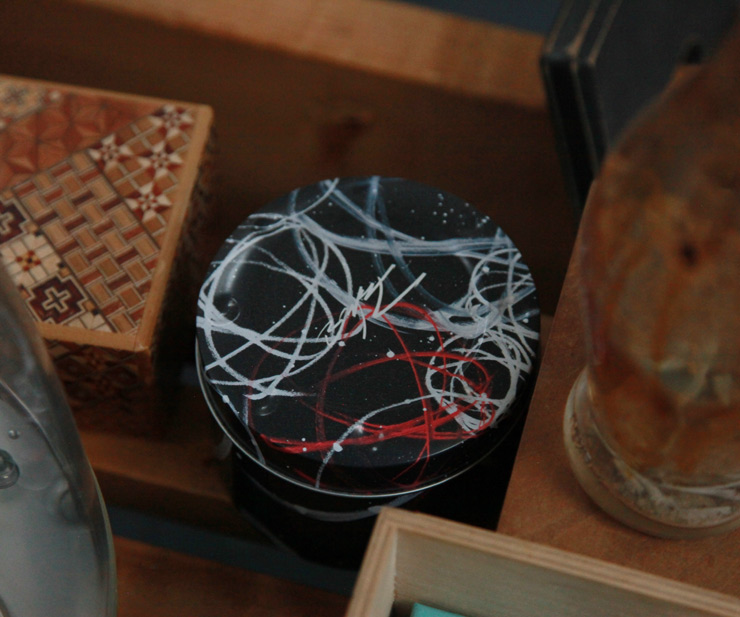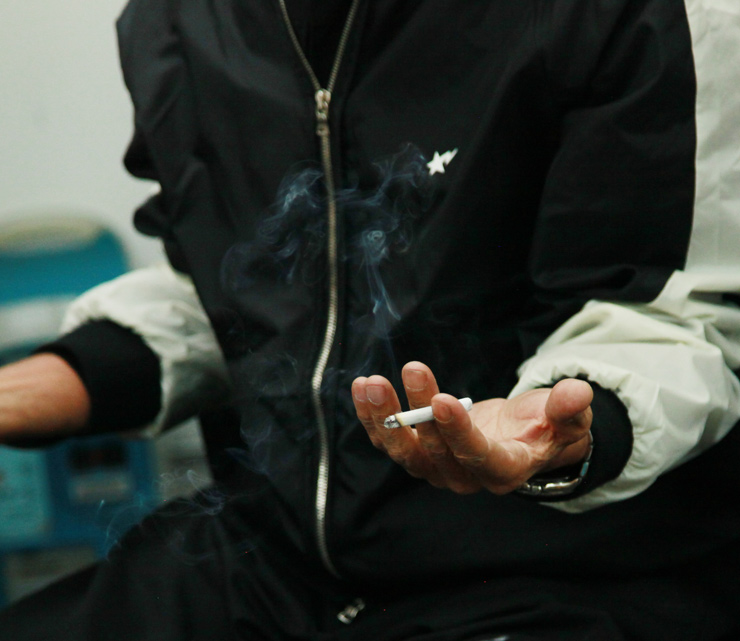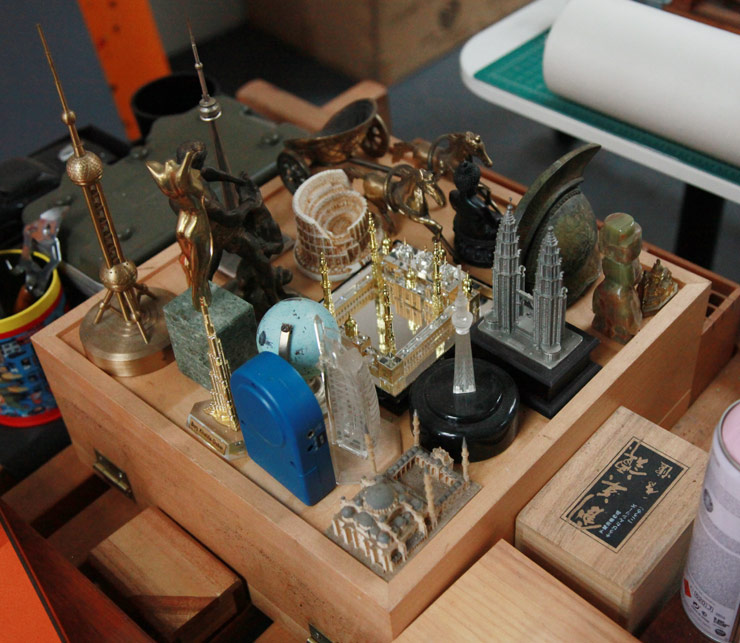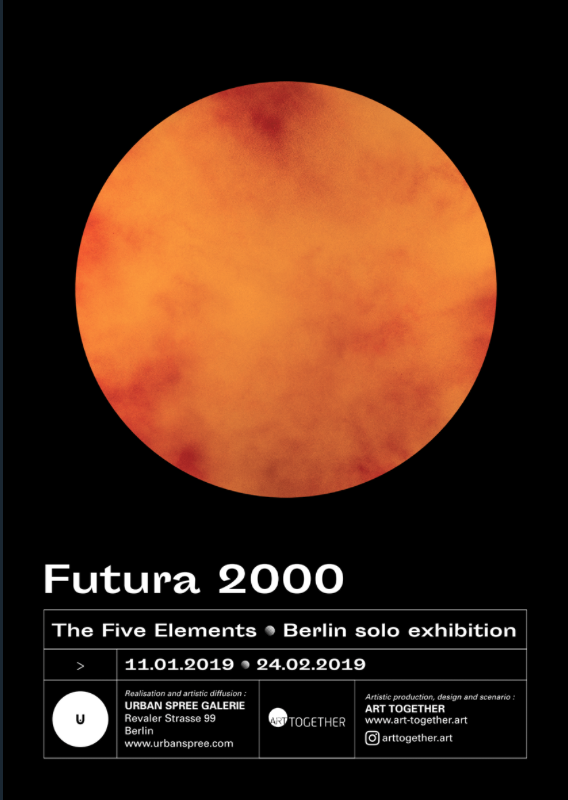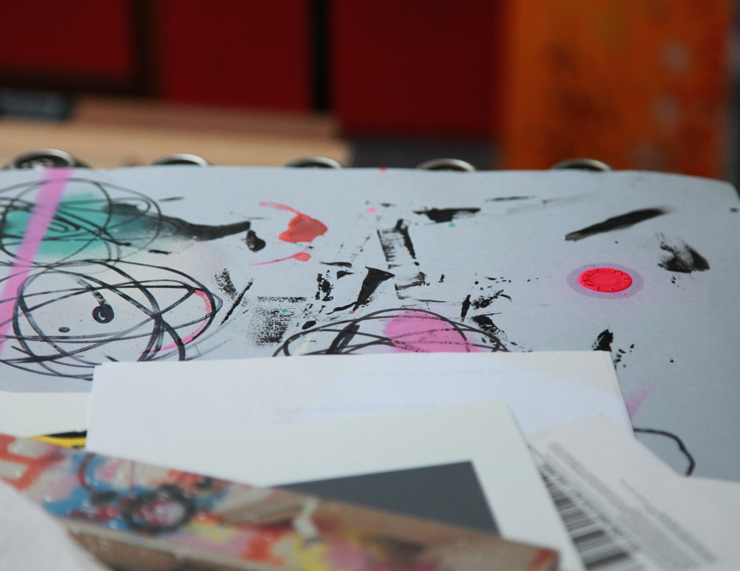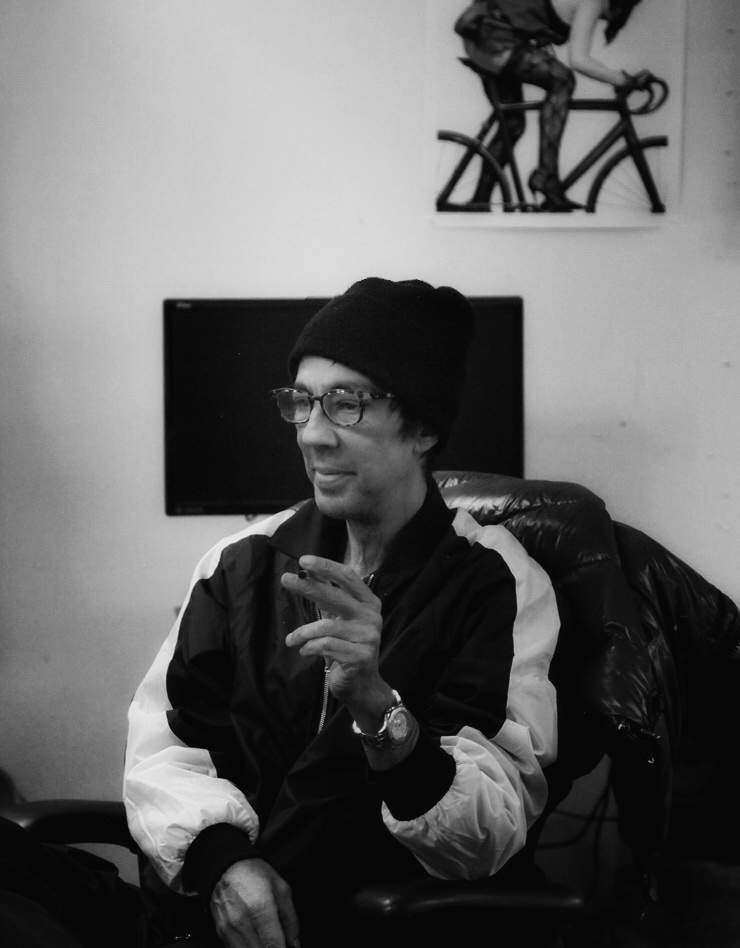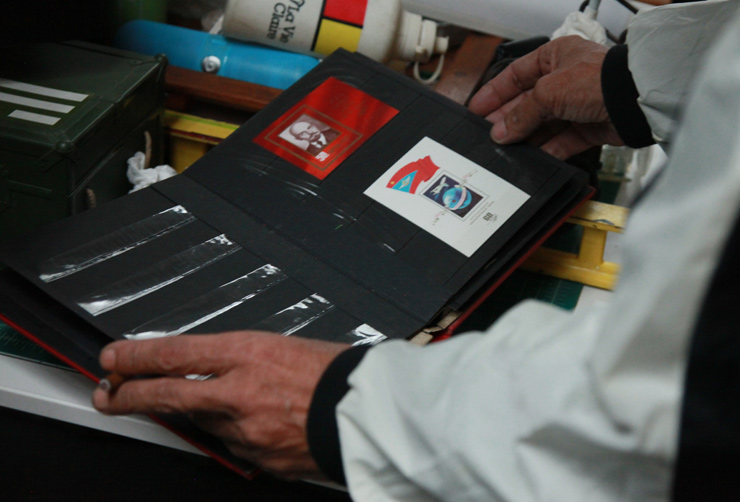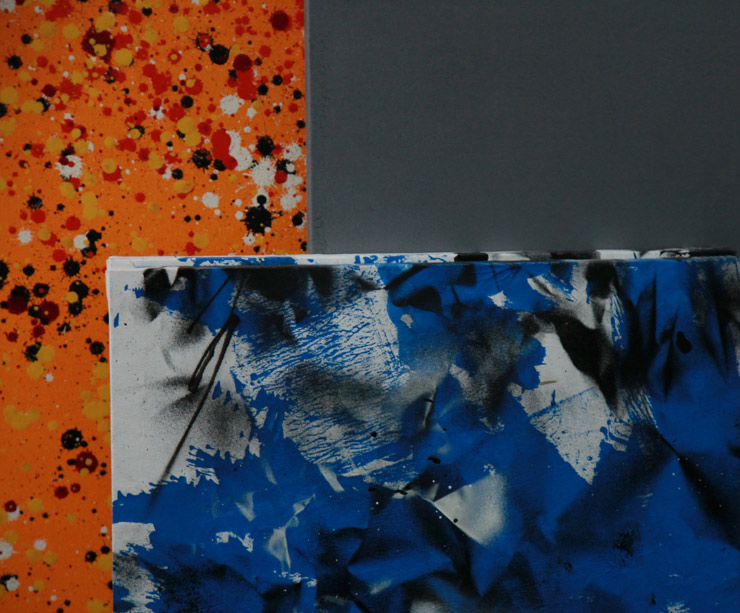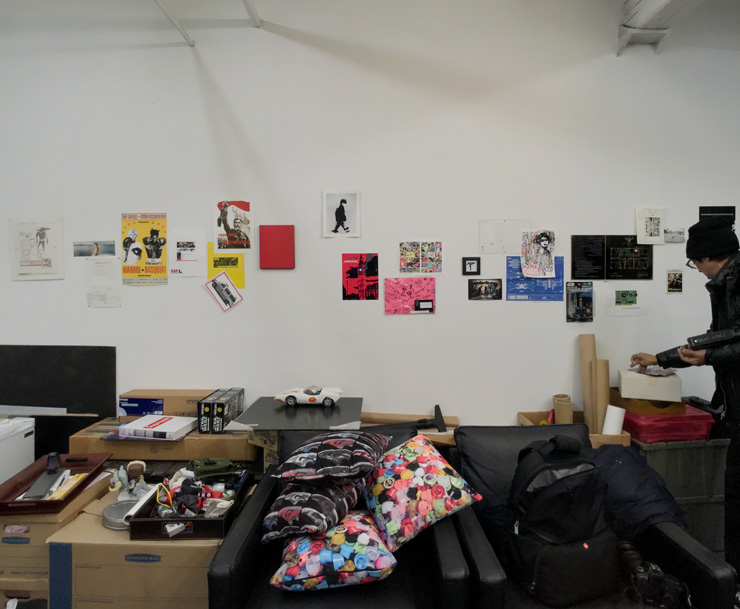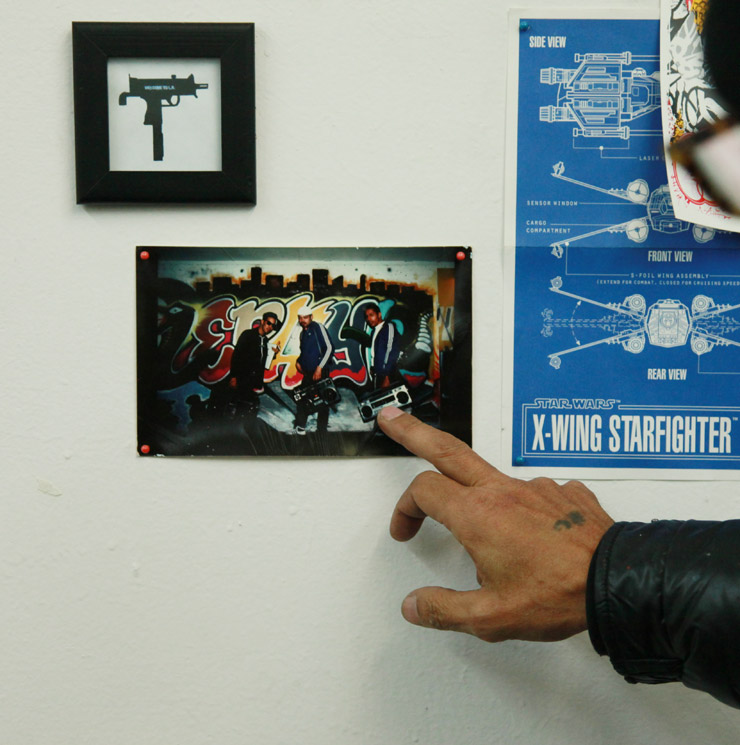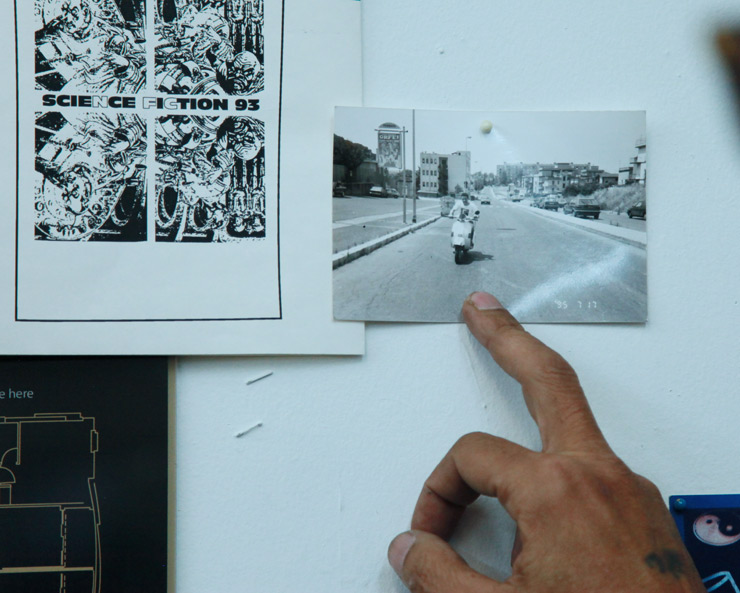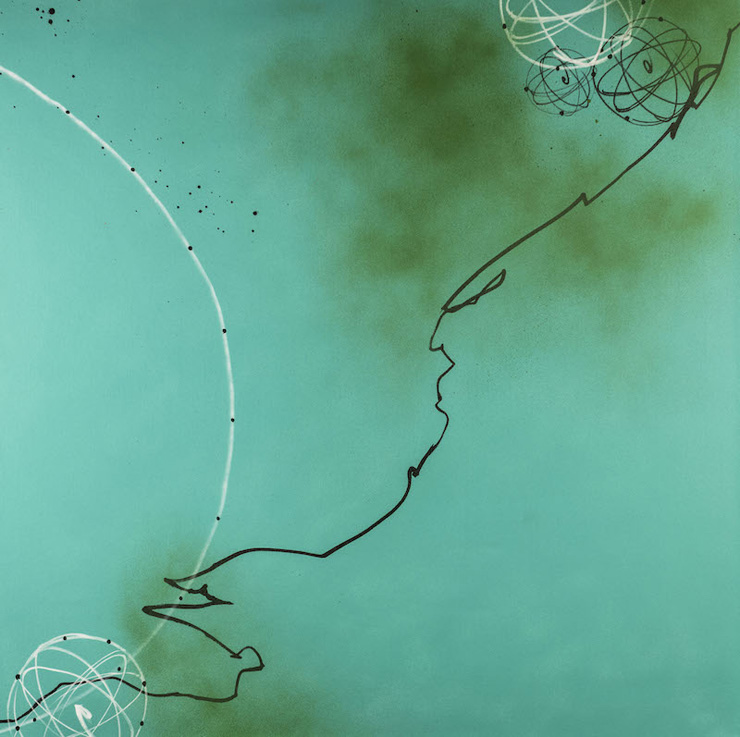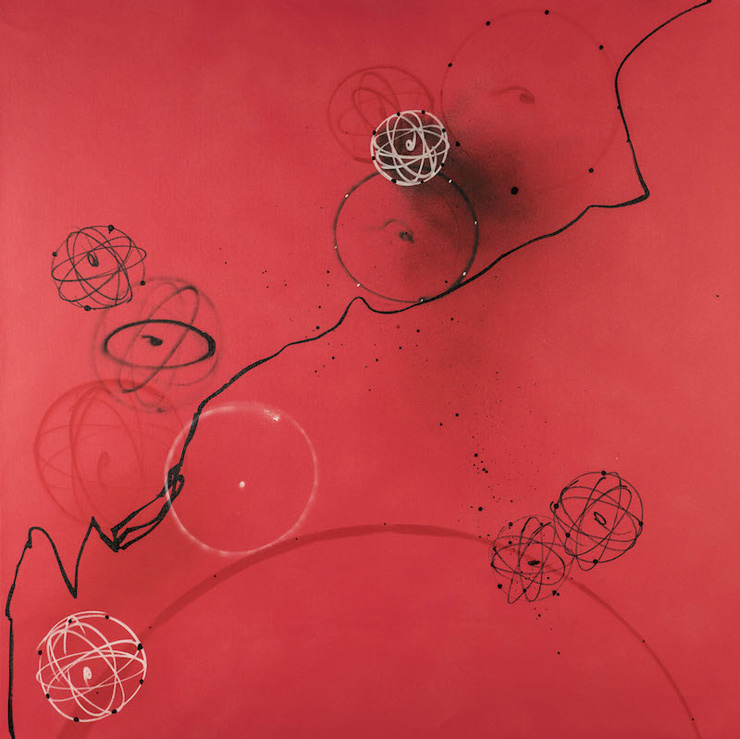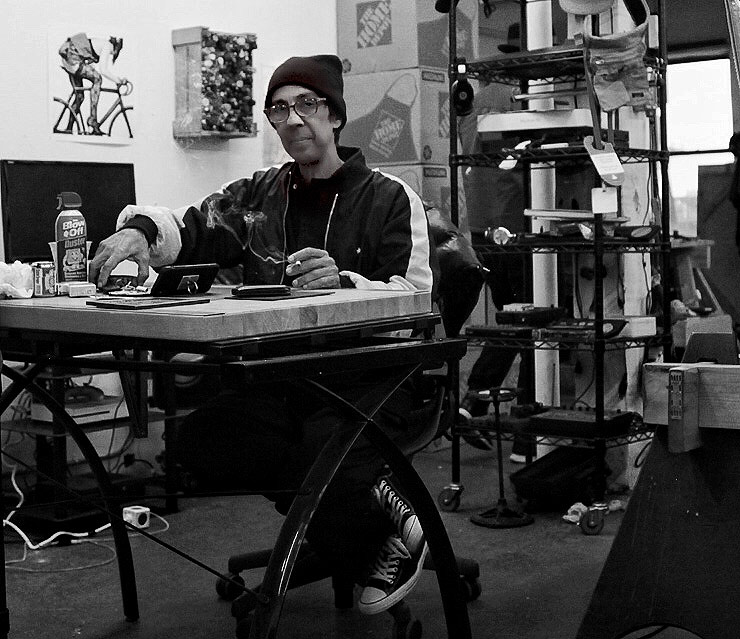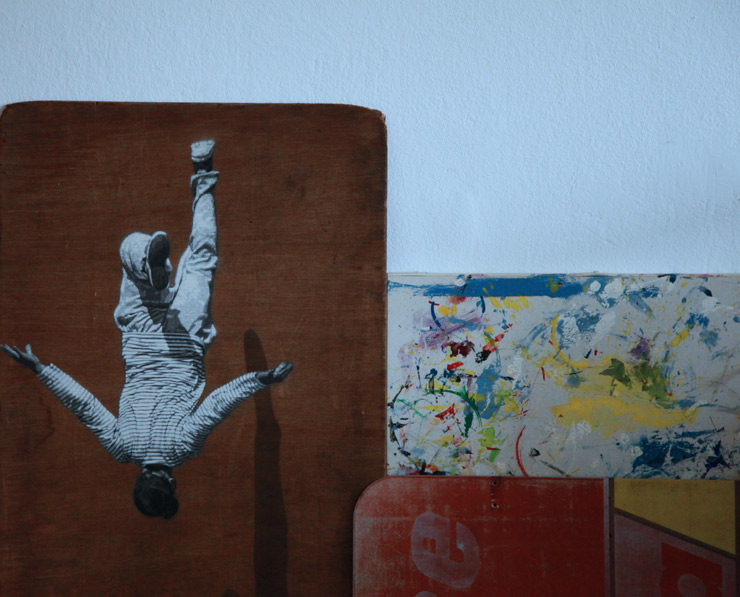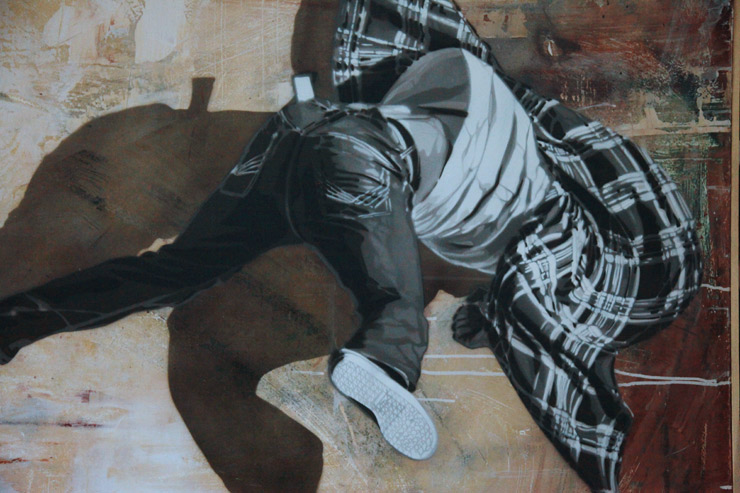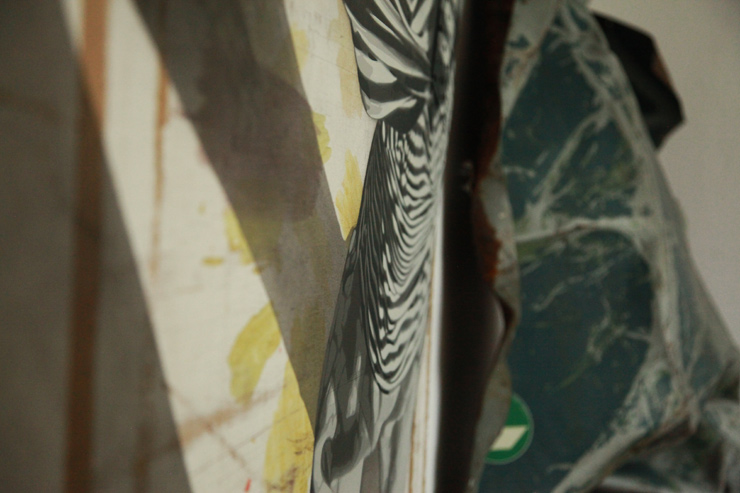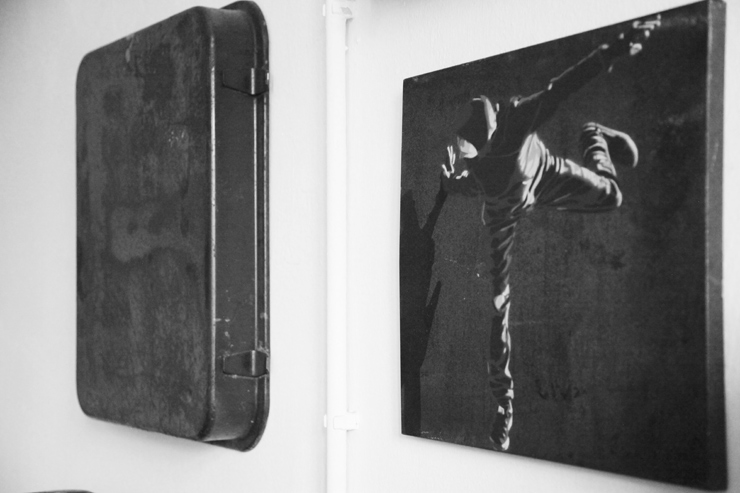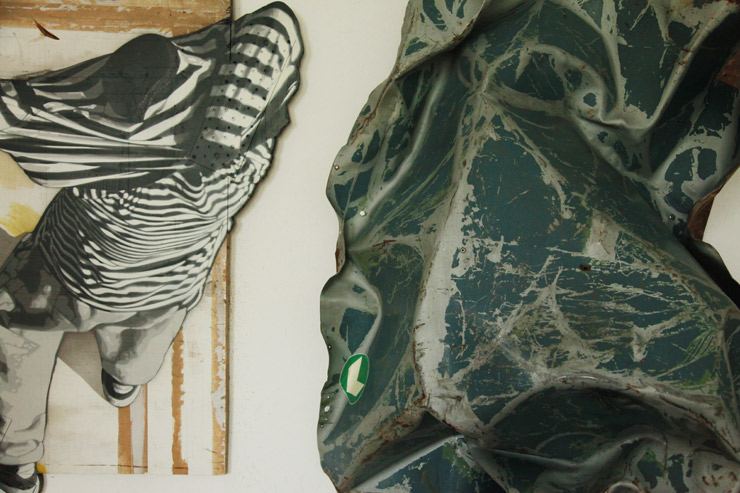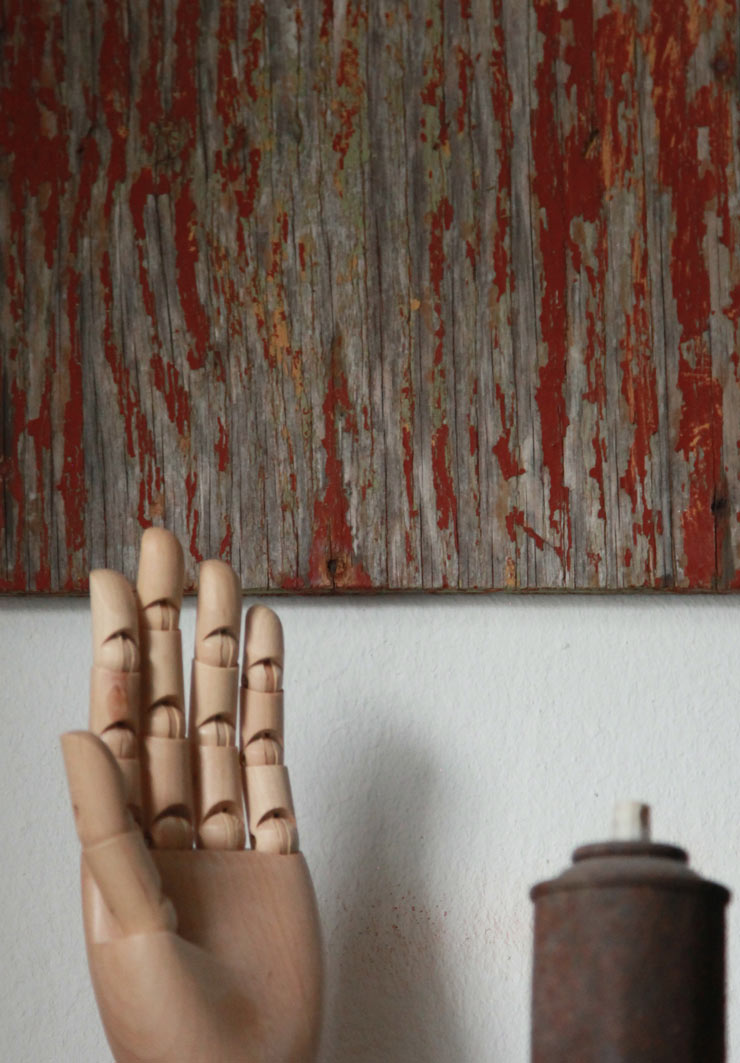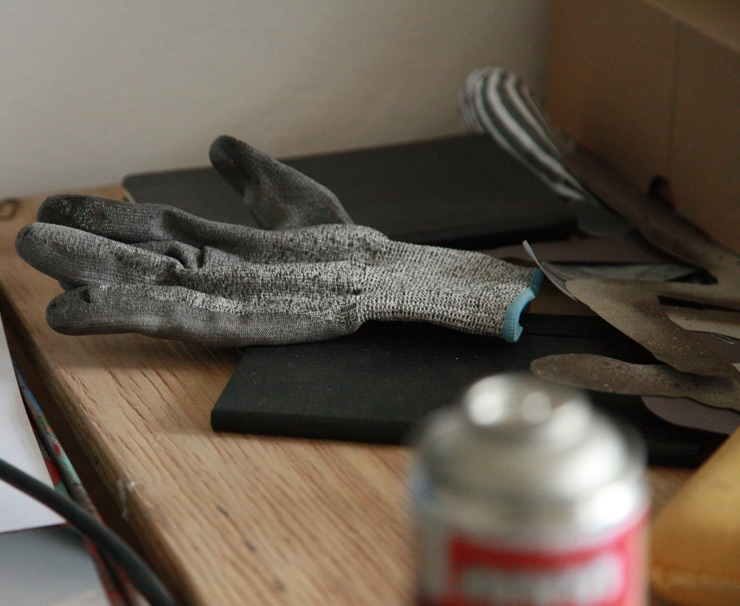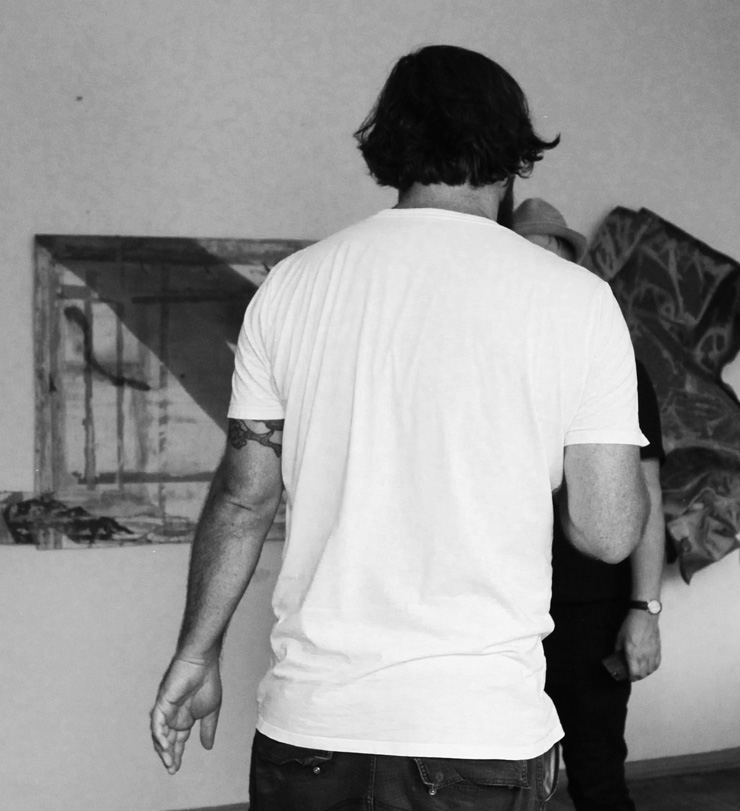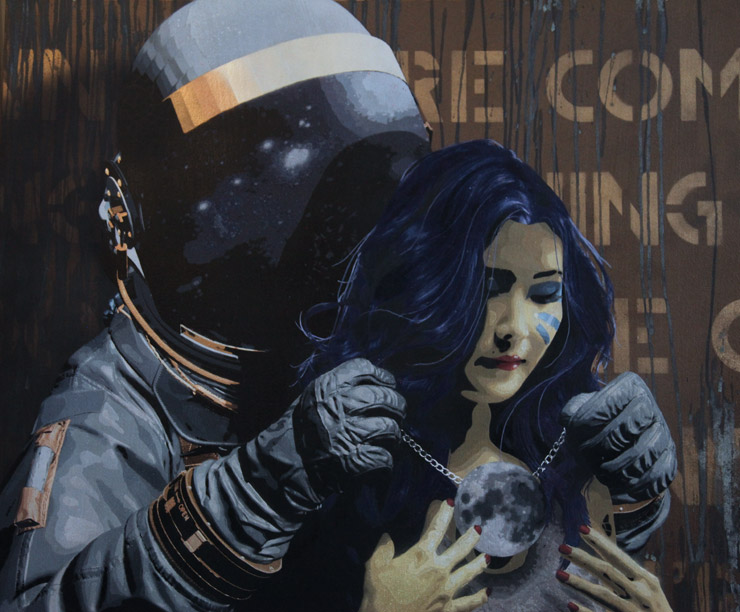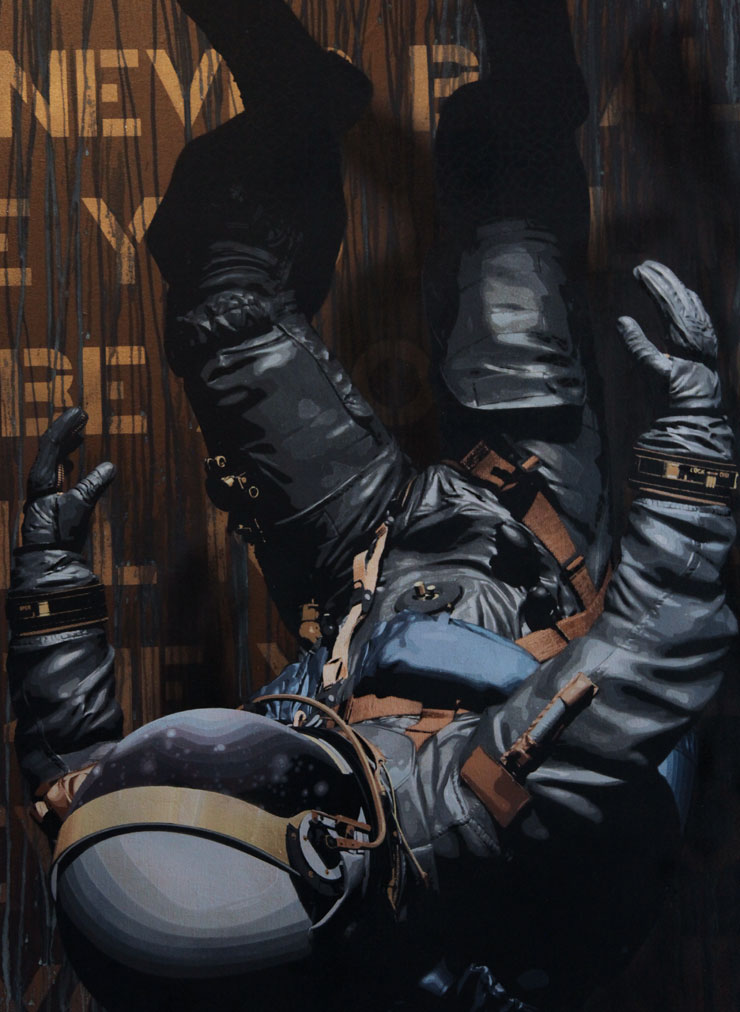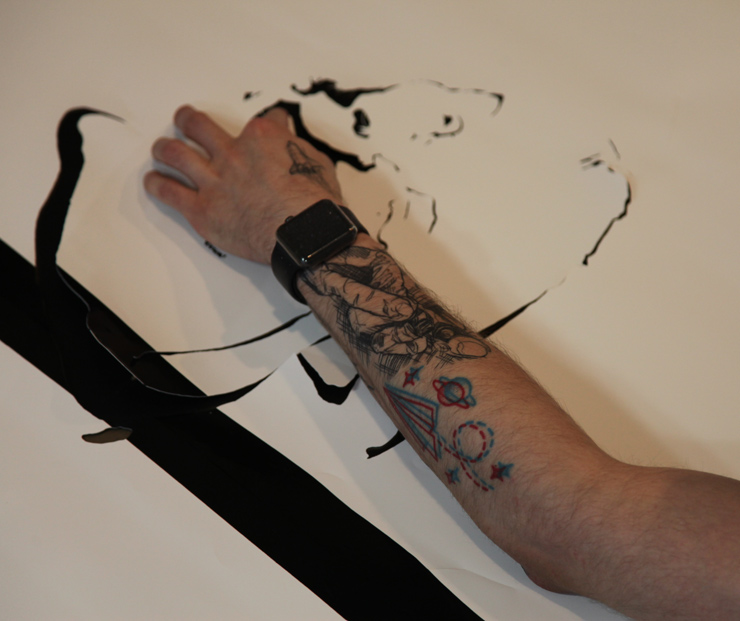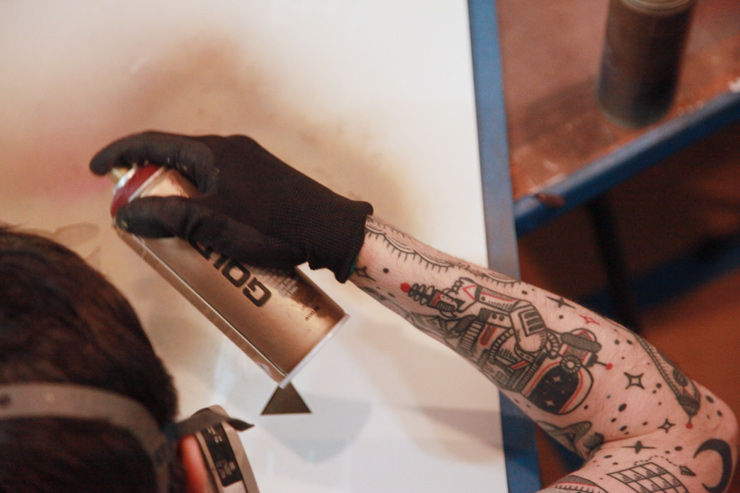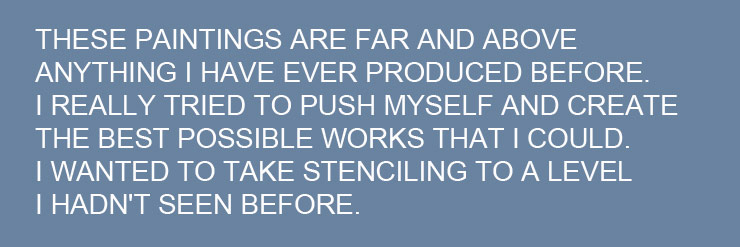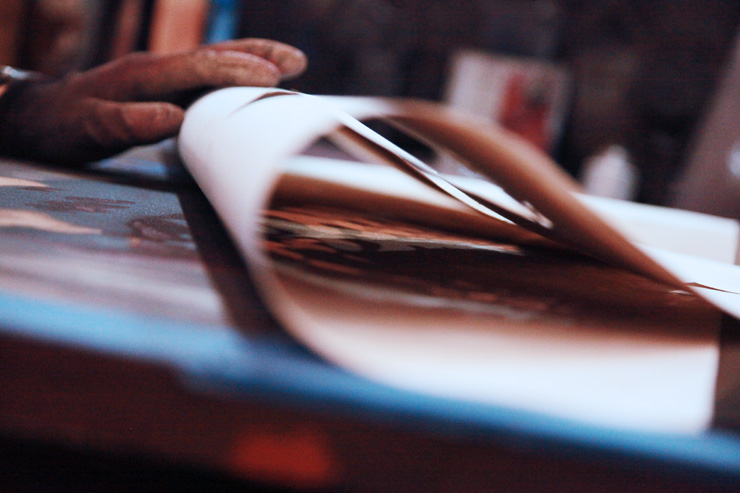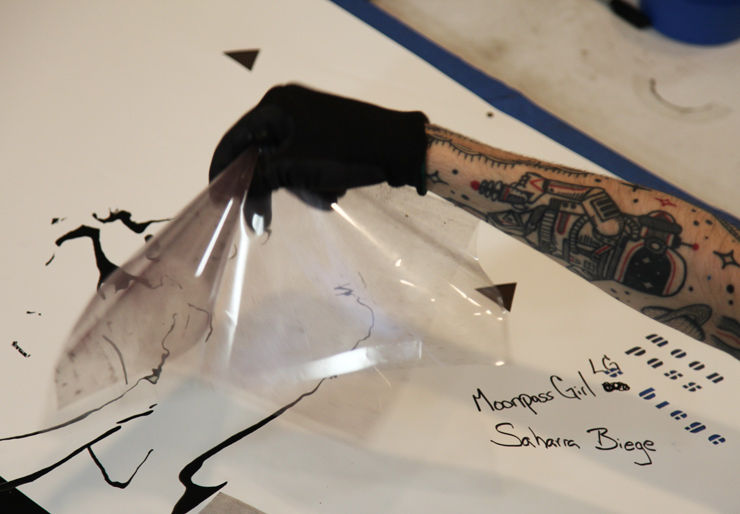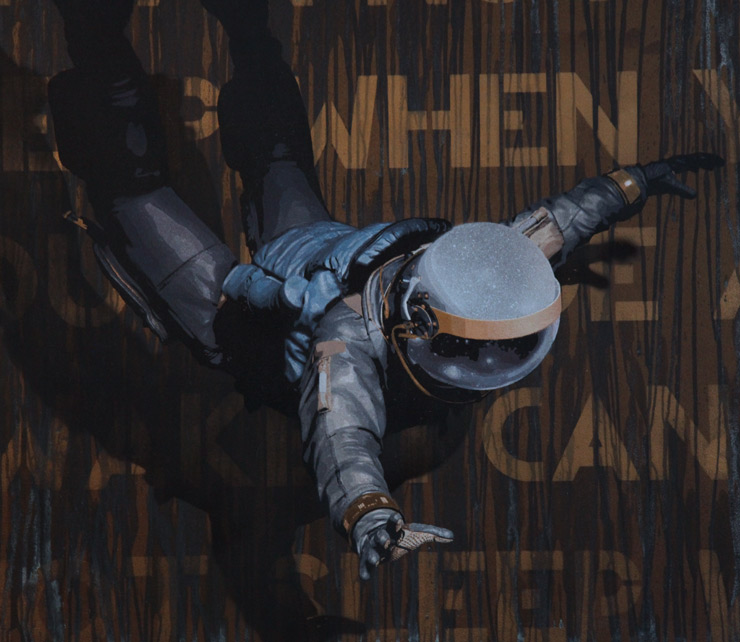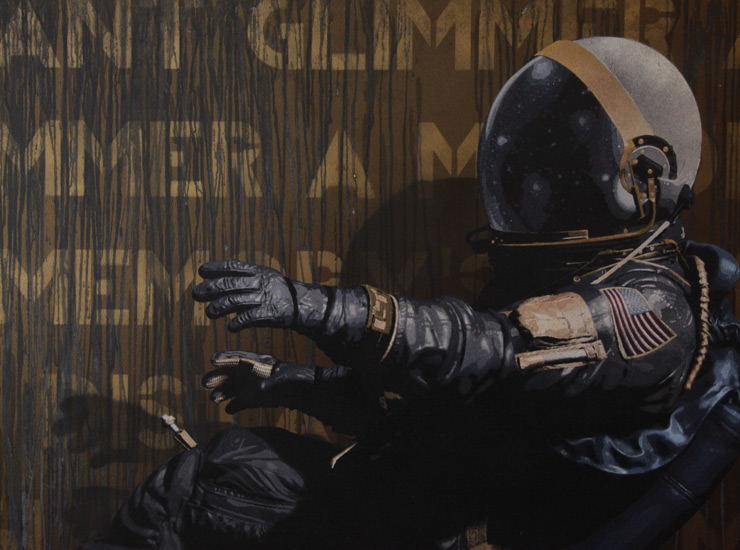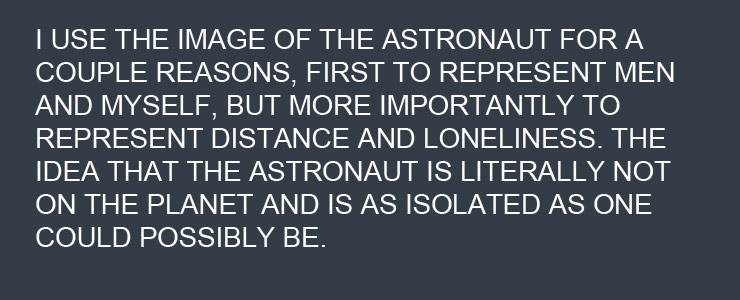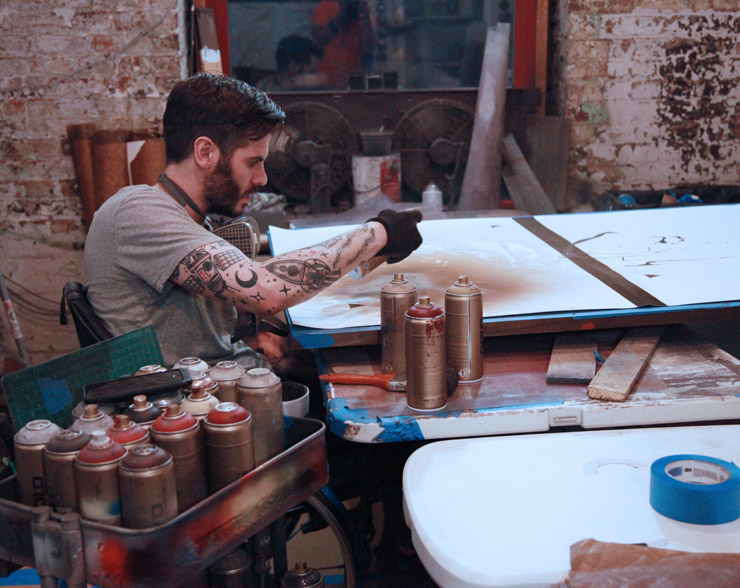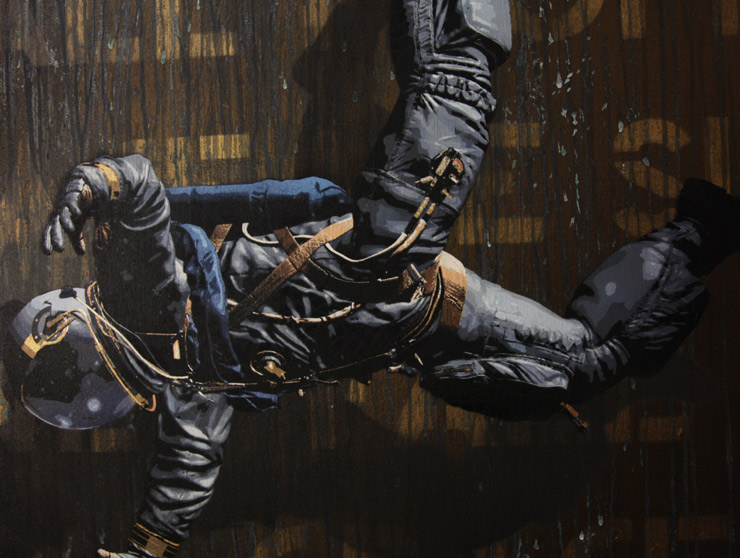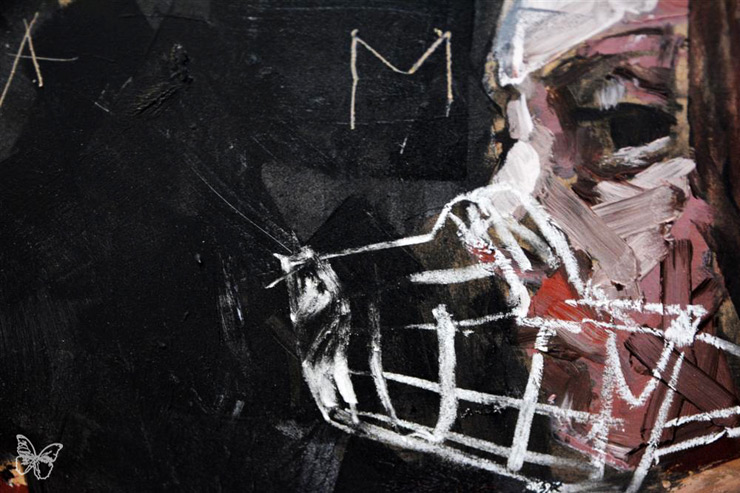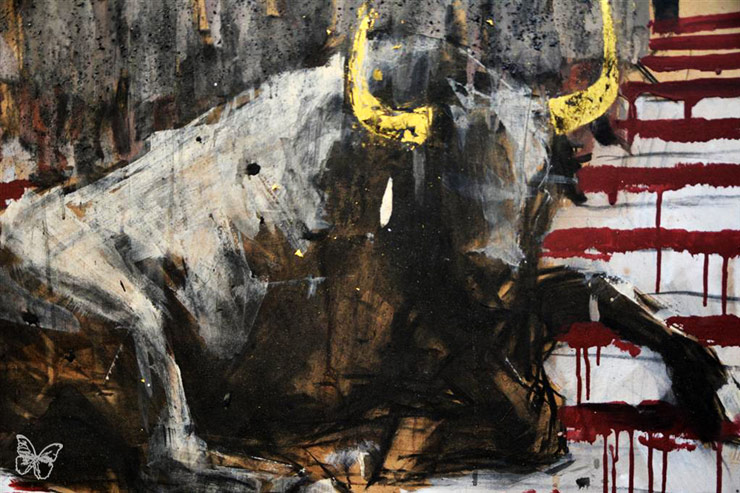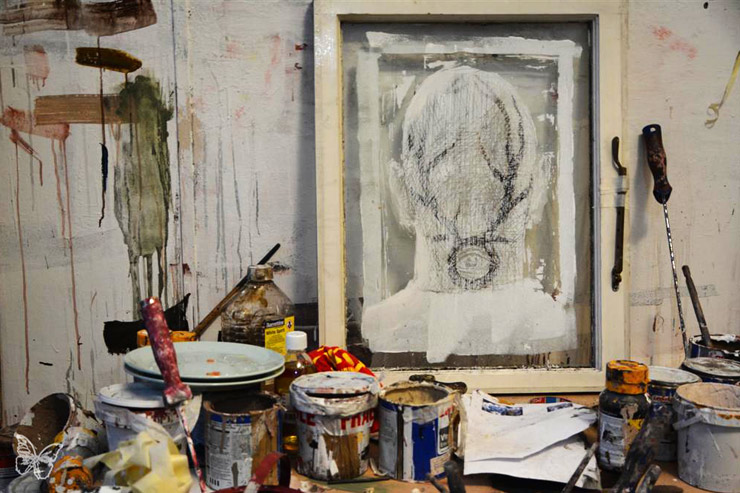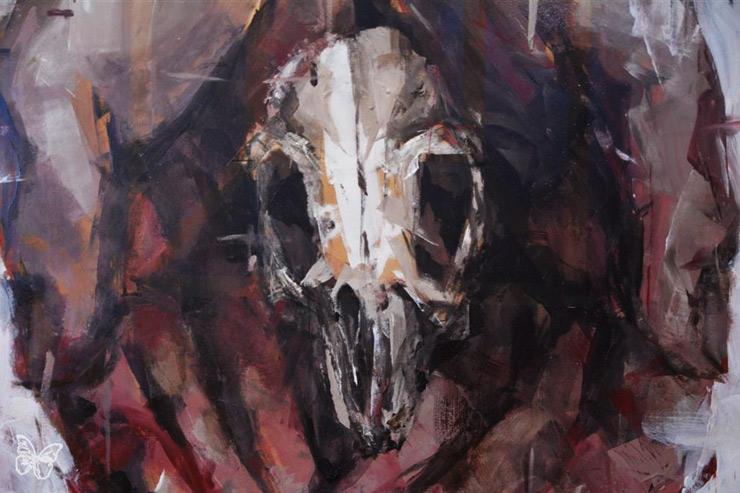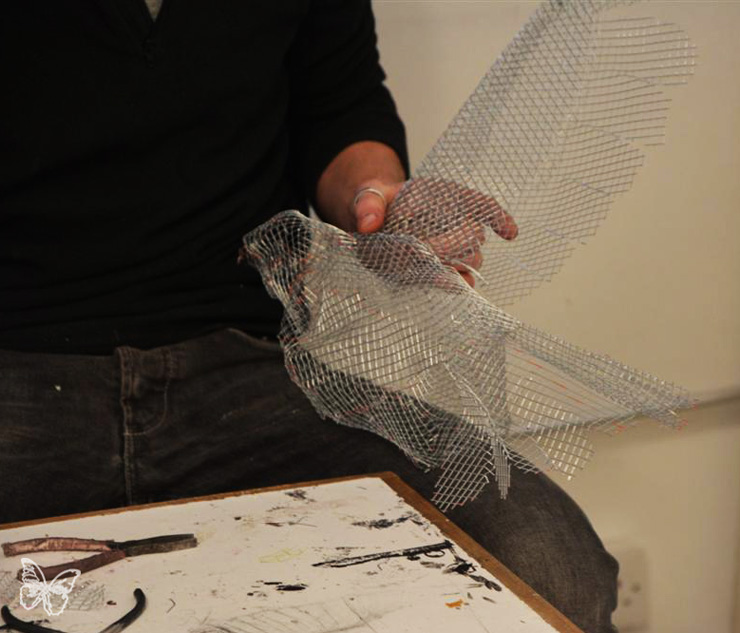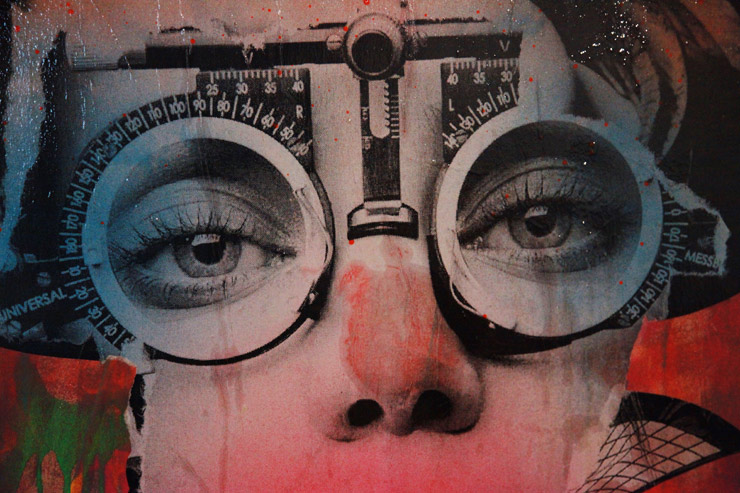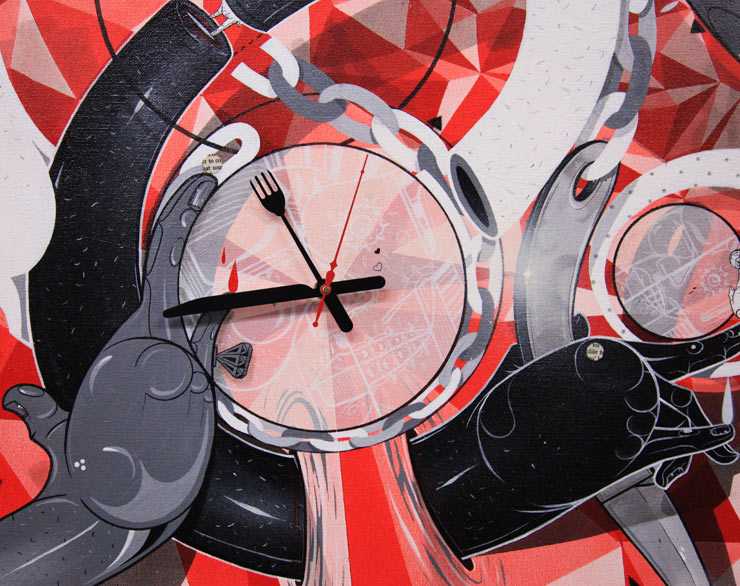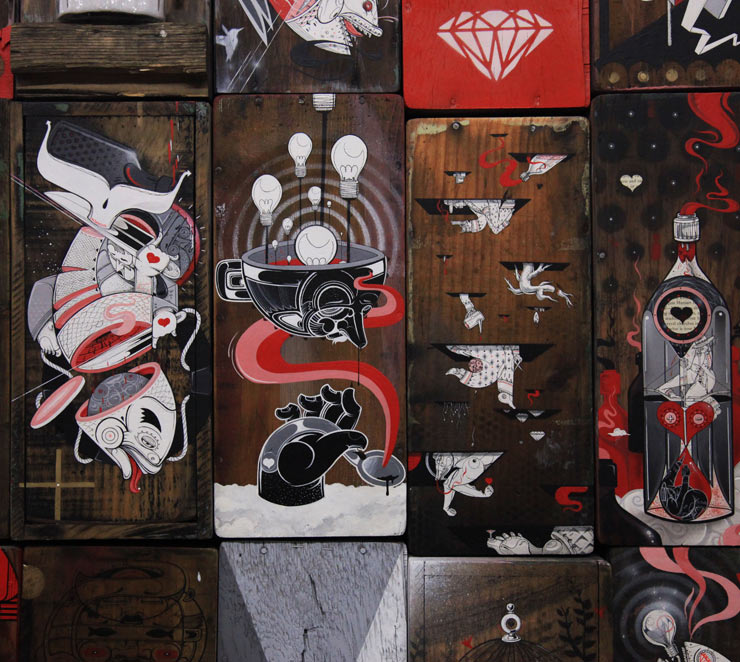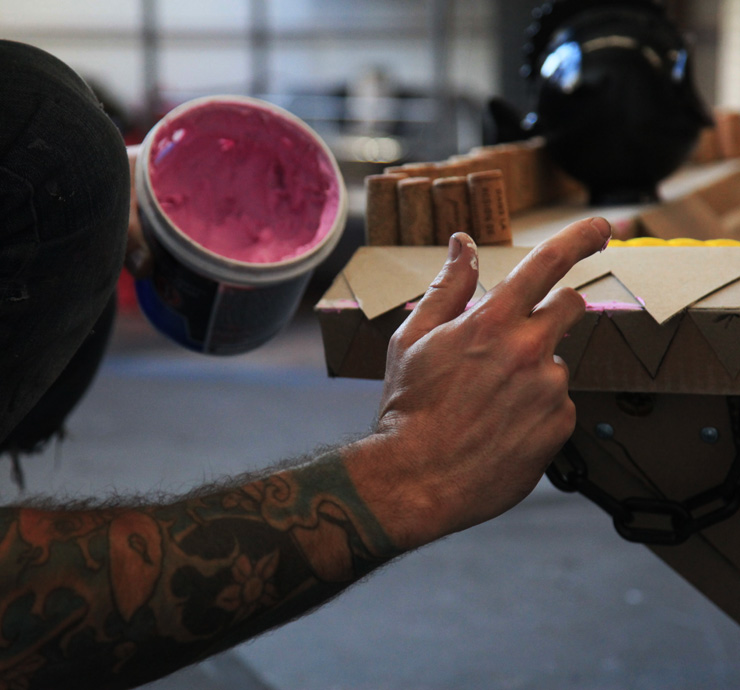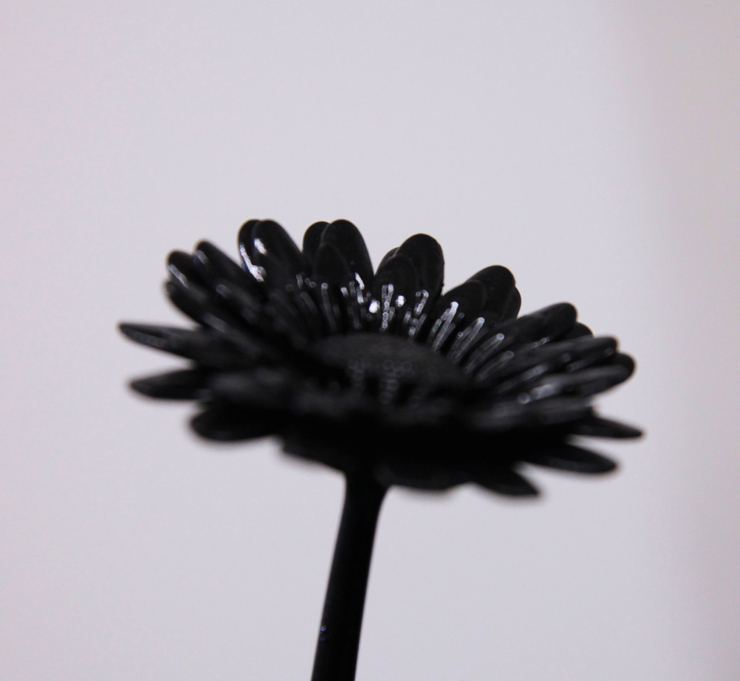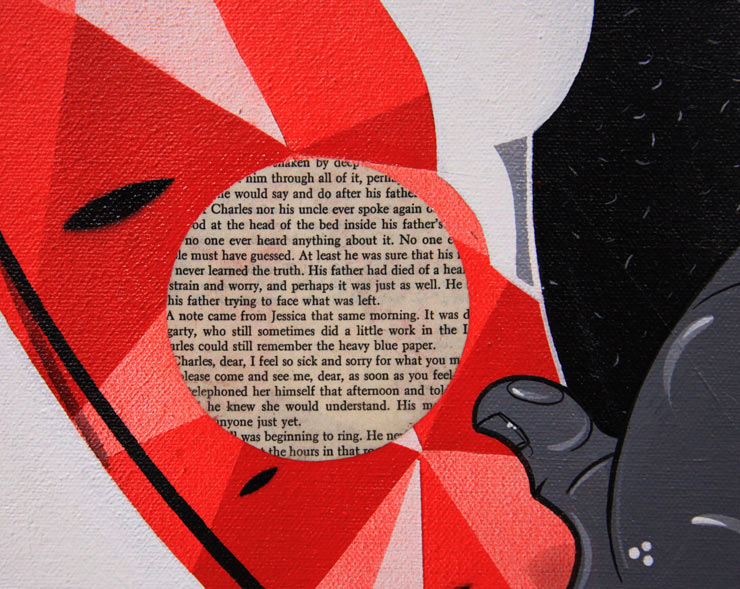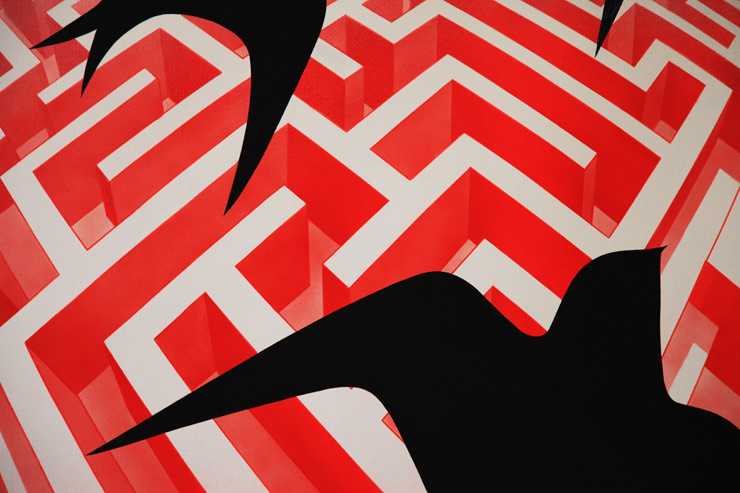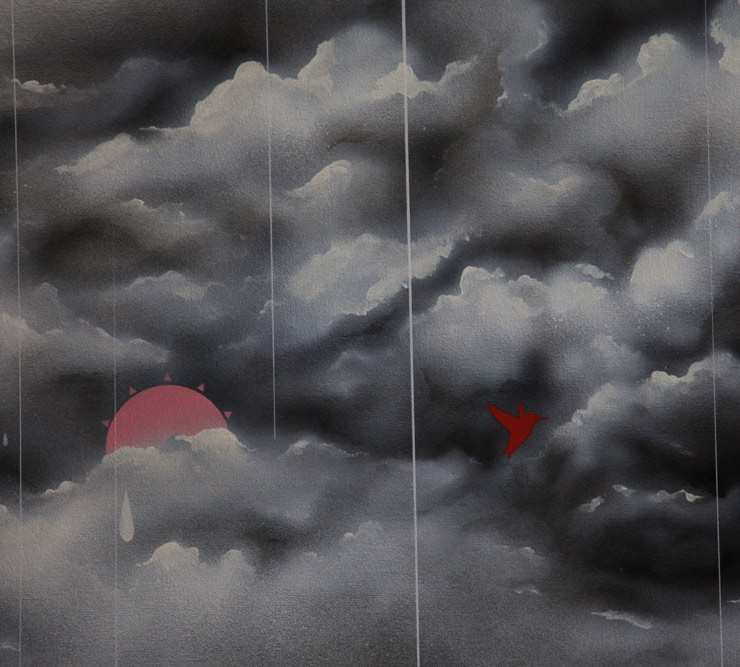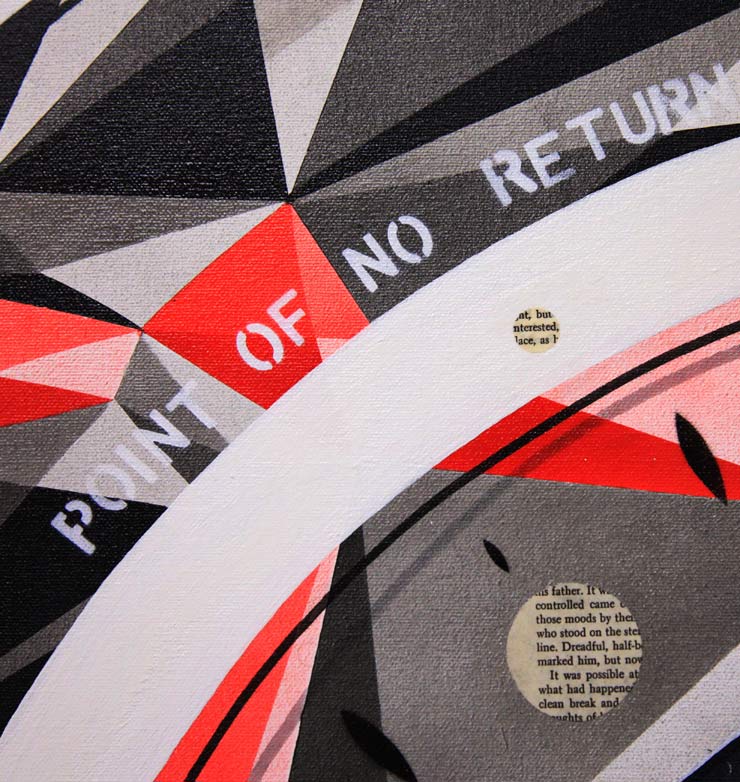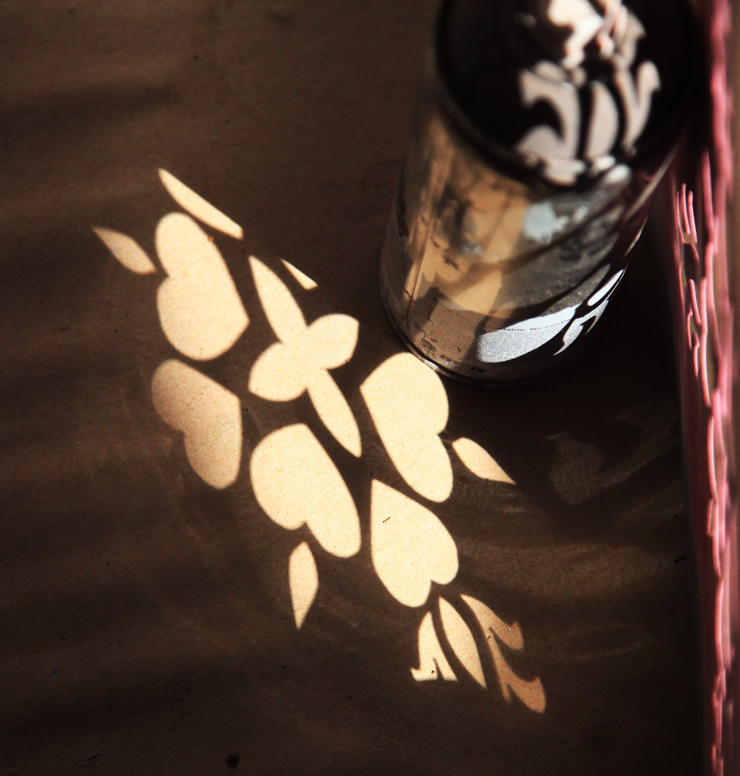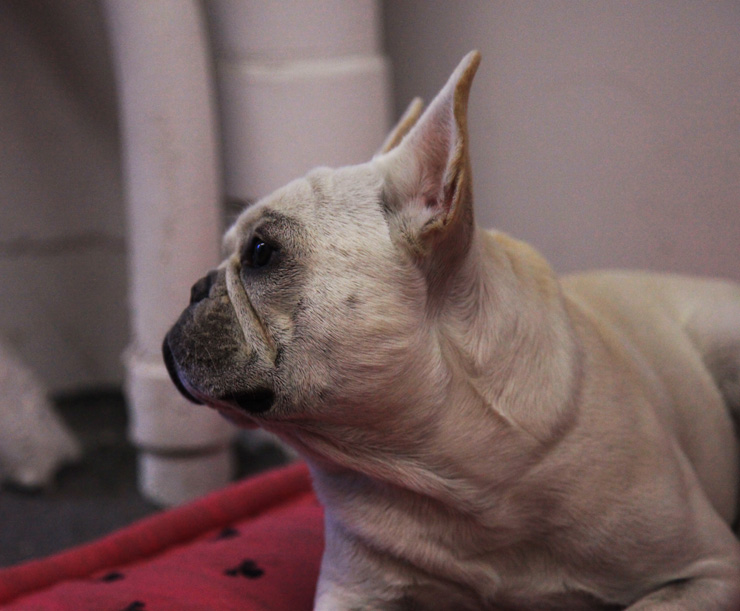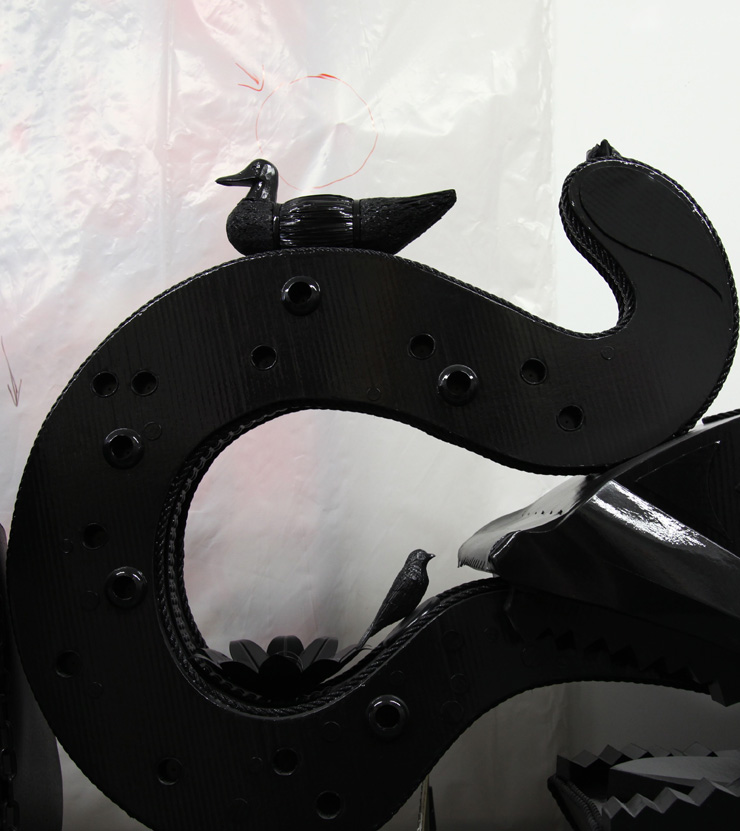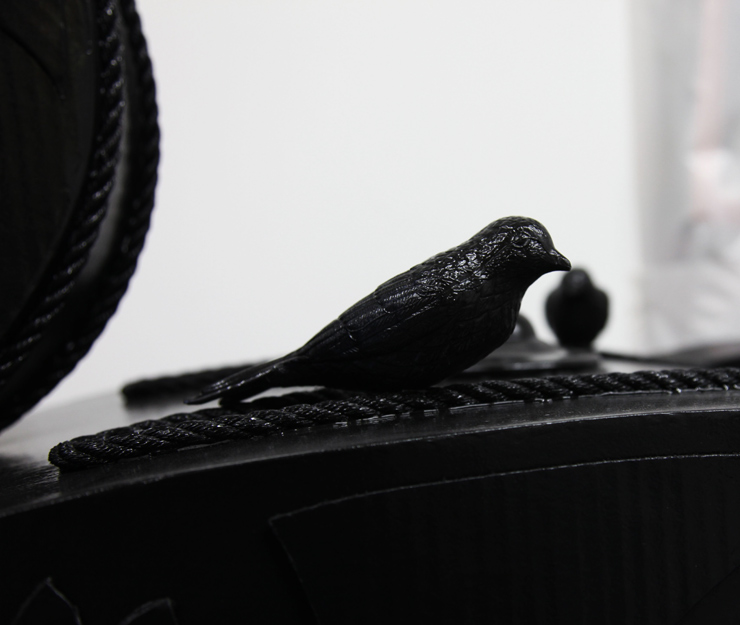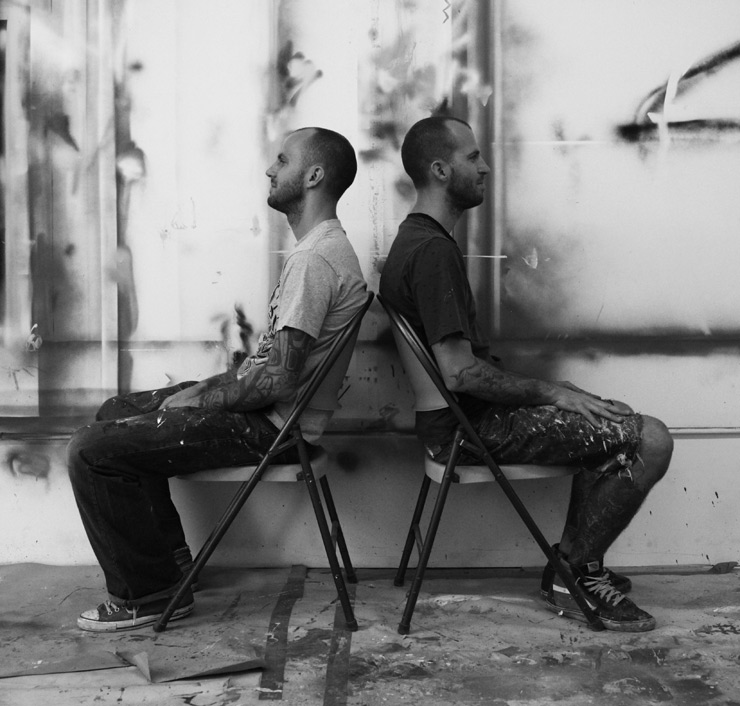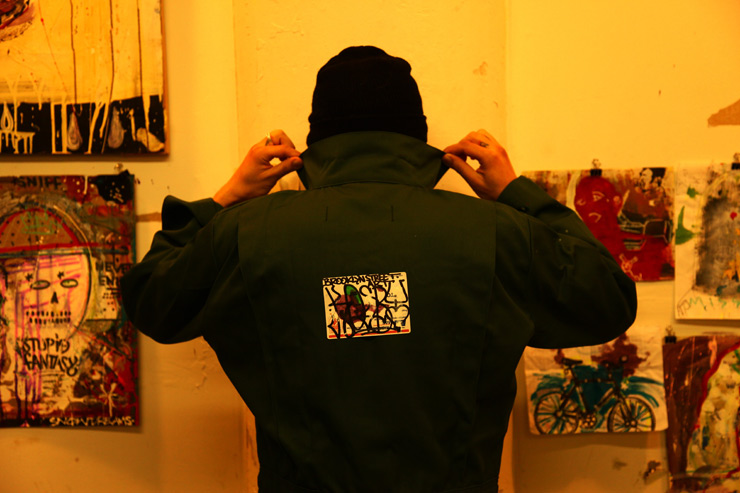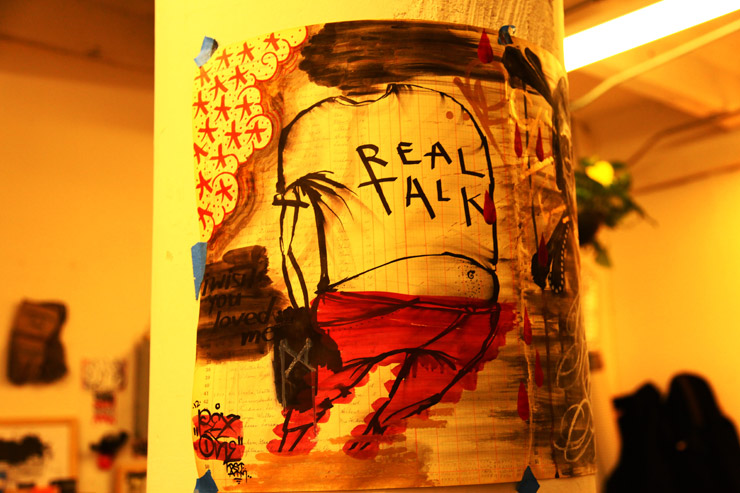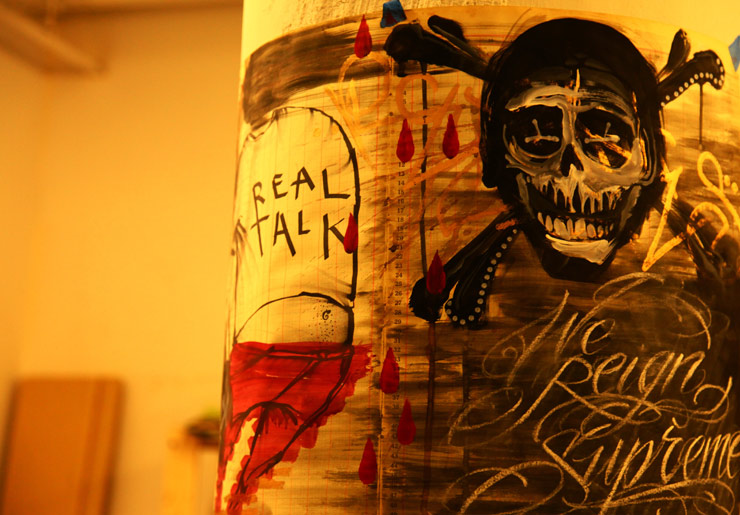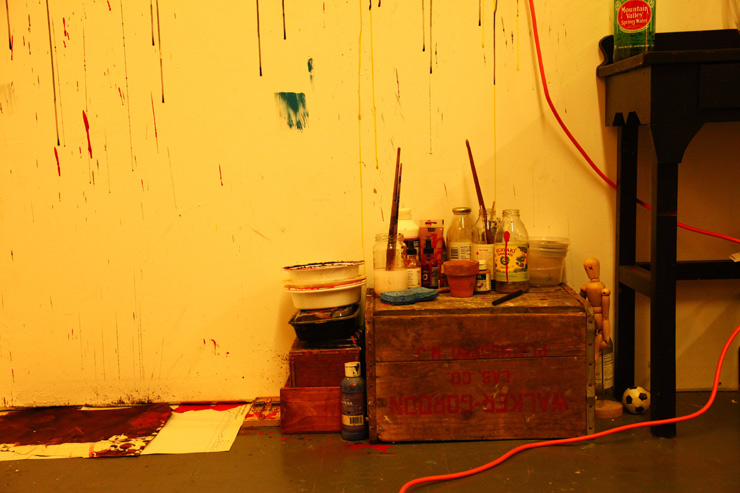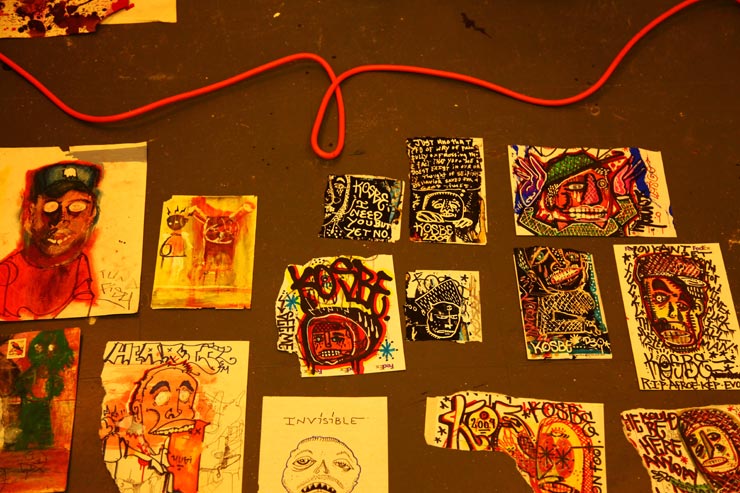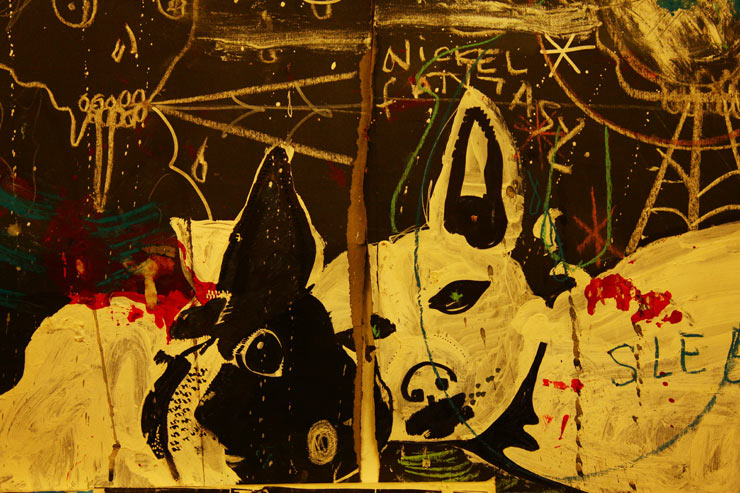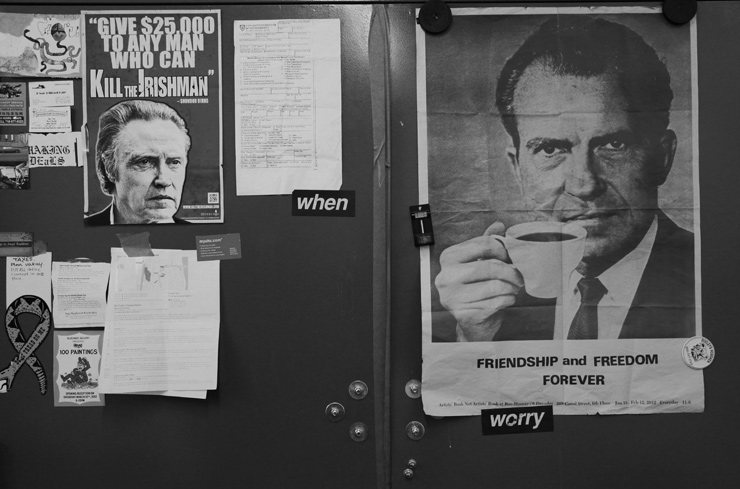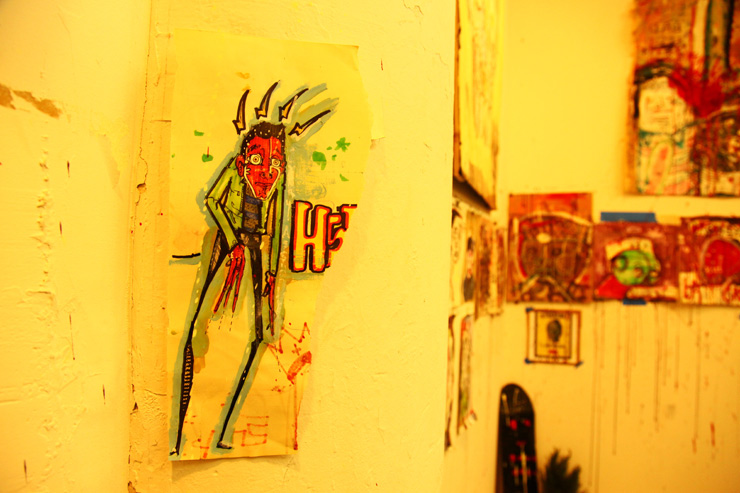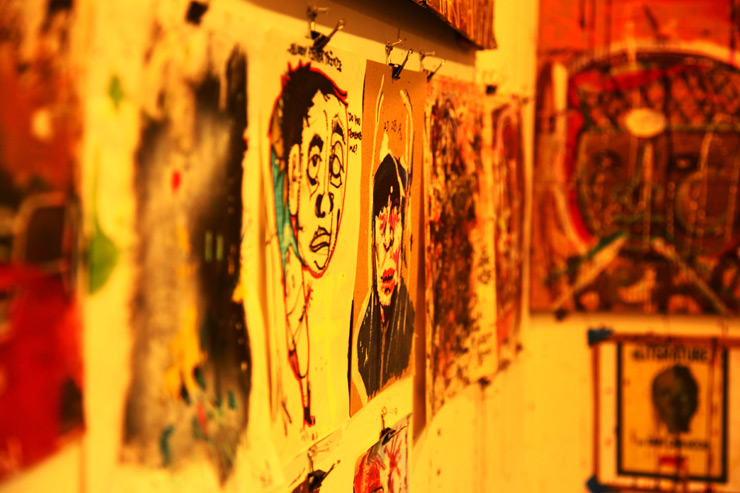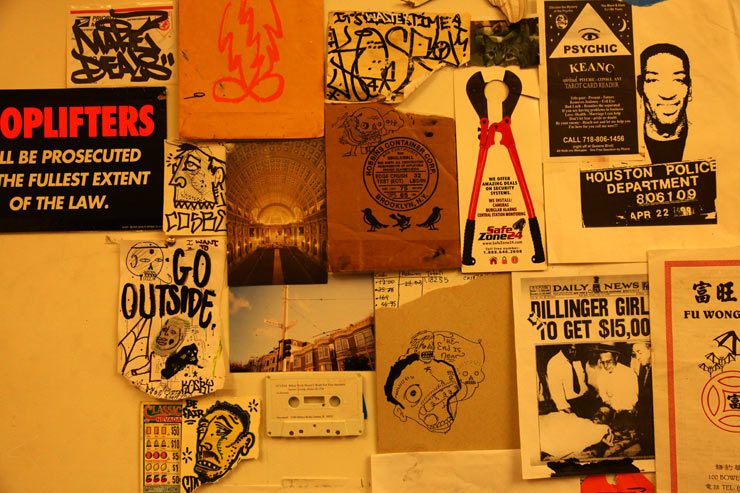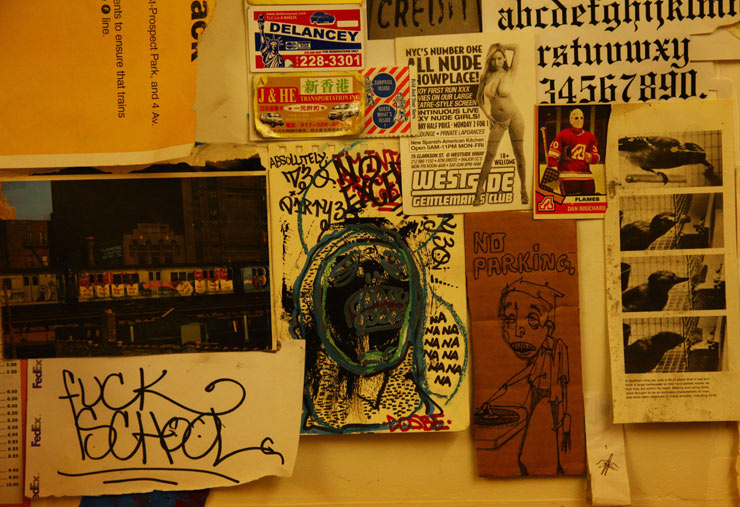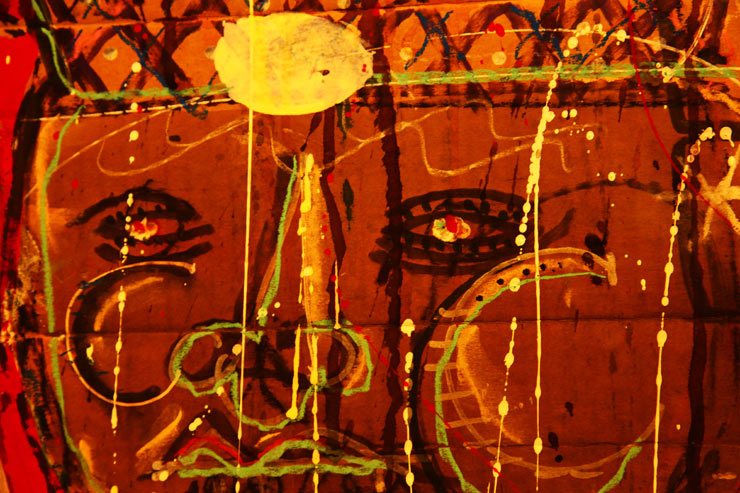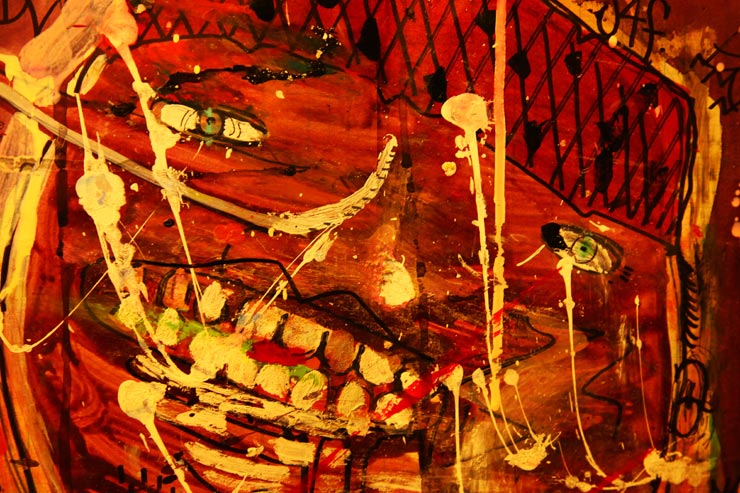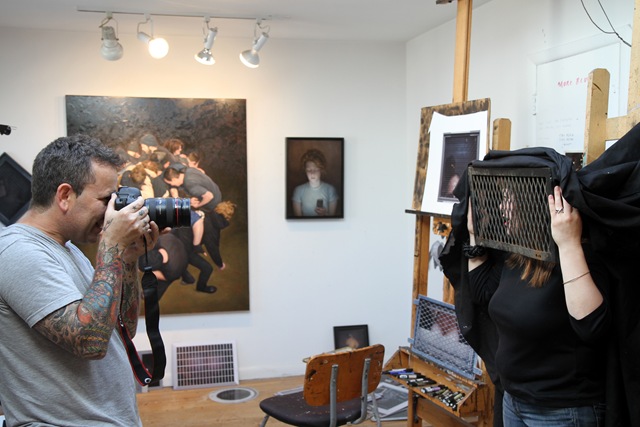“You’re not taking pictures of me right? I’ll kill ya. I got a coffin upstairs. You’d look perfect in that coffin. I know that.” So begins our delightful first time interview with the elusive Brooklyn Street Artist DAIN. We’ve only published, say, 200 images of his work on the street over the last few years and written about his shows in galleries and occasional movements toward a commercial career, so we probably are respectable. But you know, sometimes a Street Artist is a little cagey and excited at first and when he says “kill” he really just means “choke you until you can’t breathe”.
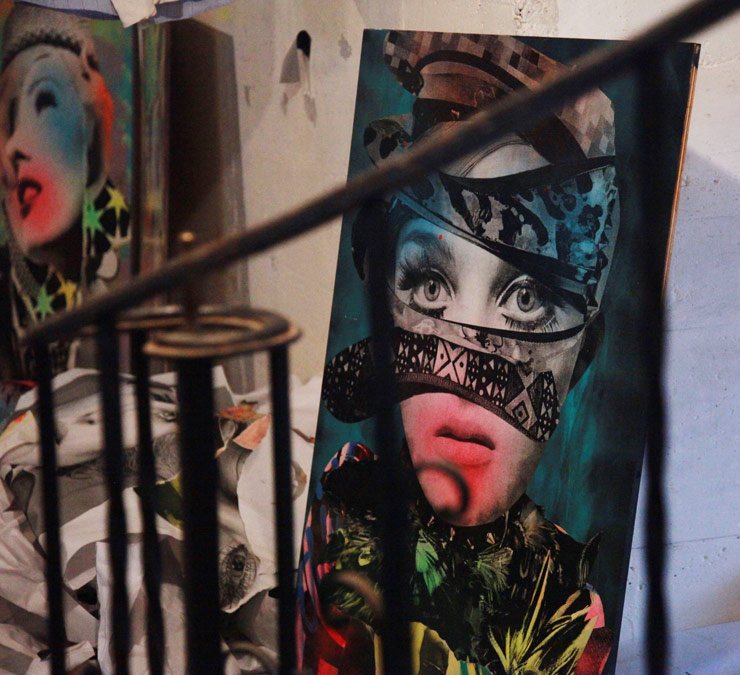
Dain (photo © Jaime Rojo)
We’re in the basement of a suburban home at the end of a dead end street and yes, we actually entered through the back stairs through the ivy strangled yard because DAIN says there is an empty coffin upstairs and he doesn’t want to scare us and it’s a long story anyway. Fair enough. At least we know it’s actually him when we see 10 canvases and the pinched pouts that breathe a smokey sort of sex yet mean all business. The low ceilings mean one of us has to duck and avoid hitting his head on pipes mainly because of innate clumsiness, and the floor is scattered with cut pieces of black and white limbs, painted faces, blank expressions.
“For me it’s always about the eyes. The stare,” Dain explains about those women you have seen in doorways throughout Brooklyn and lower Manhattan, composites of many. “I like happy people but I like something that is staring at me, or maybe staring away,” he says as he talks about the idealized beauties he’s been portraying in stilted, curvaceous sometimes colorized glamouuuuuur.
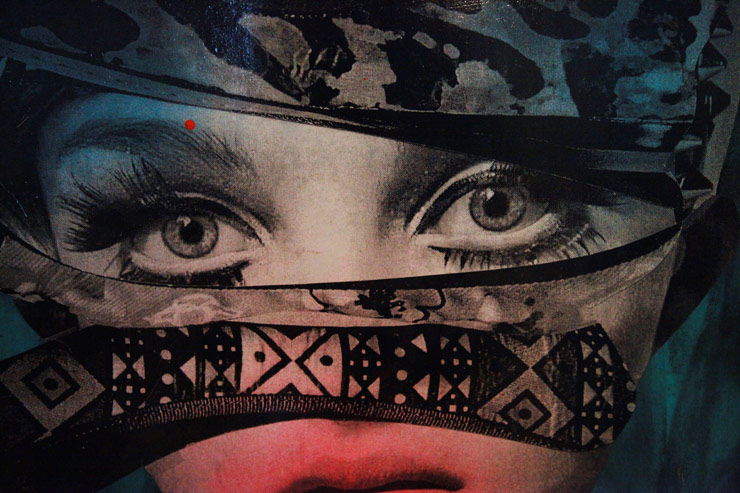
Dain. Detail. (photo © Jaime Rojo)
“You know what’s funny, people have said, ‘Oh your work is so sexy’ and this and that. But the thing is I never show a woman’s body. It’s always a woman’s face on a man’s body, usually. I think women sell themselves short. They think they have to take off all of their clothes for someone to love them – but if you keep your clothes on people still love you,” he says.
In Twiggy’s case, she has kept her shoes on – her head. This image is sort of the siren of the group, which includes more full body shots than in the past, and since this show is going to Italy at the behest of Silvia Fendi as part of the Altaroma shows, the sixties icon seems quite comfortable. Hey, if the shoe fits.
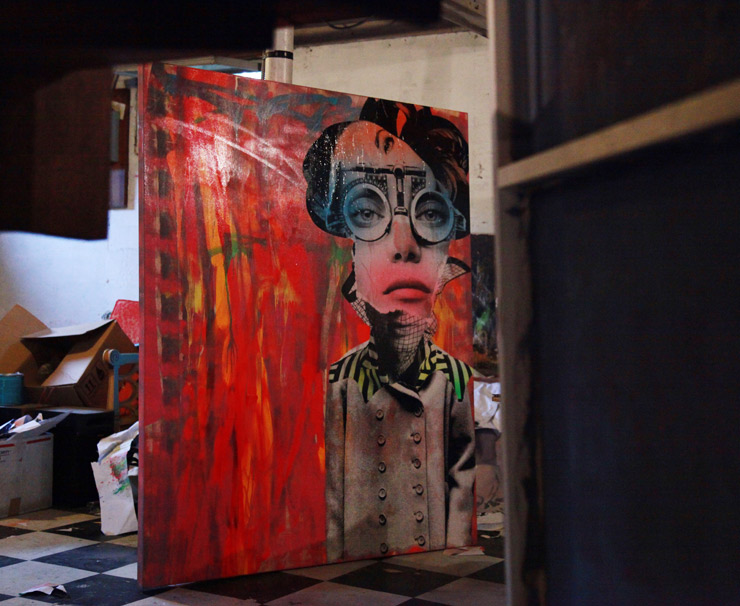
Dain. (photo © Jaime Rojo)
Brooklyn Street Art: So tell me about this – It looks like you make this large collage figure with all of these different pieces, and then assemble them on the canvass – is that how it is done, can you talk about the process? DAIN: You gonna be giving away all my secrets?
Brooklyn Street Art: Look, I’m observing here.
DAIN: Okay I’m going to put it all away! Well, what do think they are? What did you think they were?
Brooklyn Street Art: When I see them on the street, you know you make a story in your mind, I thought that you first make these collaged figures at home, then you scan it as one piece, then printed it and then hand colored it.
DAIN: Gotcha. Usually for the street it is something like that. But for the work here usually there will be three or four images together. I used to do the whole background collage but now I’ve been painting the background. Like these pieces here I love the painting I love the colors in there. I would like to do even bigger pieces because I think the painting itself, there is something going on in there, and then you have the image. This I really love. This right here is probably four different people in this image. This is Elizabeth Taylor here, the head, you see her face here. You got another face here and another face here, and then a different body.

Dain. Detail. (photo © Jaime Rojo)
We go through each one of the canvasses in no particular order, bouncing back between one and the other, remarking on the colors, compositions, the coolness, the size. The figures are confident and yes, can be very sexy in a cyborg sort of way. He has also been adding patterns and some geometric forms that recalls some of the op art from the 1960a. DAIN explains that he is going bigger than ever before and he is actually leaving more space in some cases, courtesy a hand painted background that sometimes references his days doing graffitti. These are some of the newer developments, along with the inclusion of more of the body of his figures rather than the busts you have grown accustomed to.
We talk about some of his different phases as a Street Artist during the last decade or so and scattered boxes full of old framed somewhat campy pieces and an early screenprint of boxers lie on the floor at the perimeter of the tiled floor as reminders. There is even a small handful of silkscreened t-shirts hanging from a water pipe, and something reminds us to bring up the John Kennedy smoking a cigarette piece that once appeared in a doorway, but DAIN is focused on the present and the future right now.
“Okay, now I’ve just moved into the ladies. I hope my work is getting better. I think its getting better. That’s my goal, getting better and better.,” he says. “I’m doing a lot of painting.” And that is why you’ve been seeing it more in galleries lately – at Folioleaf in Brooklyn this spring and at Avant Gallery in both their Miami and Manhattan locations.
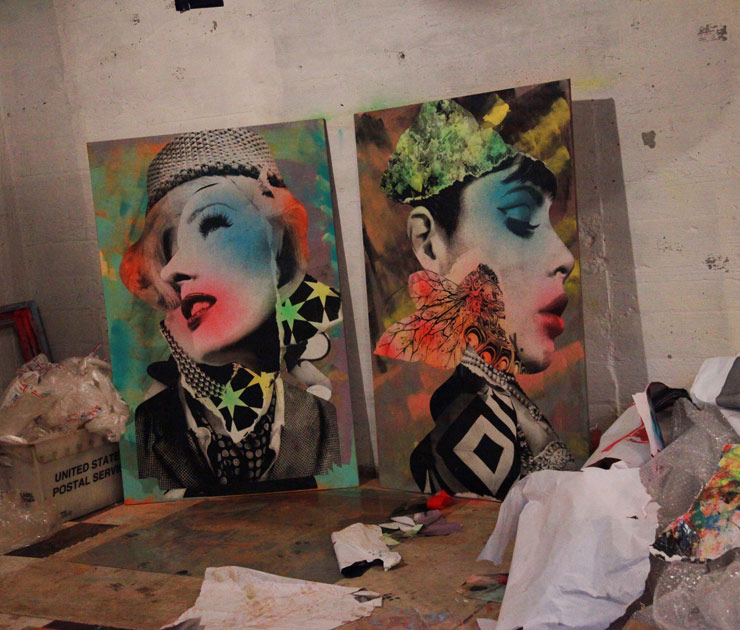
Dain (photo © Jaime Rojo)
It wasn’t what he started out to do as a graffiti-writer-turned-Street-Artist and it still boggles his brain a little bit.
“It was just fun. It wasn’t like I thought I was going to be showing at galleries. Who’s thinking of that? I mean I was just in a gallery on Madison Avenue and I’m thinking like ‘this is hilarious’.”
Does he like the experience of being in a gallery as well as the street? “I actually like it because I remember when I first got started and people where doing these street art shows and people just threw everything on the walls and it’s a mess. Not that I’m like – I mean I’m a nobody – but I just like my work to be displayed well,” he says.
The new show is well underway, and his new hand painted, sometimes graffiti tagged, backgrounds are allowing more psychological space around his ladies, giving them opportunity to express their plaintive, mystical, multiple personalities. The press release for Saturday’s opening for DAIN | Tribute to Rome accurately describes the hybrids as suggesting “a nostalgia for a recent, timeless past where faces emerge from an atmosphere of seeming bewilderment.”
We ask him about this exact thing actually.
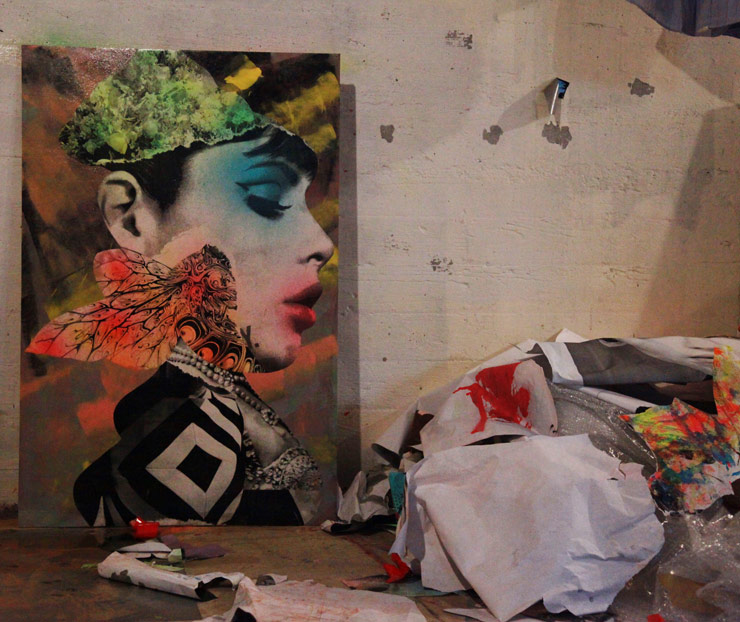
Dain (photo © Jaime Rojo)
Brooklyn Street Art: Remember when you did that year-book photo stuff on the street? It was like a series of class photos from 1940s yearbooks and it was interesting and also it was interesting that you would find it appealing in some way.
DAIN: I love that stuff. I love black and white. You use your imagination in black and white.
Brooklyn Street Art: You like movies?
DAIN: I love “The Honeymooners”. I love “I Love Lucy”. You know, when I watch “The Honeymooners”, is Alice wearing a red top? I know she’s got red hair but what does this woman really look like? You’ve got to use your imagination. Now the image is thrown right at you. Kids today they don’t even think, their so riveted.
Brooklyn Street Art: No they don’t even seem to process it, they just absorb it. So your stuff really evokes another era. Is that something you have thought through or is it just something you feel and it just comes out?
DAIN: I guess it just comes out. I love simplicity. I love the 40s, the 30s, the 50s. You know I don’t do Instagram, I don’t do any of that.

Dain. Detail. (photo © Jaime Rojo)
Brooklyn Street Art: So why are you nostalgic for a time before you?
DAIN: I guess maybe my folks. They’re from Brooklyn. Coney Island. And they’re kind of caught up in that. One of my favorite movies, if I watch a movie, is On the Waterfront. I remember being a little kid and my father telling me “You gotta see this movie” and he put it on and it was in black and white. And I was like ‘”You kidding me? This is in black and white!” and years later I really appreciate it.
Brooklyn Street Art: So you grew into it.
DAIN: I think I grew into it.
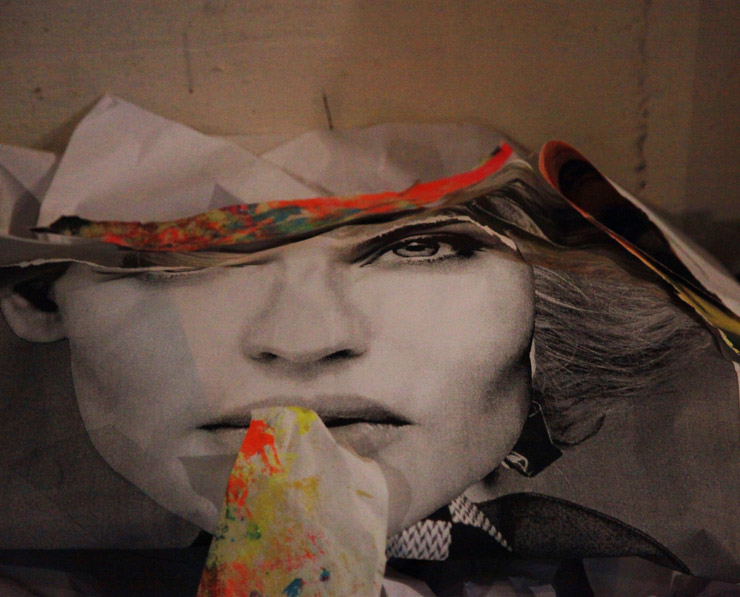
Dain. Shot from the “trash” pile. (photo © Jaime Rojo)
He draws attention to the fact that none of the new gallery canvasses feature his women wearing a circular monocle that drips fluorescently – a feature that many on the street know his works for. He appears to be ready to discontinue the practice even though we tell him that it is sort of part of his signature, even his tag. But he’s not sure.
DAIN: If you notice I didn’t put any drips on the eyes here. For some reason I didn’t start any drips.
Brooklyn Street Art: Do you think you are moving away from them right now?
DAIN: I don’t know. I don’t think people know me enough to know the drips.
Brooklyn Street Art: No I think that people actually do know your work partially at least because of the drips.
DAIN: You see I have no idea what’s going on out there, you know what I mean.

Dain (photo © Jaime Rojo)
Brooklyn Street Art: You started off doing graffiti?
DAIN: Yeah
Brooklyn Street Art: And it was a good experience?
DAIN: In those days there was crews, it was kind of hip. It was kind of cool. But there was a lot of beef in those days. I was a youngster, a teenager. I don’t know what goes on now. I don’t know if the guys still have the beef but back then there was so much beef. You couldn’t even go some places. You’d go over somebody and he’s looking for you and they would come at you. I mean it was crazy back then. So it was cool and then I left it but it’s one of those things where even to this day I’m always looking at graffiti, it’s just something in me.
Brooklyn Street Art: You never lose interest in it- from the way people talk about it.
DAIN: It’s like an addiction.
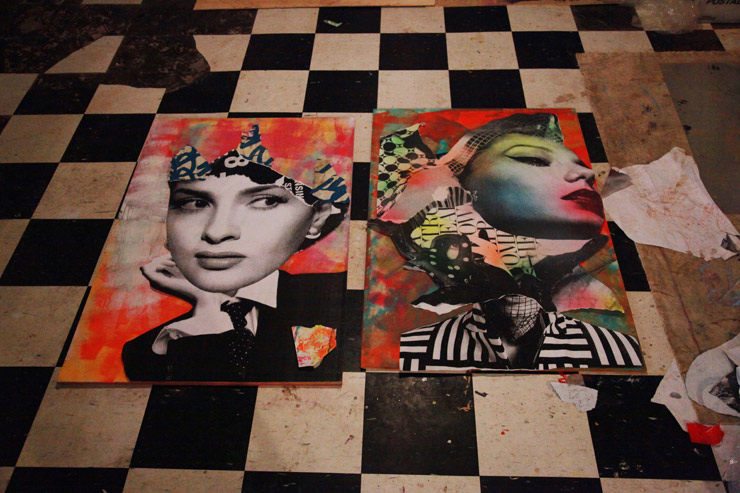
Dain. Work in progress. (photo © Jaime Rojo)
Brooklyn Street Art: Yeah it’s like even if you lose you hair, your ability to walk, you’re still like, “If you give me a chance I’ll go over and hit that wall right there”
DAIN: Yeah it’s amazing
Brooklyn Street Art: Just because there is some kind of adrenaline involved, it’s like a drug
DAIN: It definitely is so I still keep my eye on what’s going on out there. Especially these old school guys, like when I was younger – like this guy Fib, DC, I don’t know if you’ve ever heard of these guys. But when I was a kid they would write everywhere. See everybody knows about the subway scene from back then but there was such a huge scene just on the streets, the highways. The buses were bombed, the sanitation trucks were bombed – I mean everything was bombed back then and I’m starting to see guys who are 40-50 years old who are starting to write again. It’s amazing like 20 – 30 years later they’re coming back. These guys must be married with kids and everything else. It’s like something you never get over.

Dain (photo © Jaime Rojo)
In the end, the interview experience is great for everybody. Meeting a Street Artist who we’ve shot and talked about for years, and learning about some of those questions we had banging around our heads for a while. We do a little photo shoot – a little styling that keeps the anonymity and neatly avoids the aforementioned coffin. One shot features the artist crawling under a pile of discarded faces and limbs on the floor with DAIN’s feet sticking out at the bottom. “Like on the Wizard of Oz” he remarks.
So why did he finally agree to be interviewed in person and in studio? “I don’t know. I says ‘let me contact these guys. They’re Brooklyn Street Art, I am Brooklyn Street Art!’ ” which made us think we wouldn’t die after all.
We say our thanks to each other and he shows us to the back door again, where we stumble over a garden hose to get to the top of the concrete steps. He asks if we are going to let him see the article before we publish it.
Brooklyn Street Art: No, we never do that.
DAIN: You guys are killing me!
Luckily nobody was killed in the course of this interview.
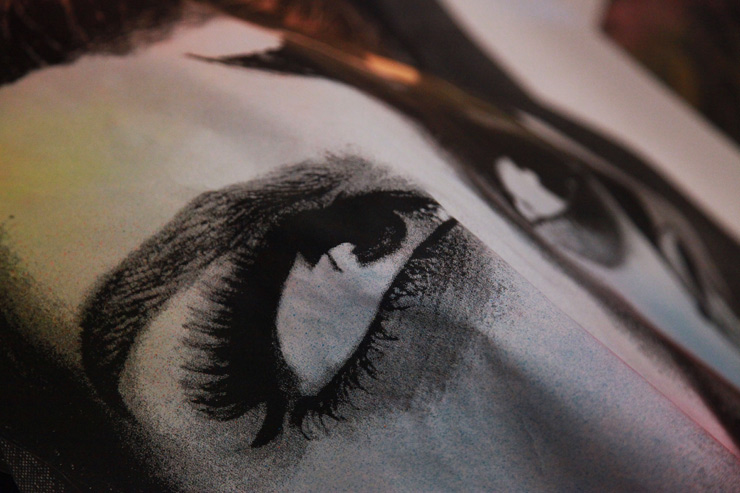
Dain. Shot from the “trash” pile. (photo © Jaime Rojo)
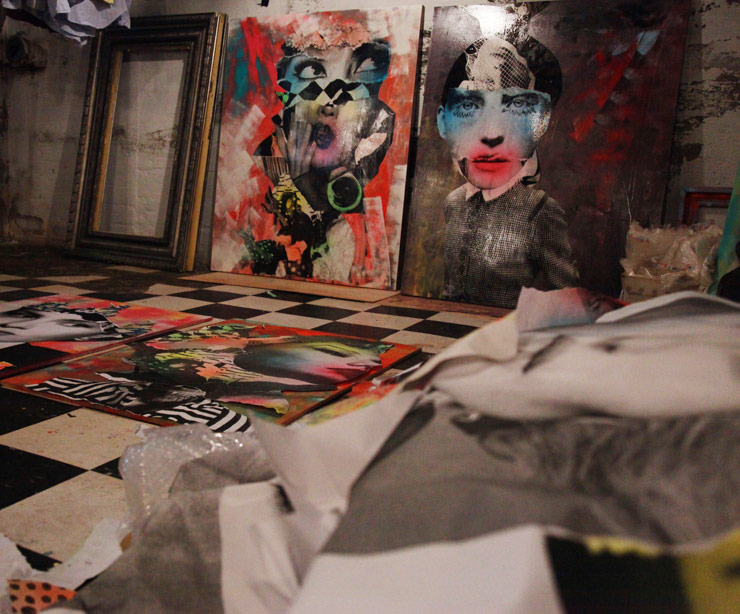
Dain (photo © Jaime Rojo)
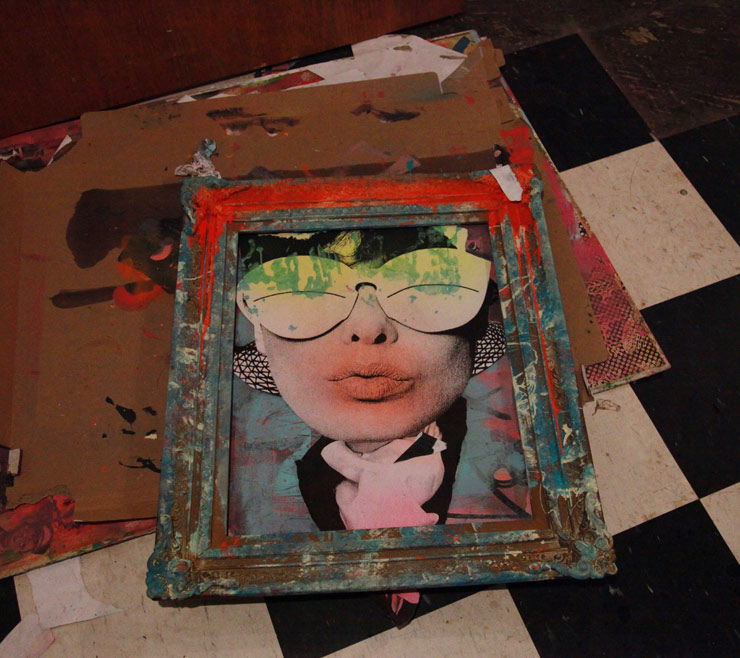
Dain (photo © Jaime Rojo)
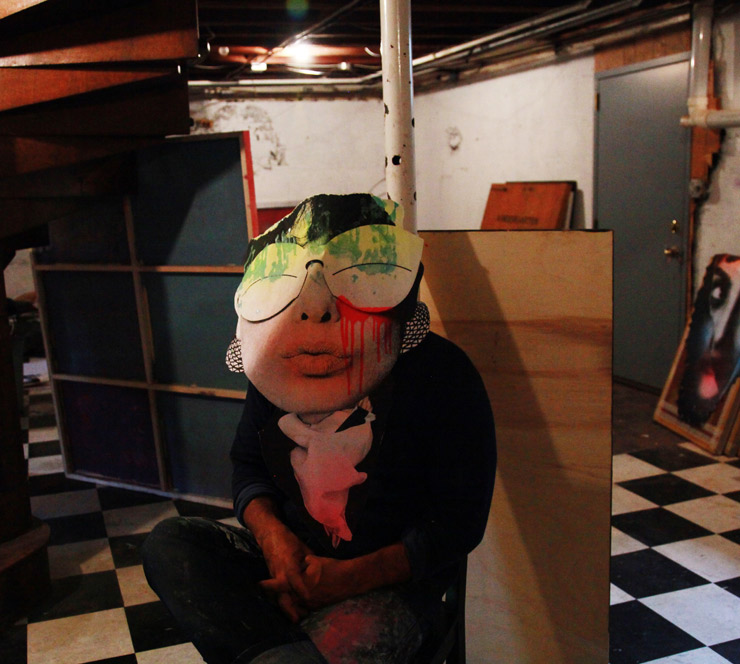
Dain sits for his portrait. (photo © Jaime Rojo)

Dain (photo © Jaime Rojo)
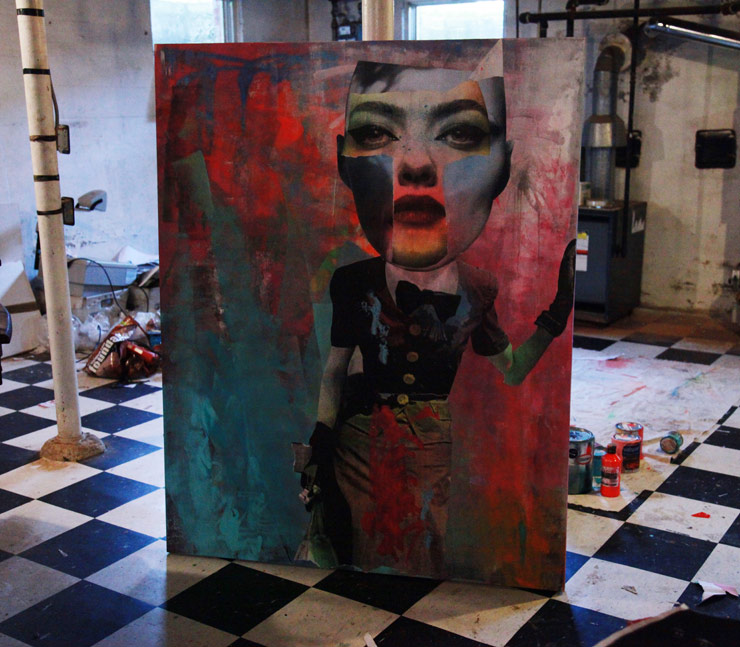
Dain (photo © Jaime Rojo)
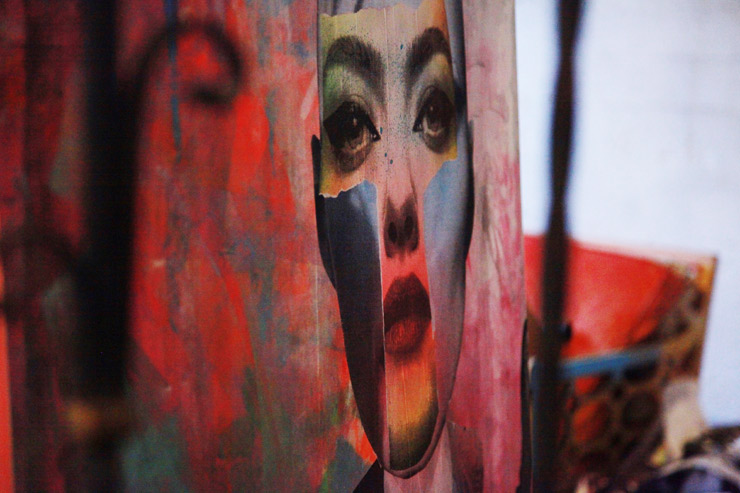
Dain. Detail. (photo © Jaime Rojo)
Dain’s exhibition “Tribute To Rome” will open in Rome, Italy on Saturday, July 12. Click HERE for more details.
To learn about AltaRoma click the poster below:

<<>>><><<>BSA<<>>><<<>><><BSA<<>>><><<>BSA<<>>><<<>><><BSA
Please note: All content including images and text are © BrooklynStreetArt.com, unless otherwise noted. We like sharing BSA content for non-commercial purposes as long as you credit the photographer(s) and BSA, include a link to the original article URL and do not remove the photographer’s name from the .jpg file. Otherwise, please refrain from re-posting. Thanks!
<<>>><><<>BSA<<>>><<<>><><BSA<<>>><><<>BSA<<>>><<<>><><BSA
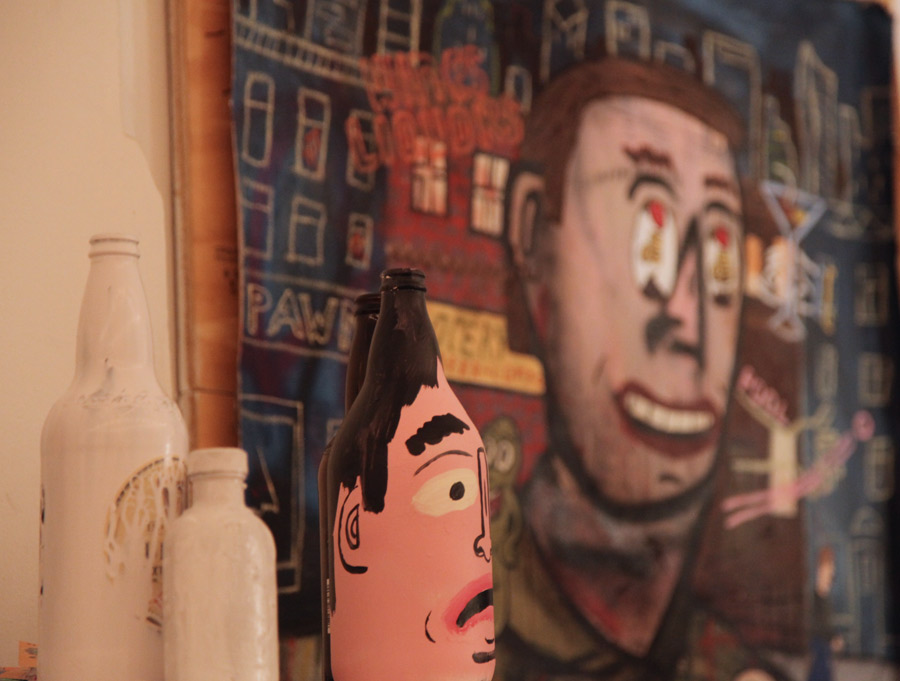
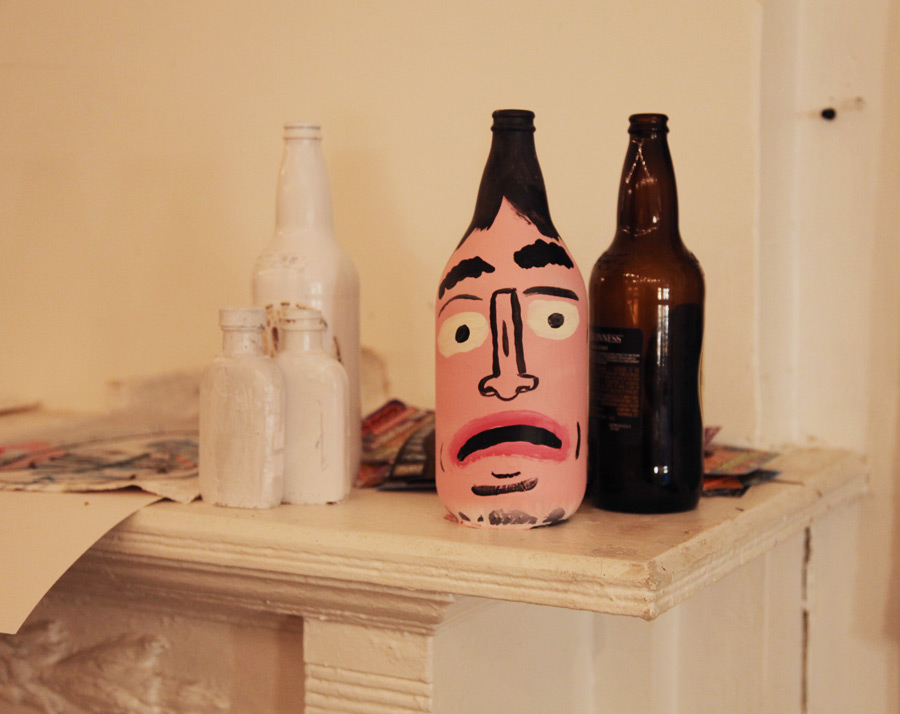
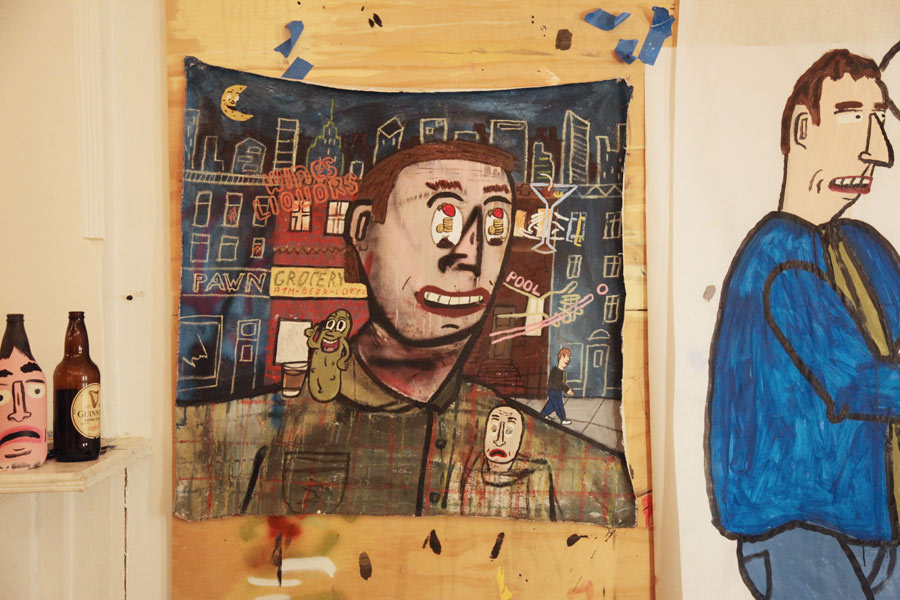
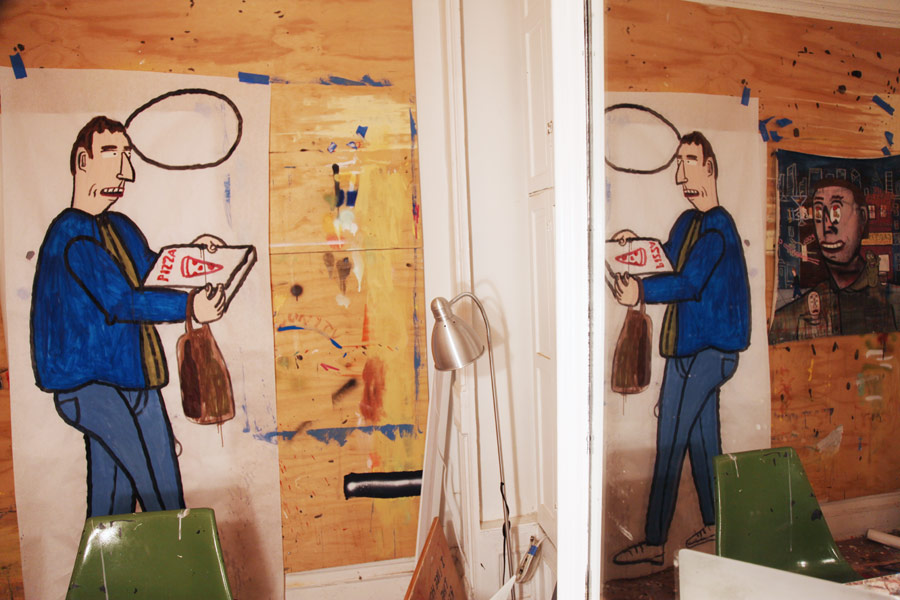
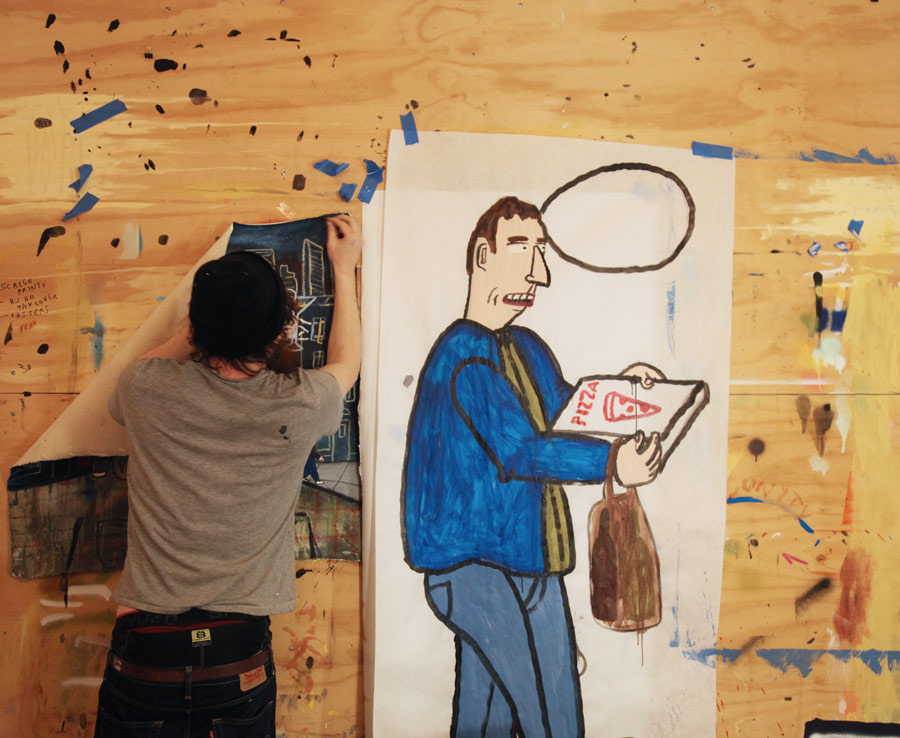
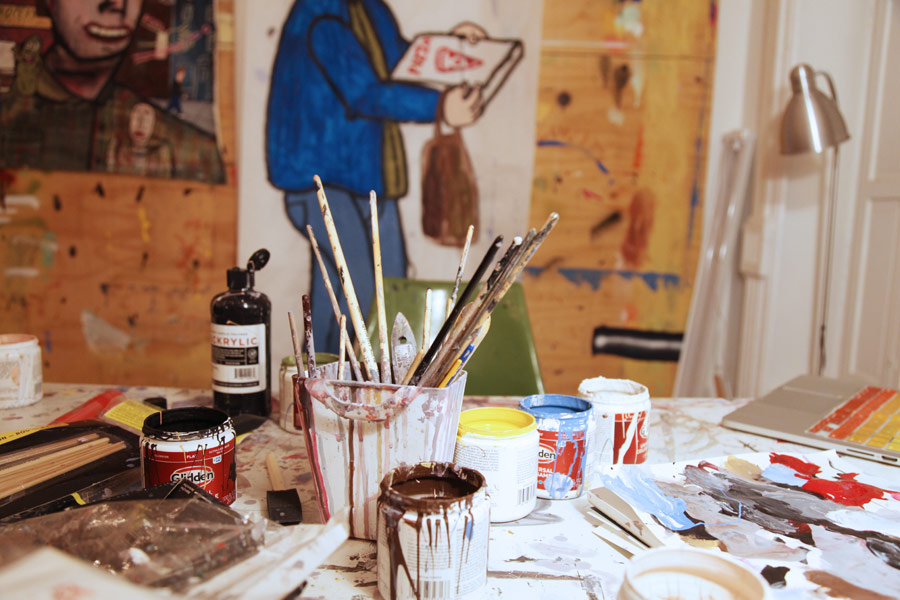
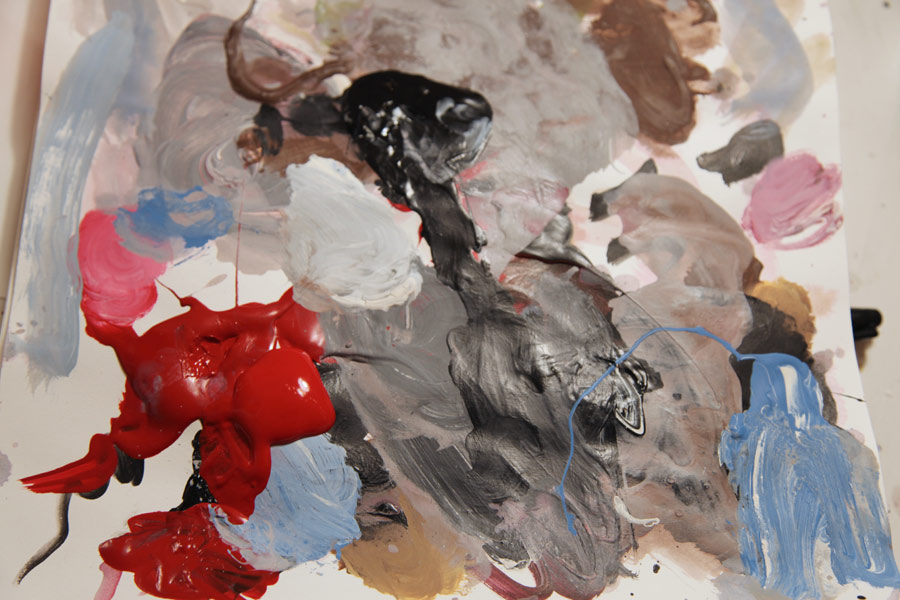
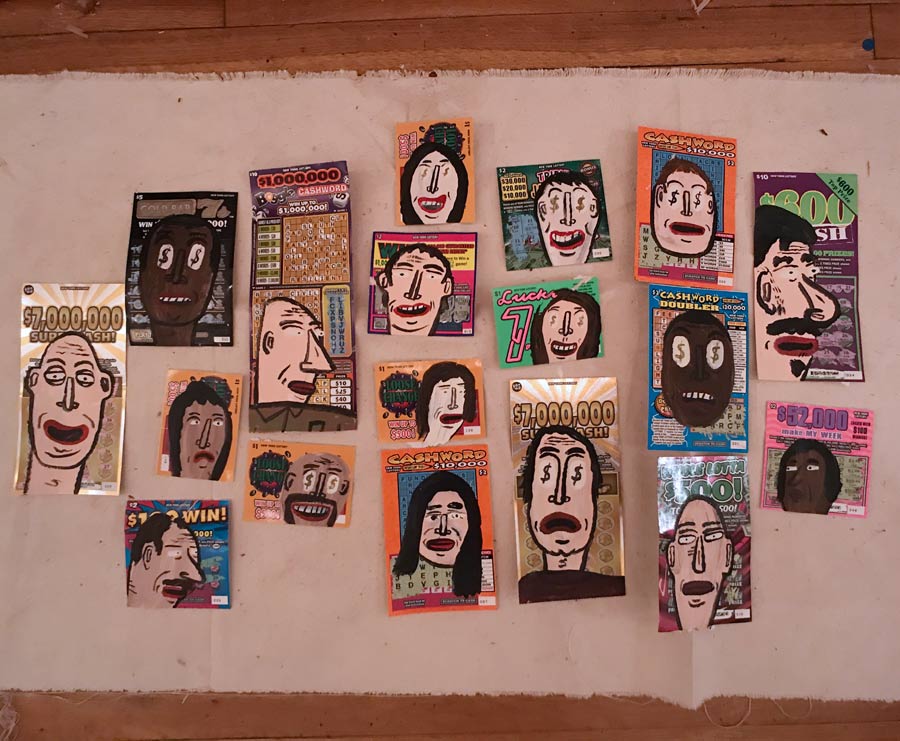
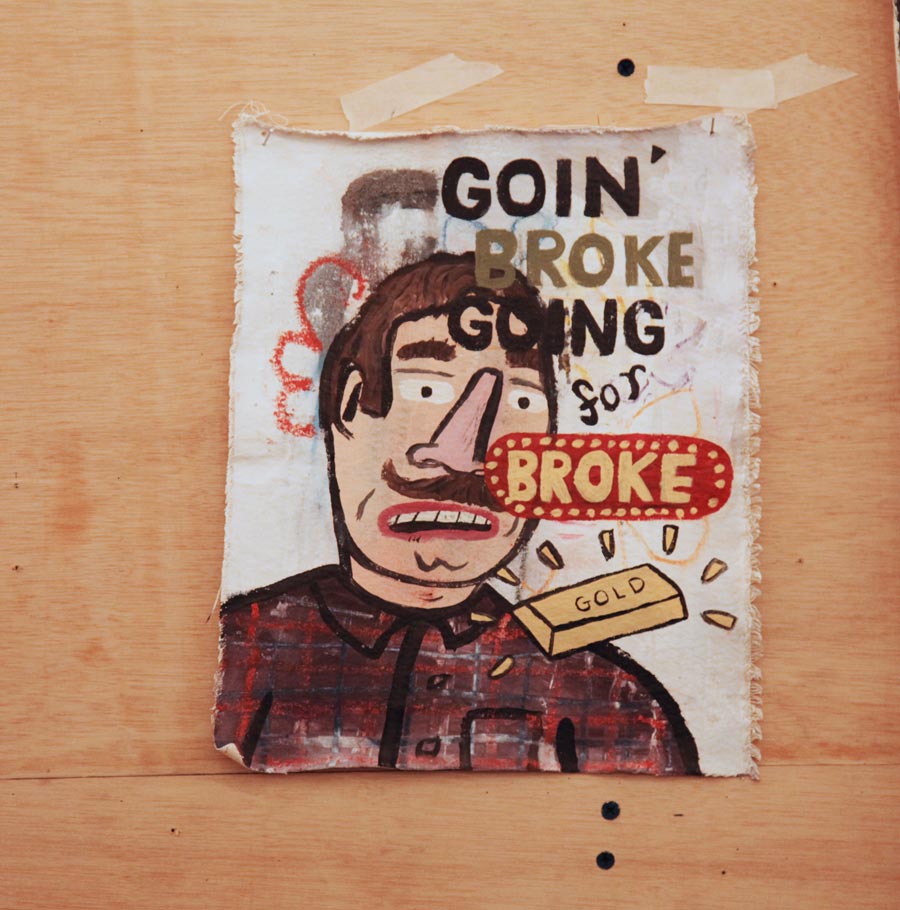
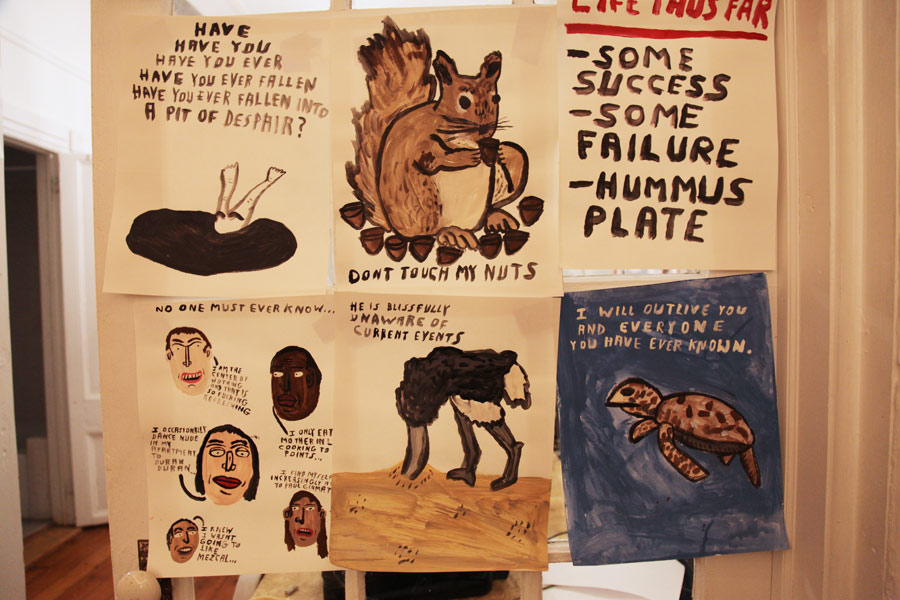
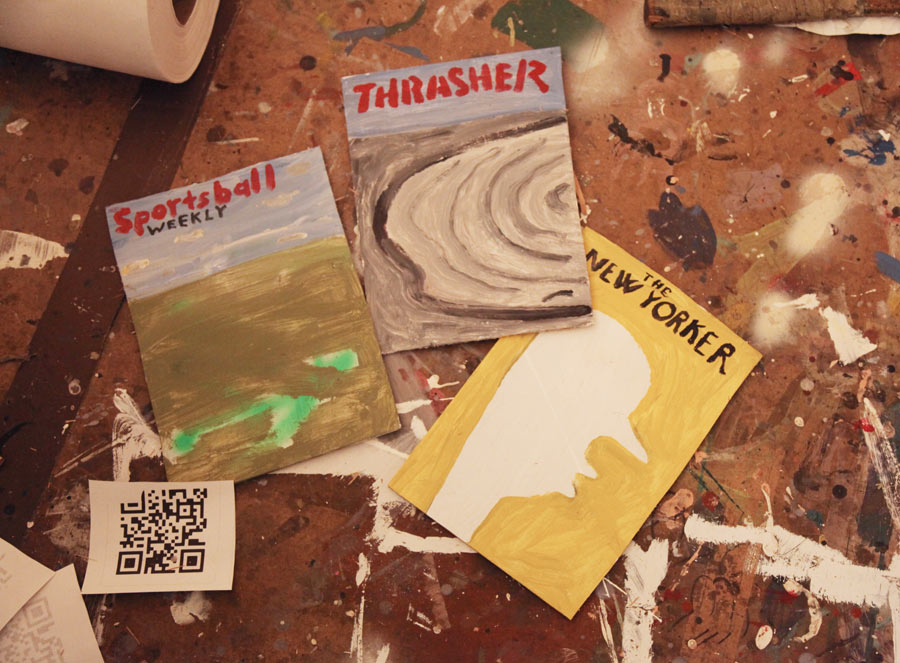
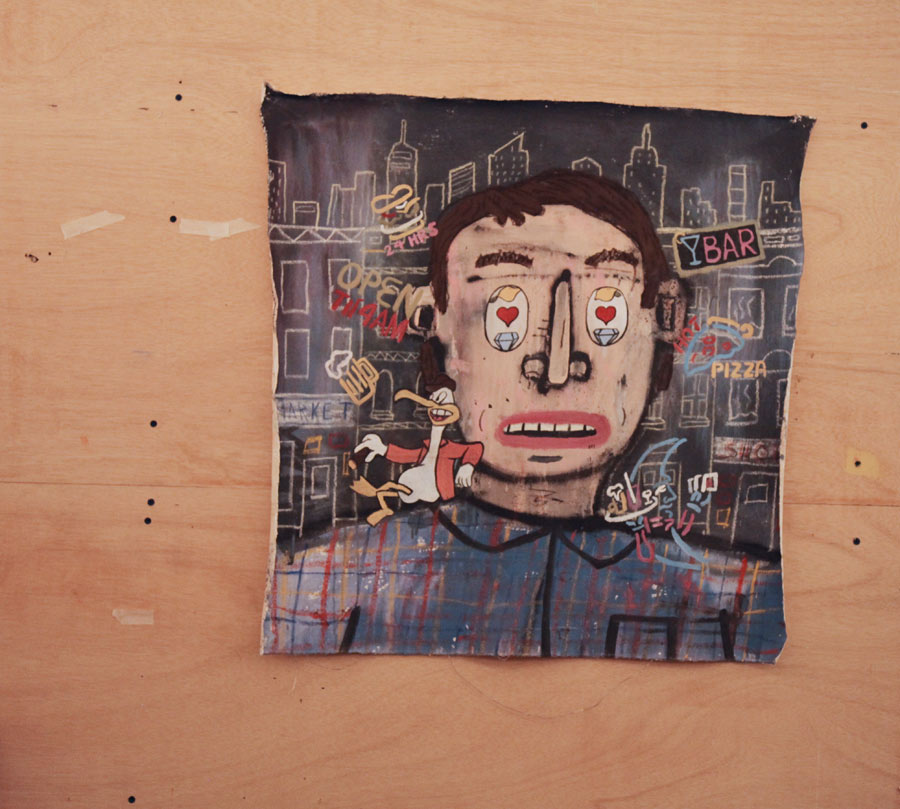
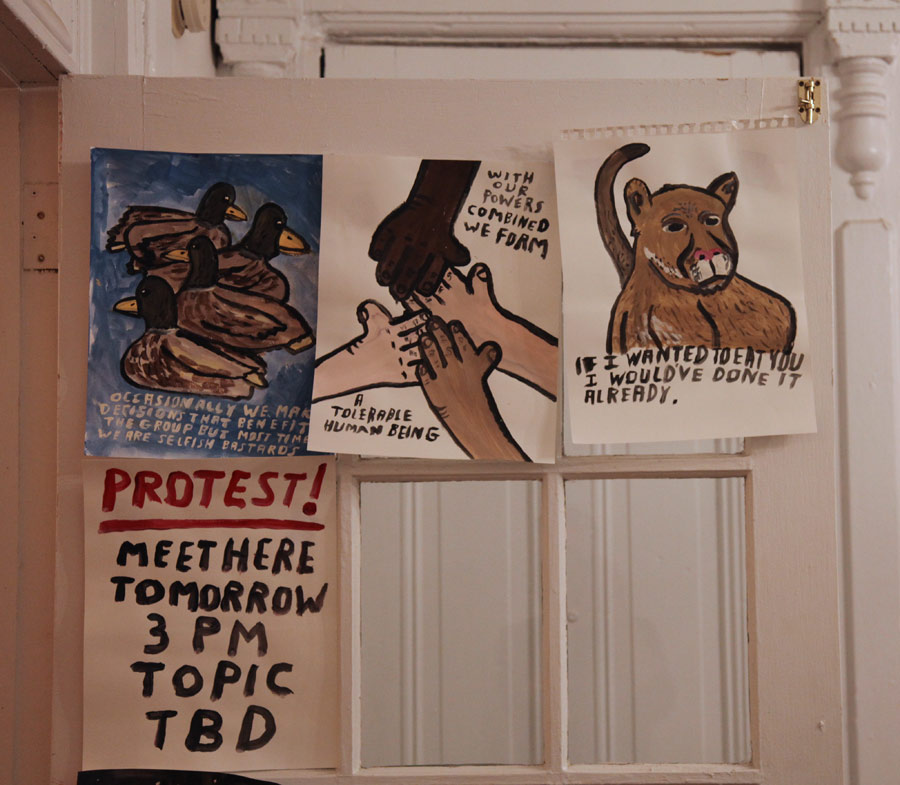
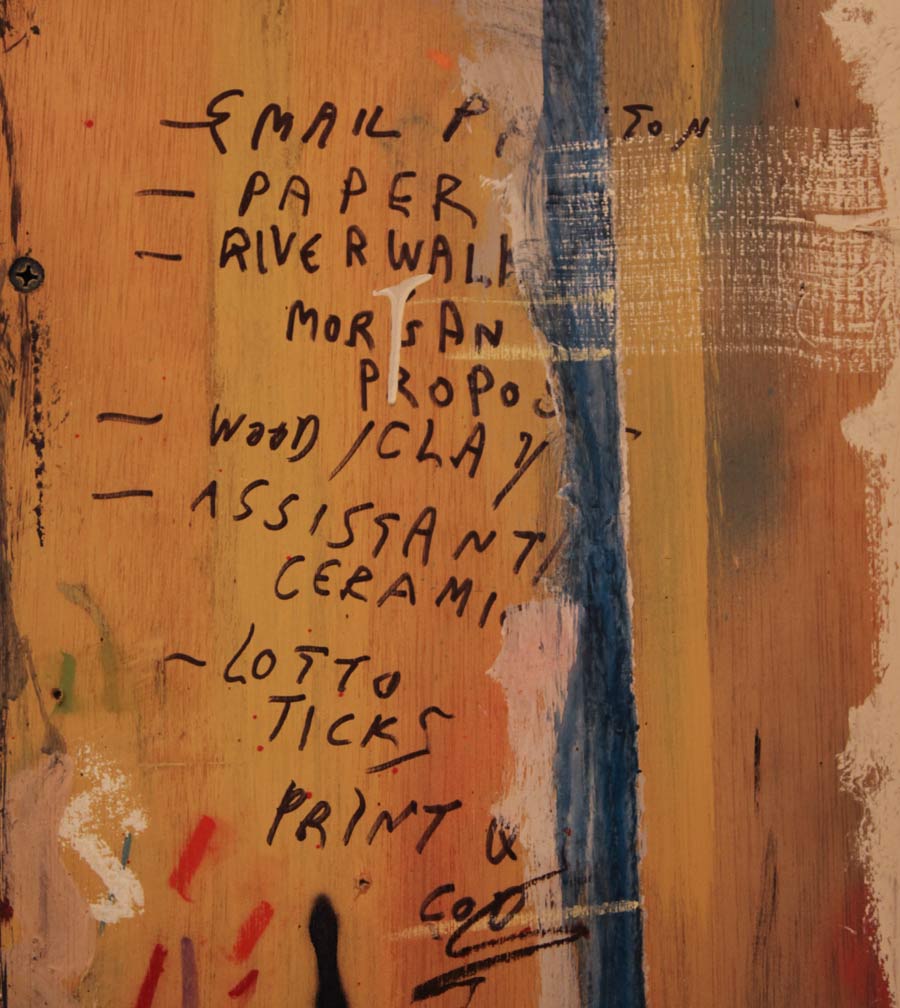
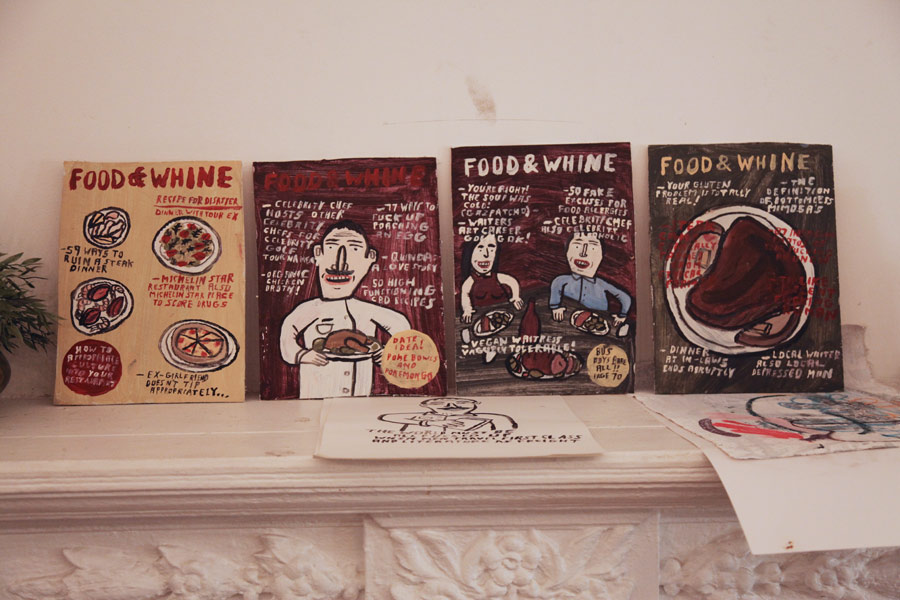
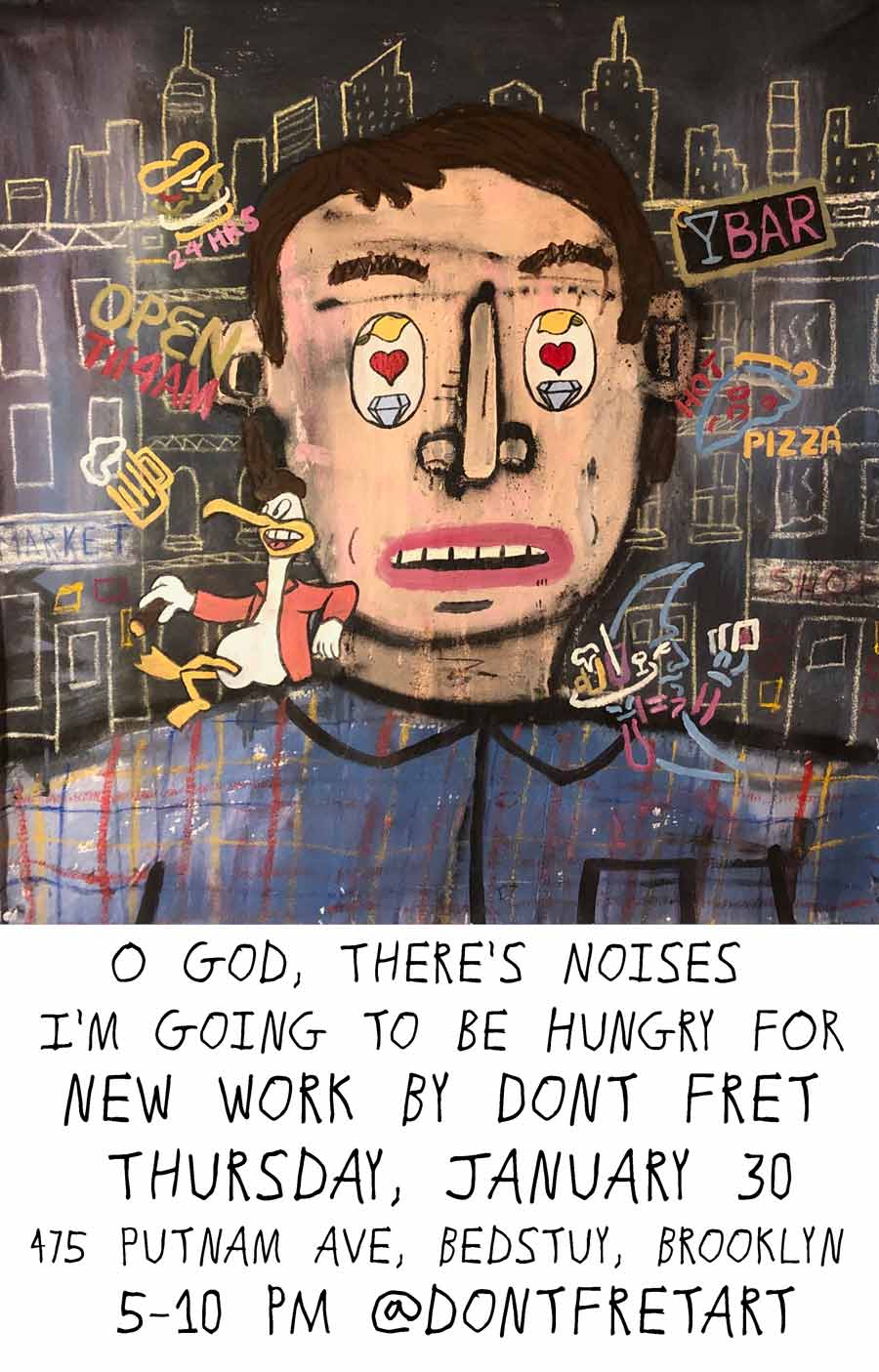
 BROOKLYN STREET ART LOVES YOU MORE EVERY DAY
BROOKLYN STREET ART LOVES YOU MORE EVERY DAY